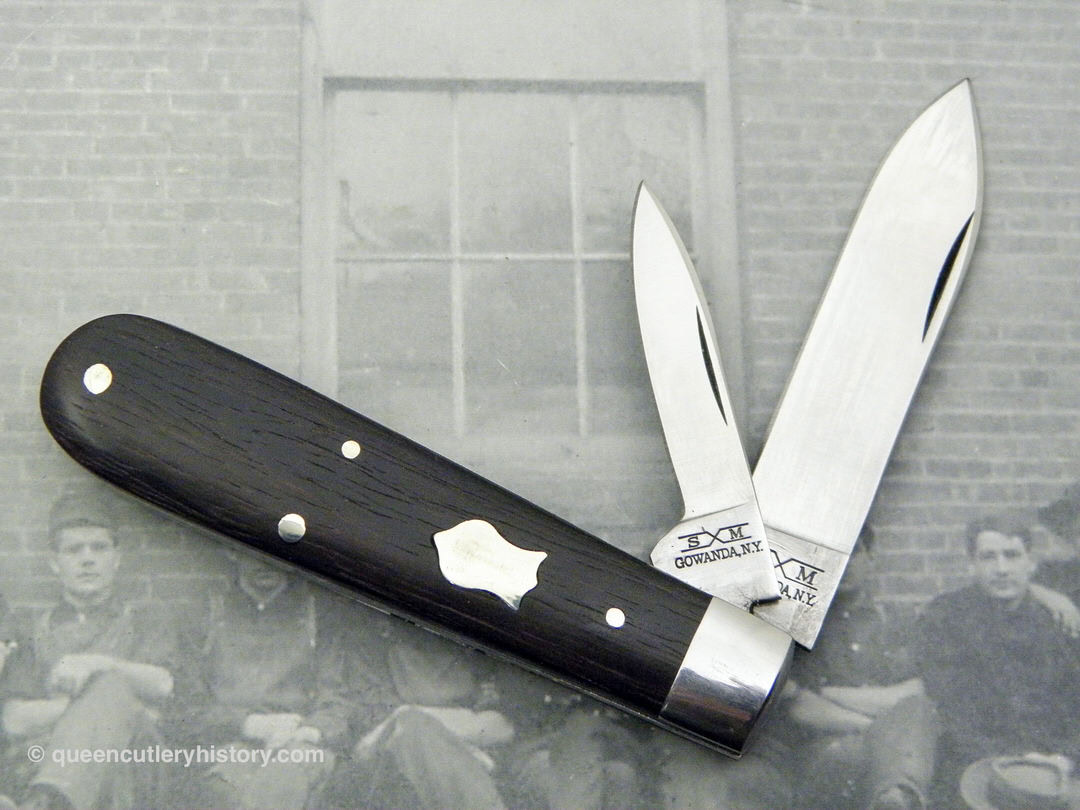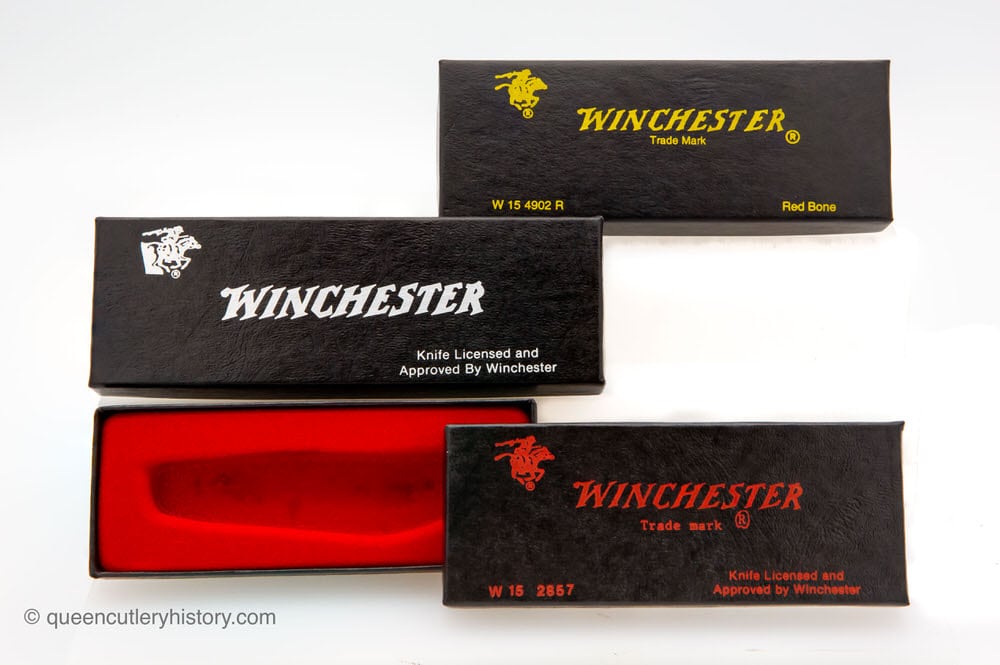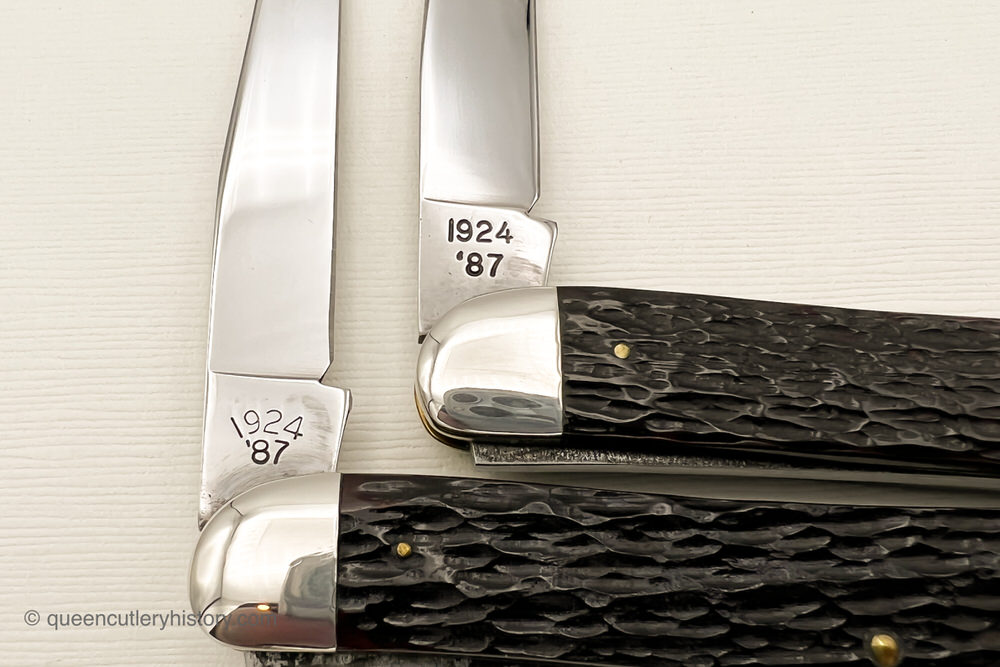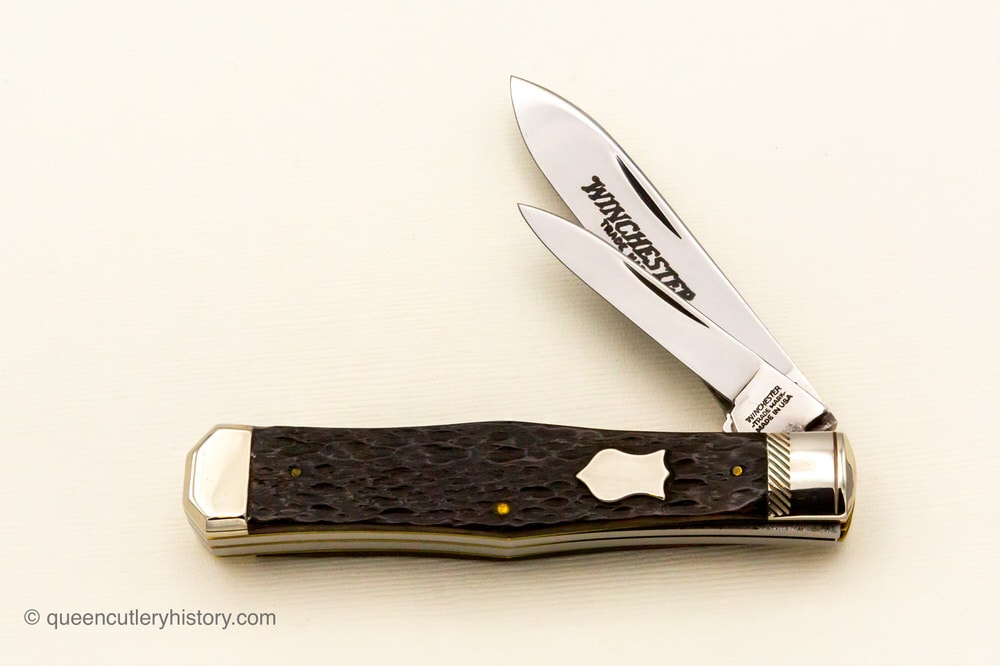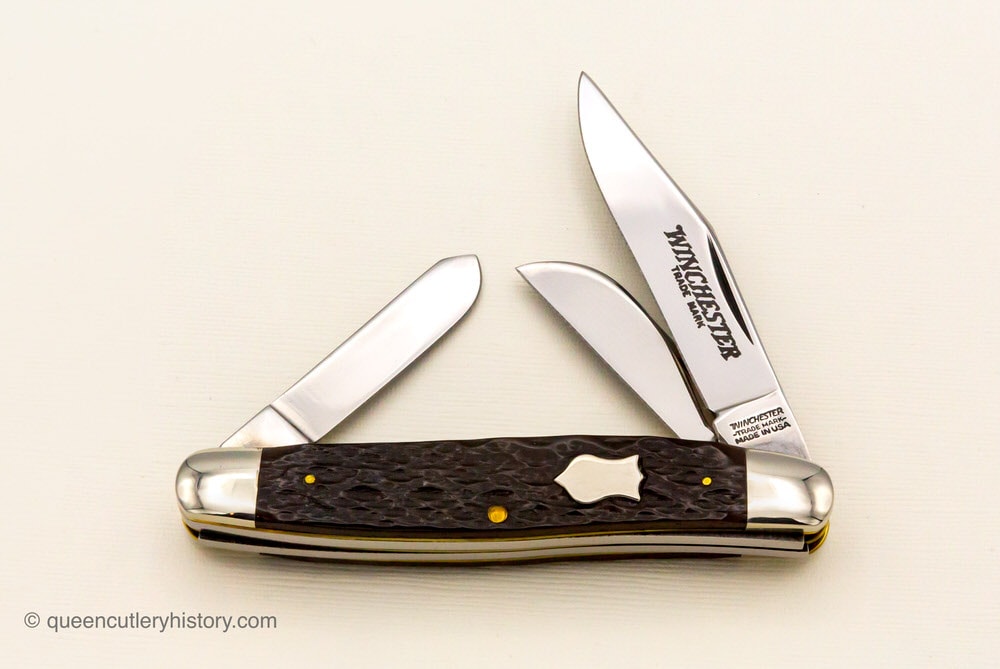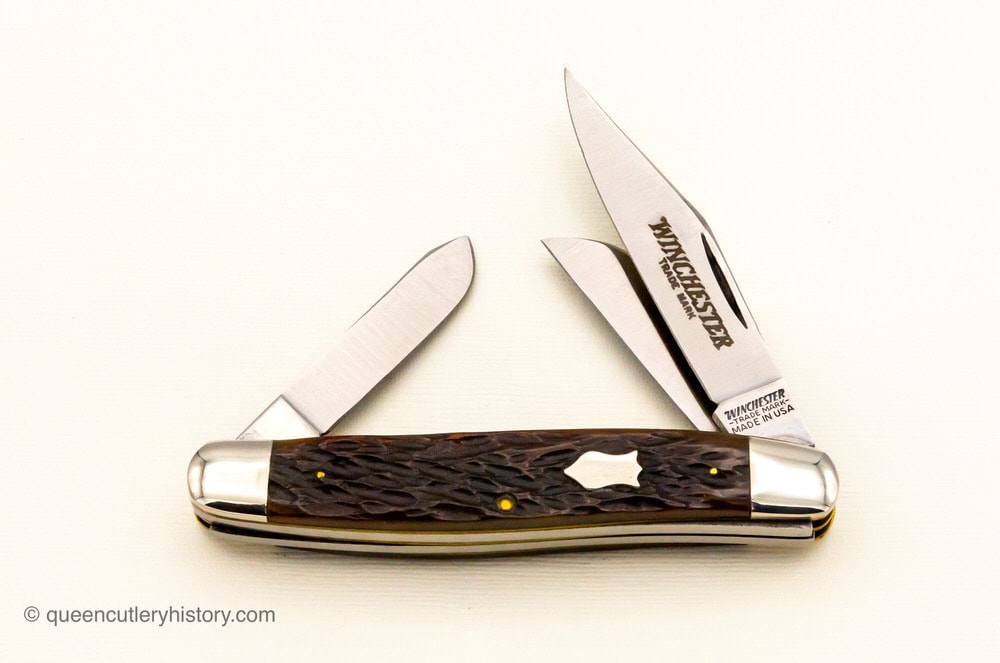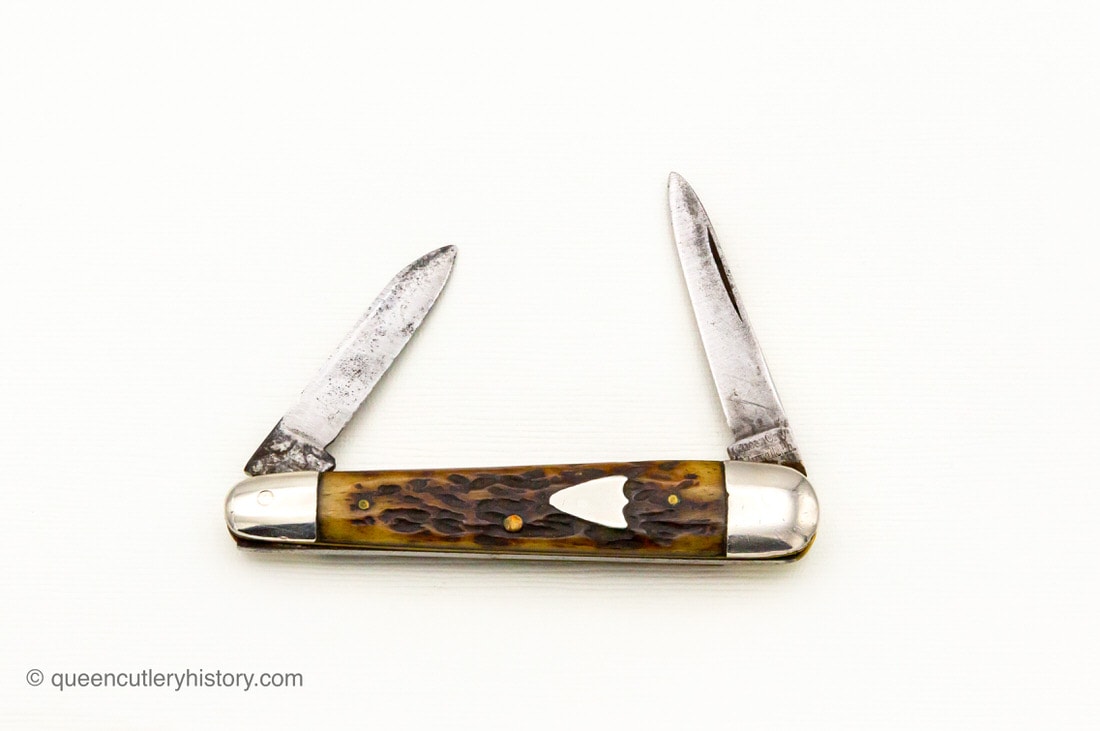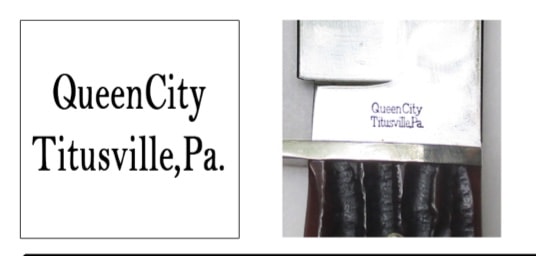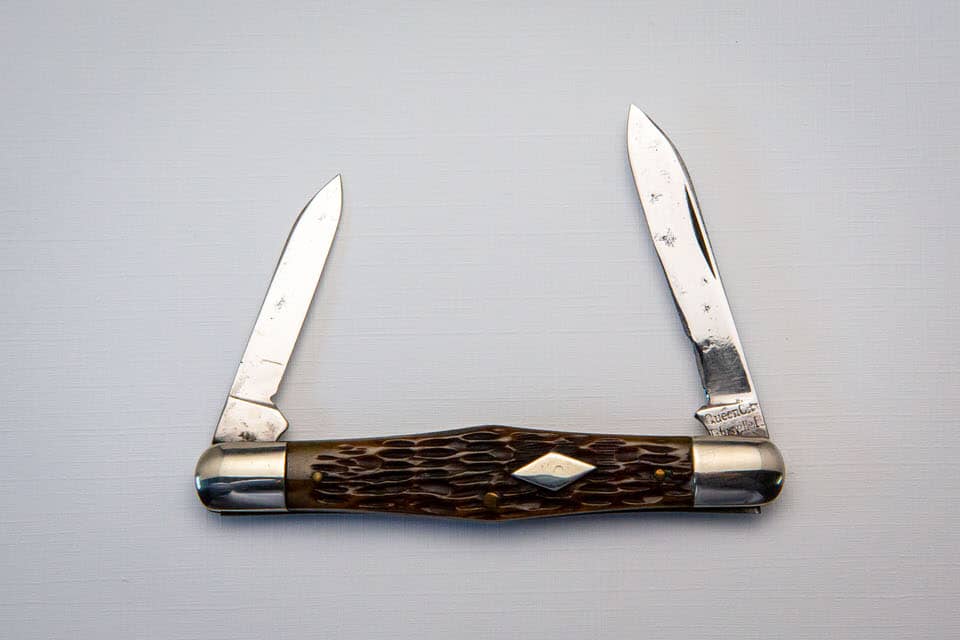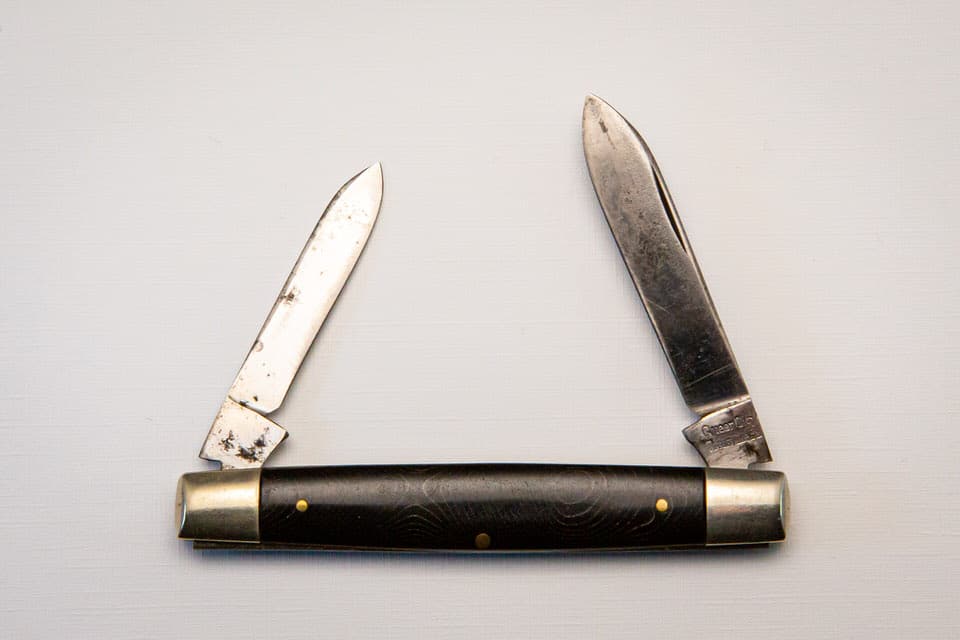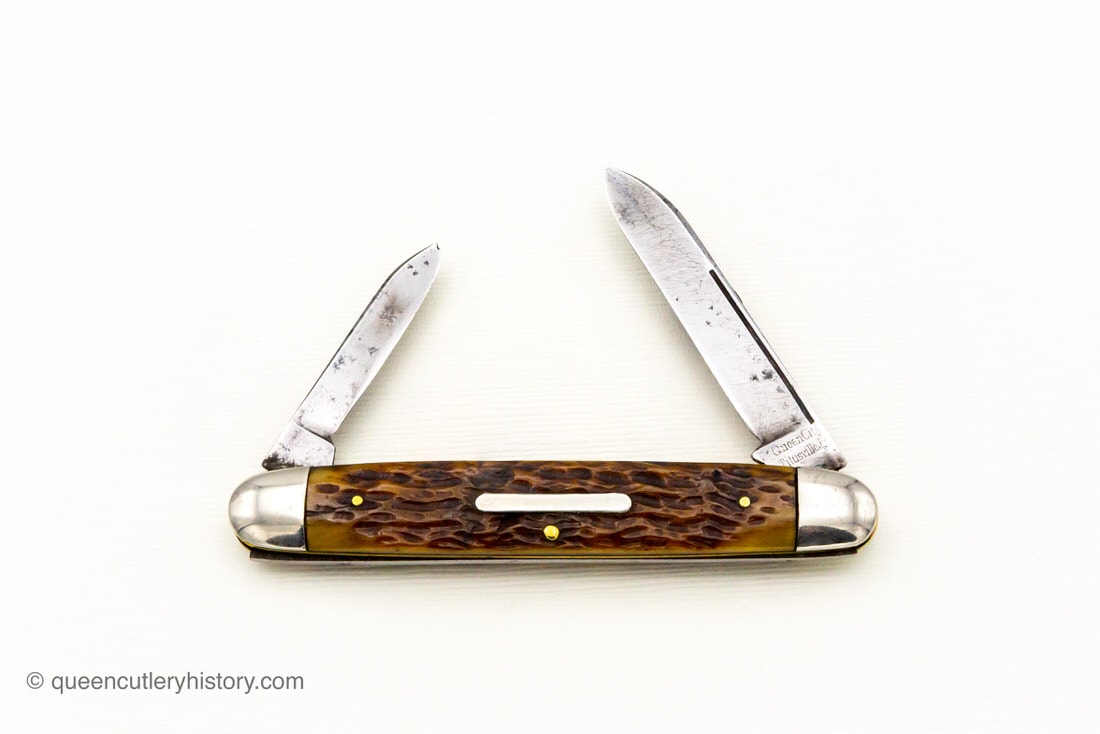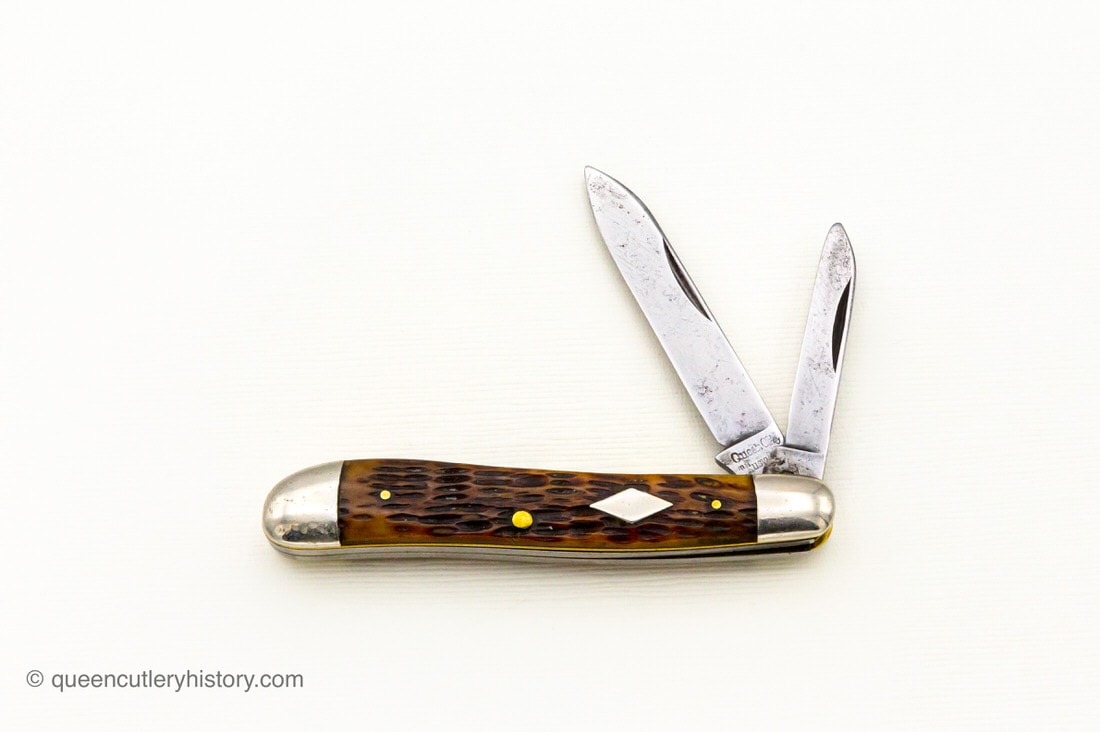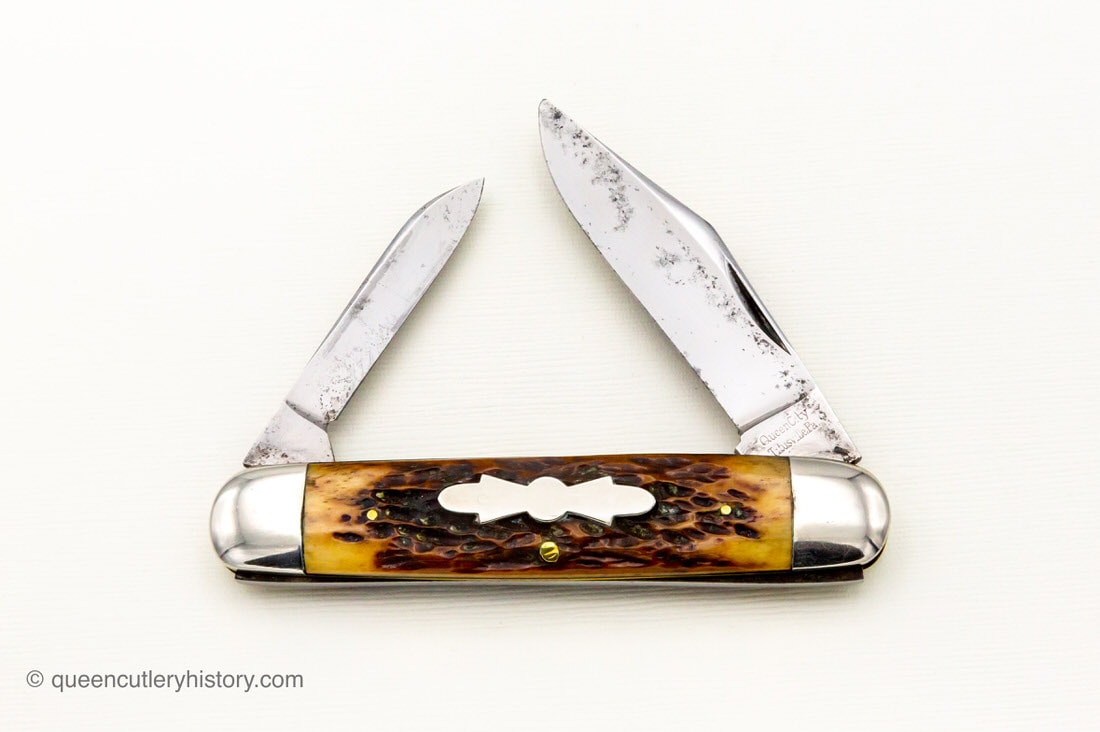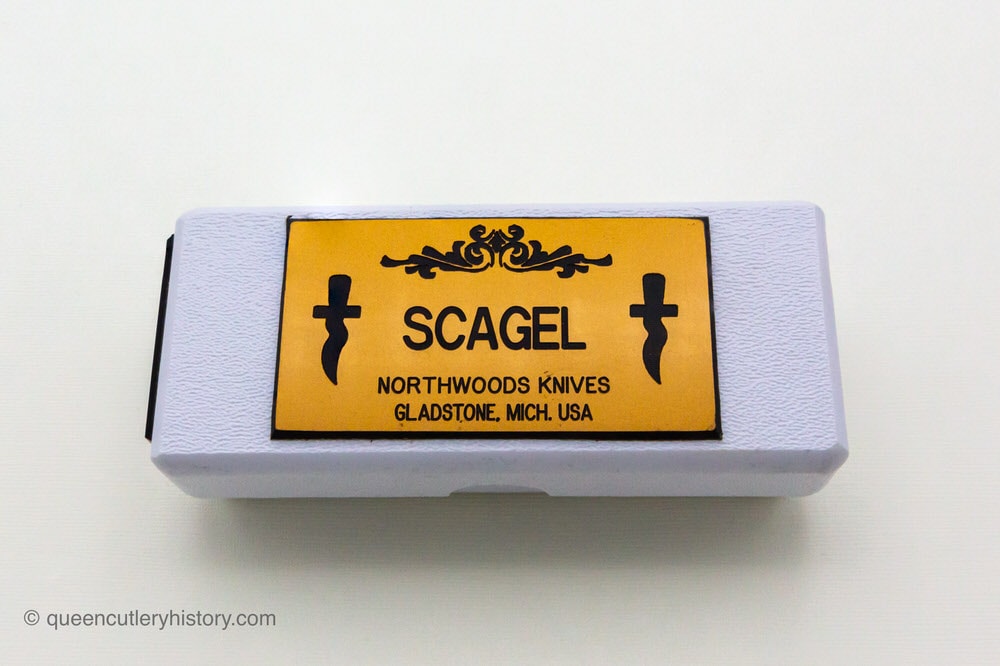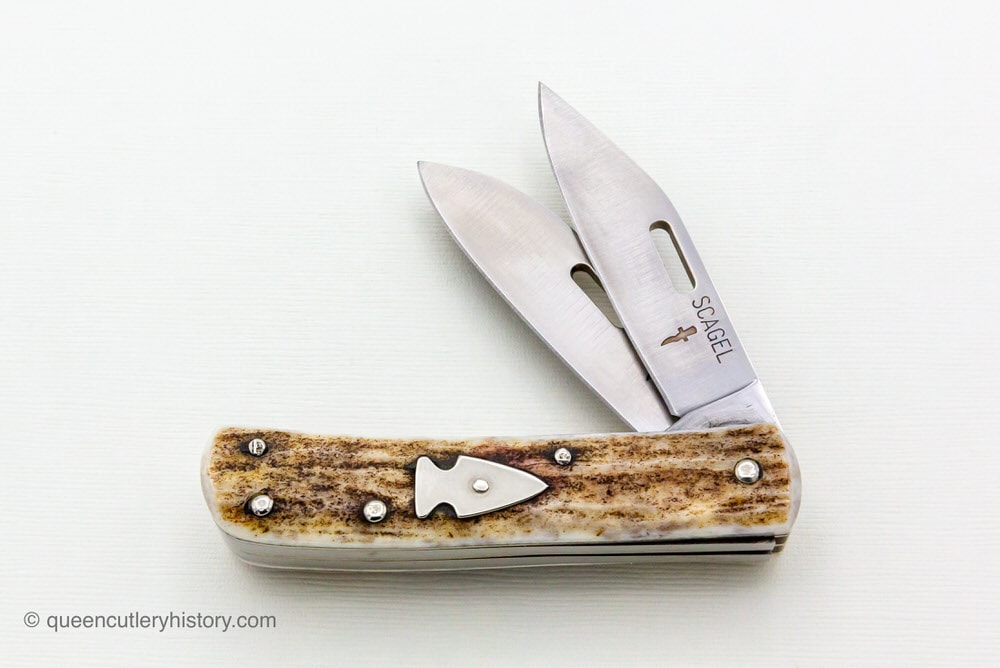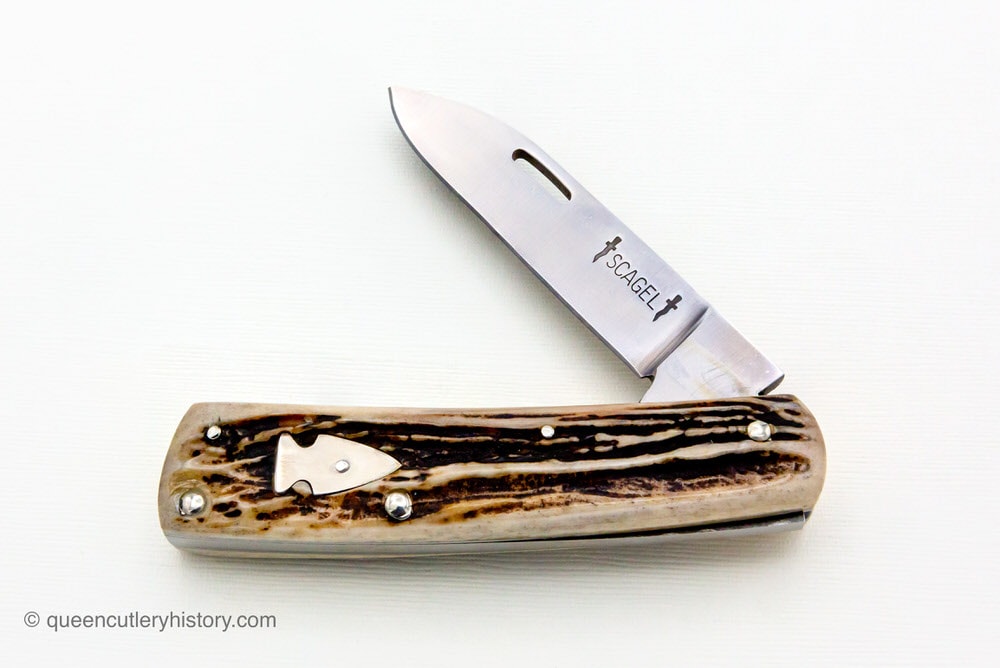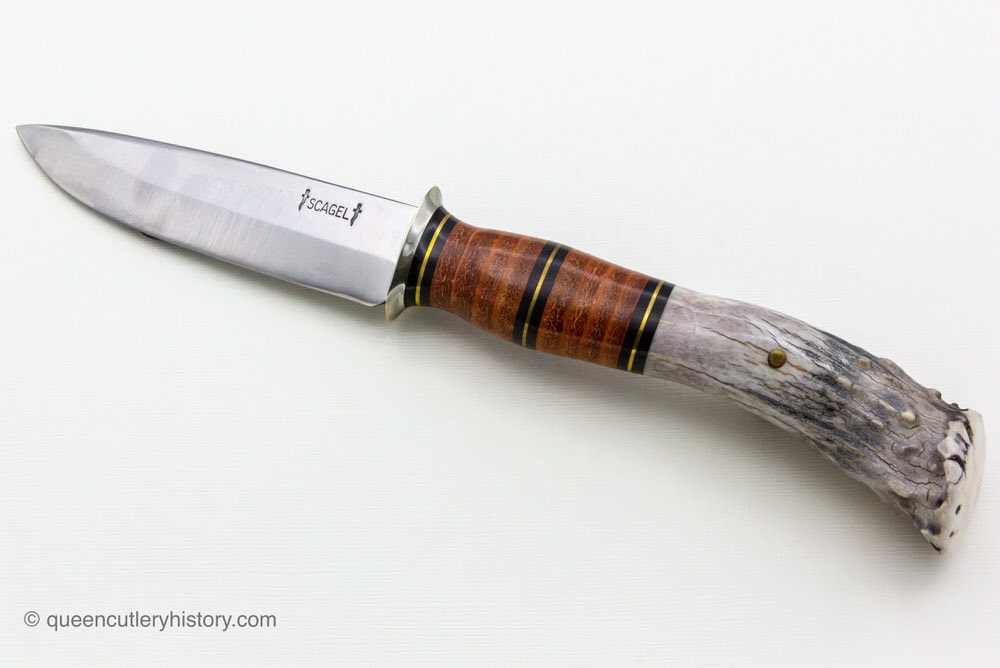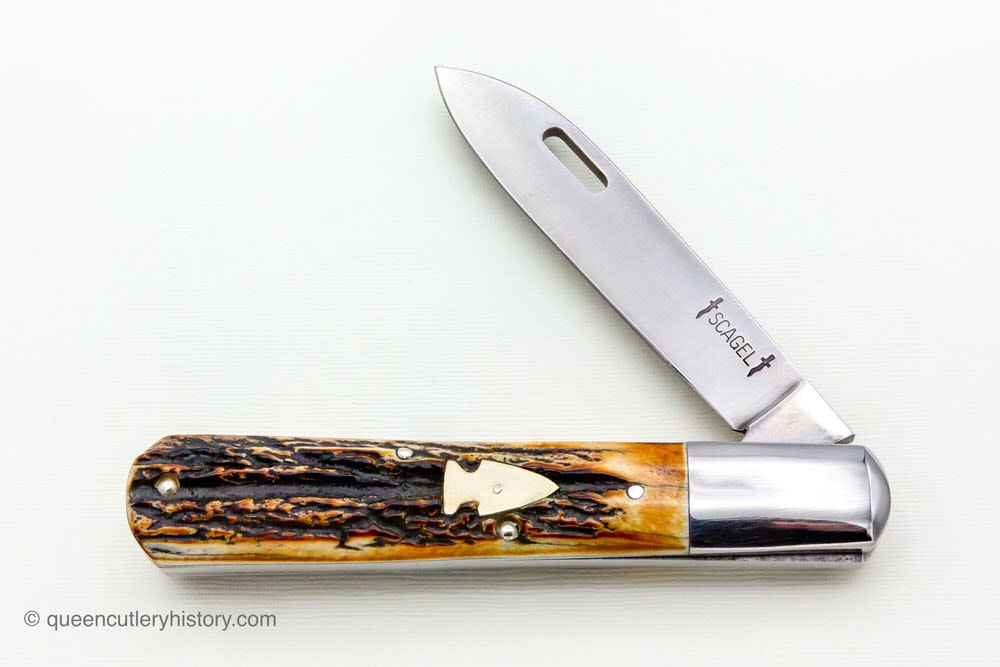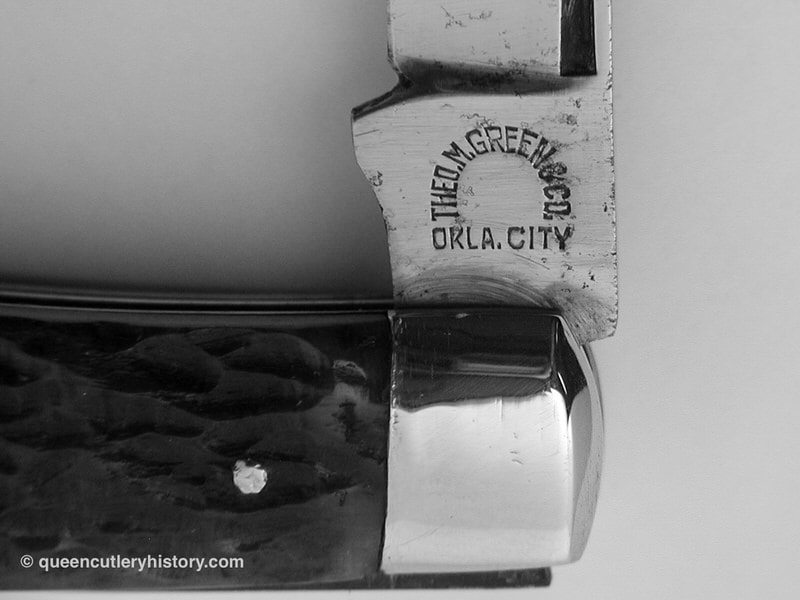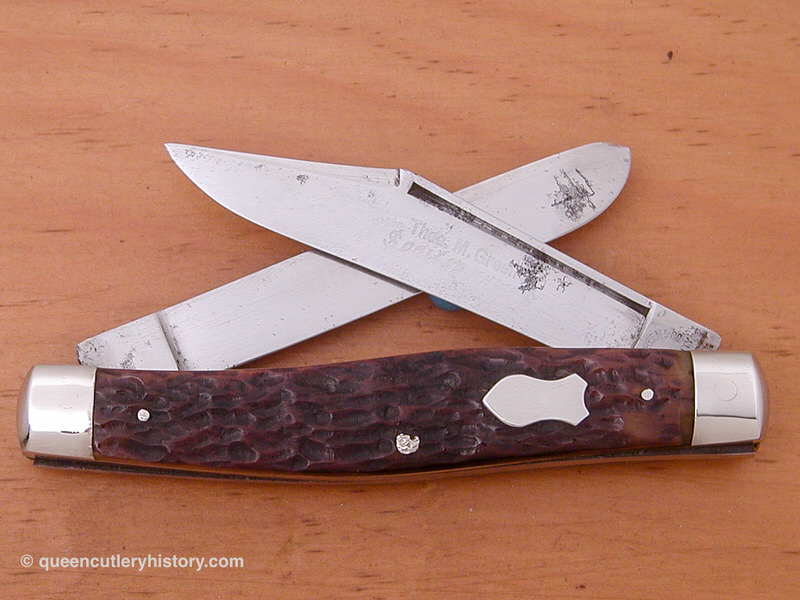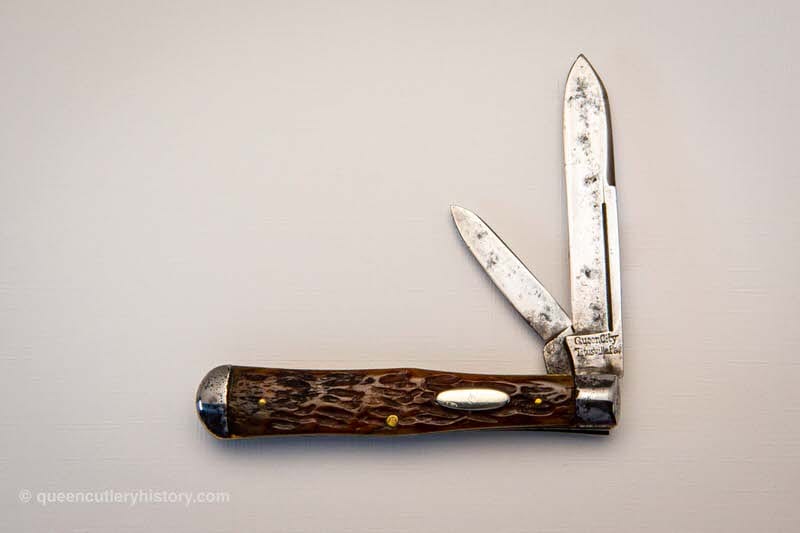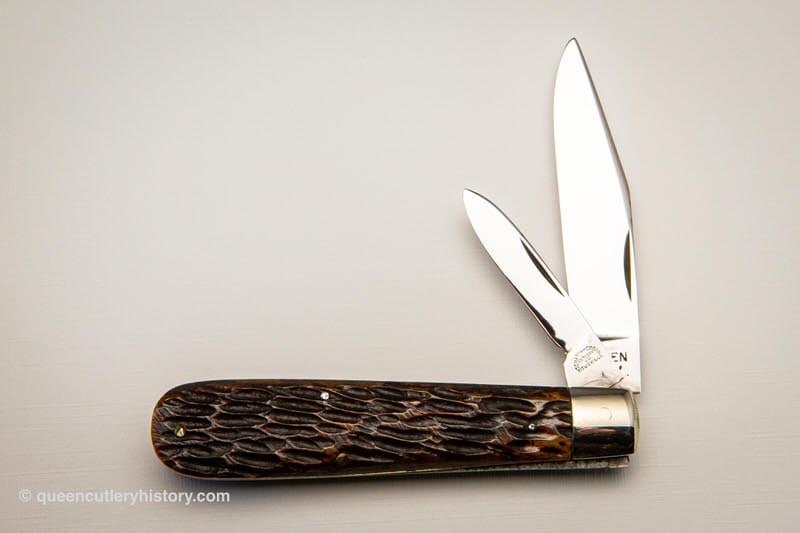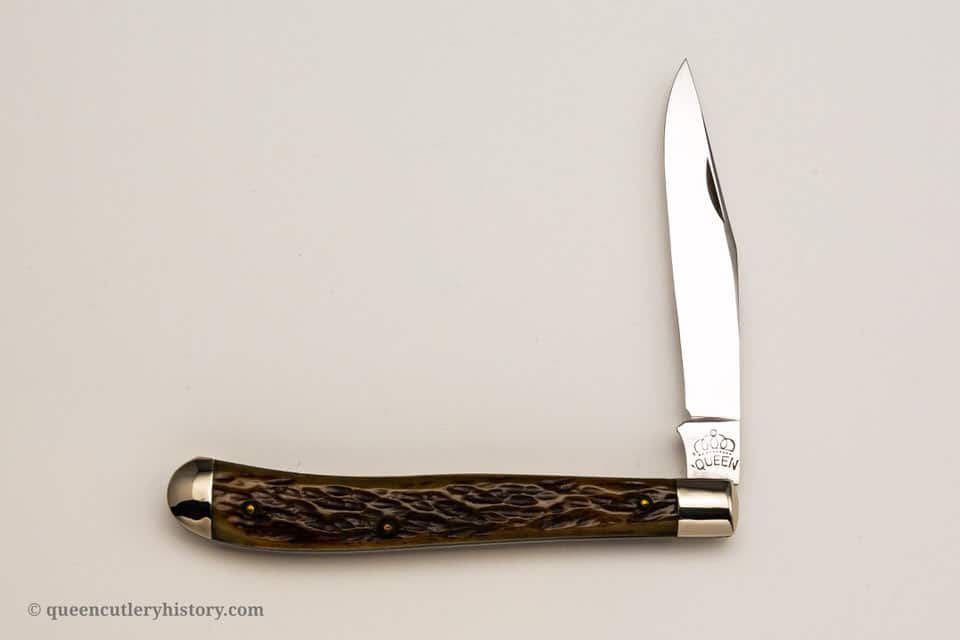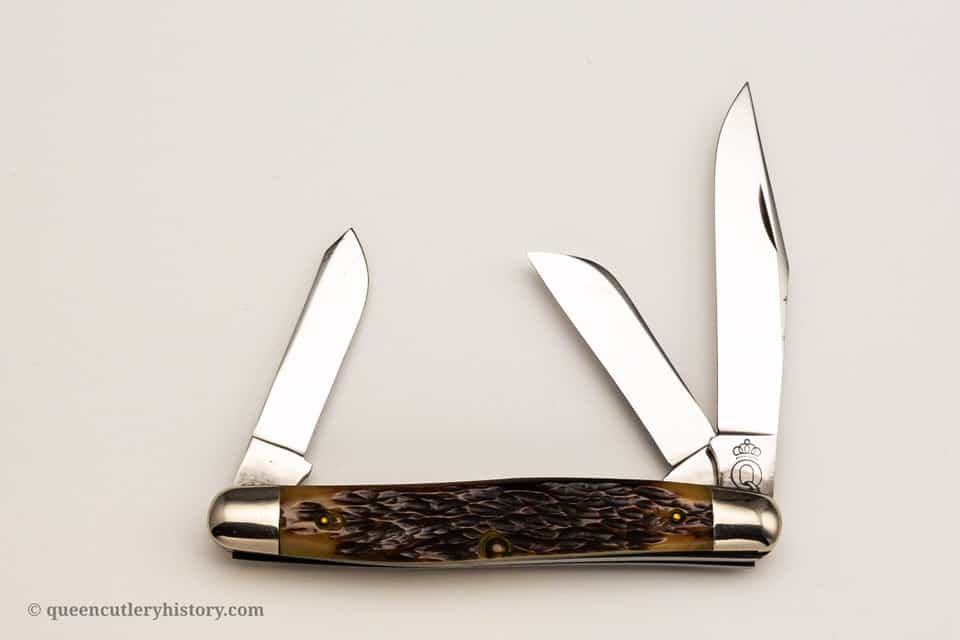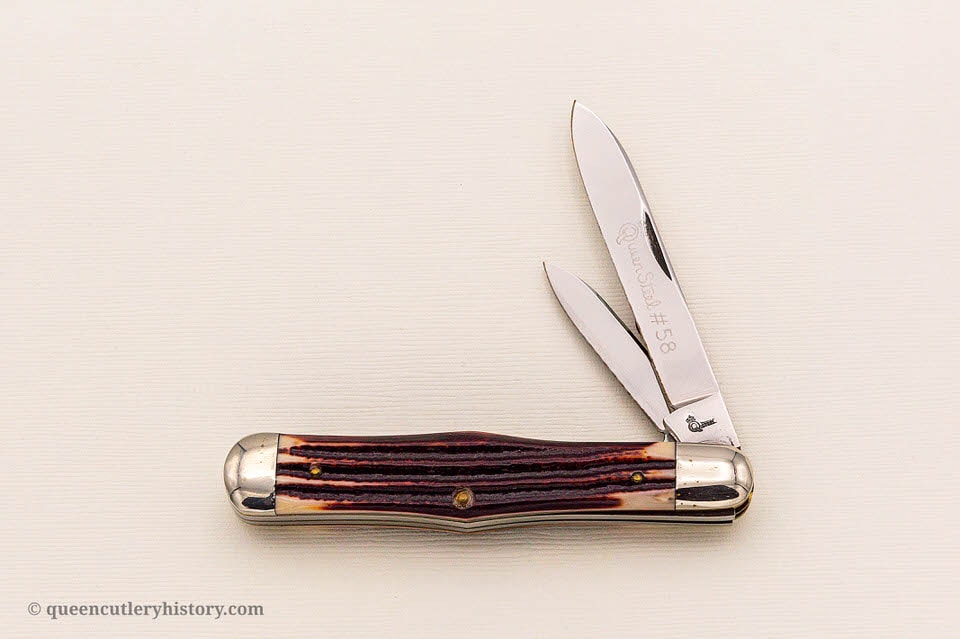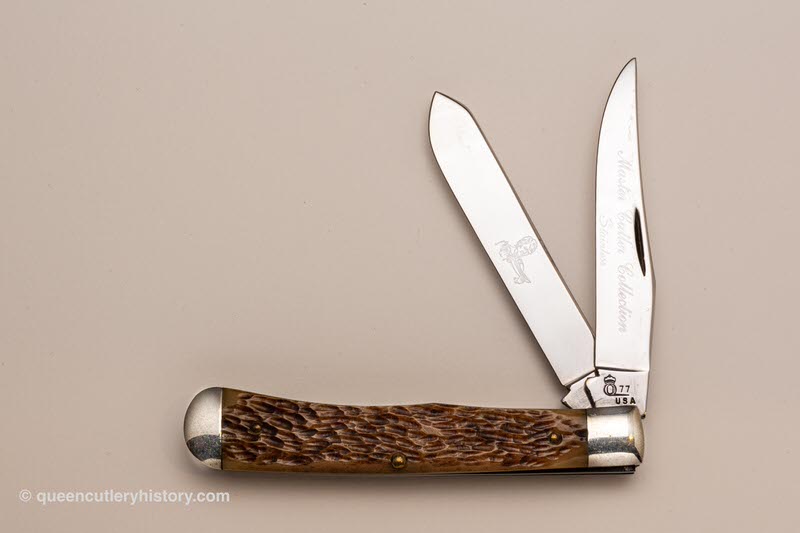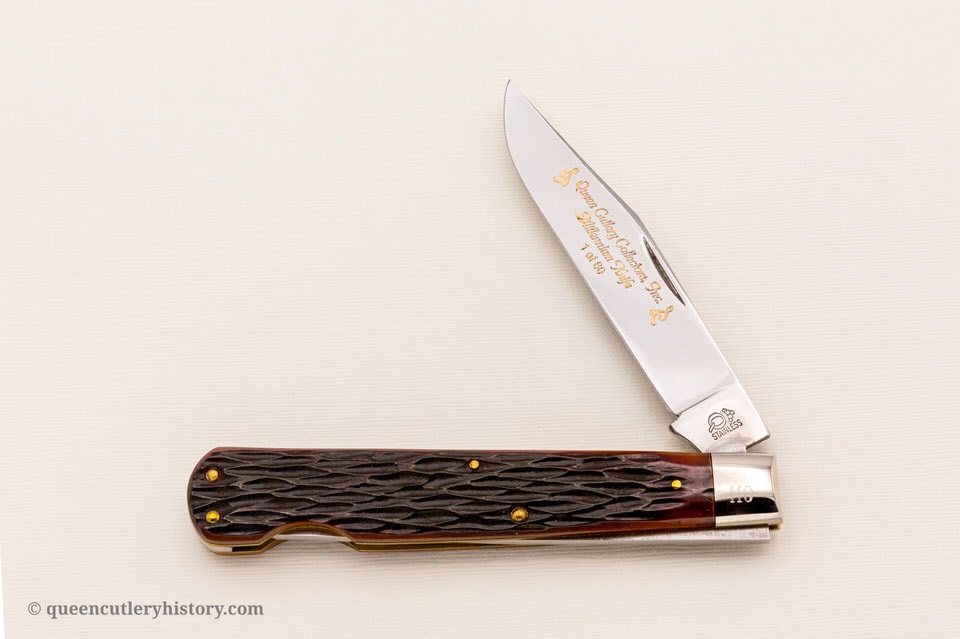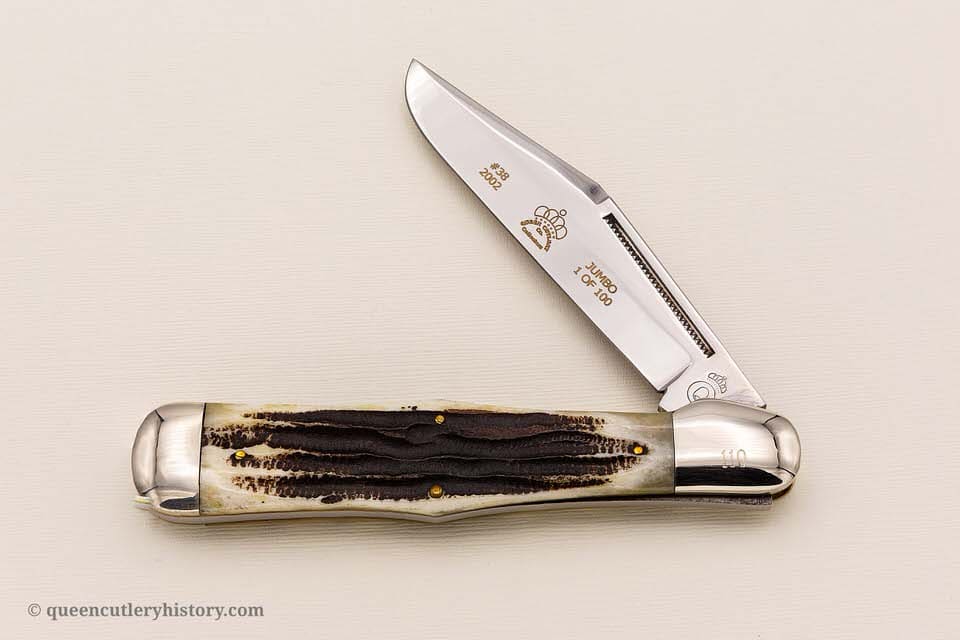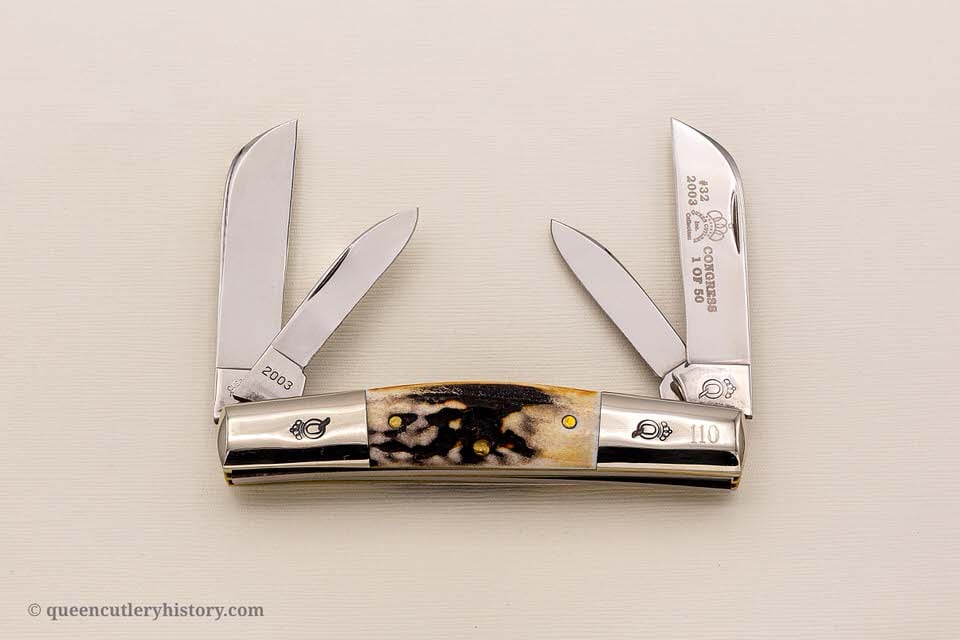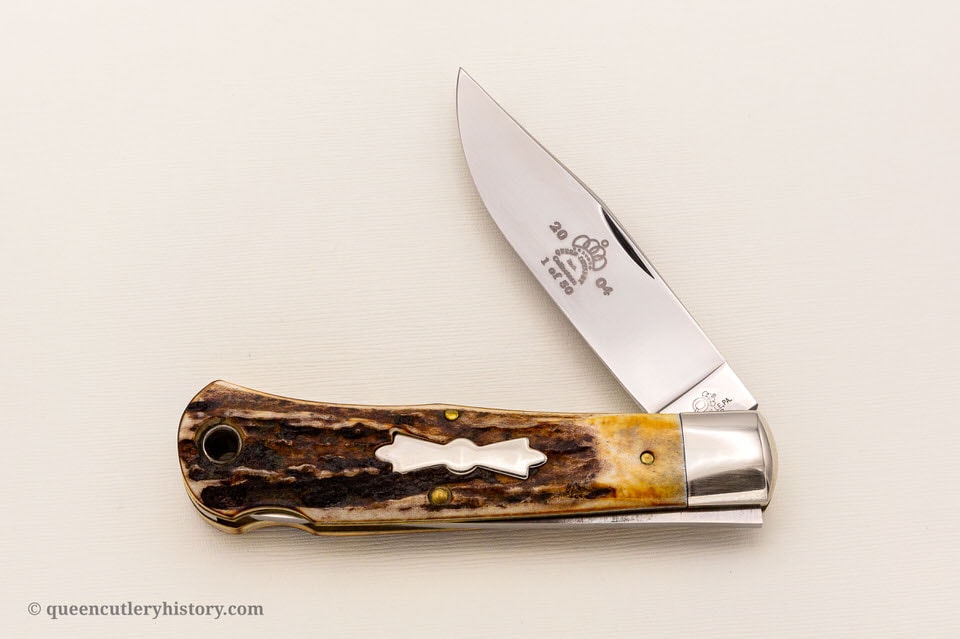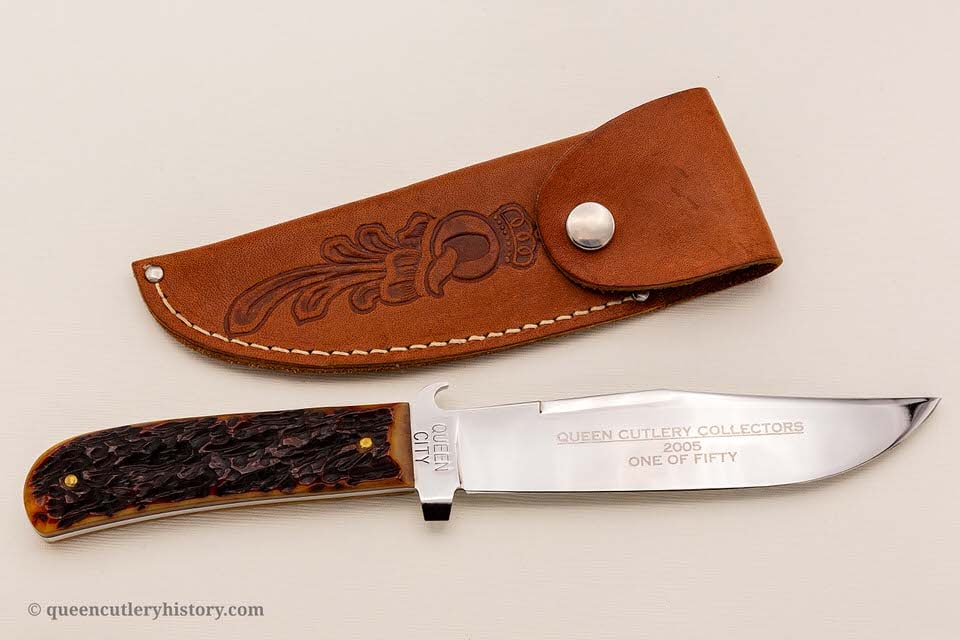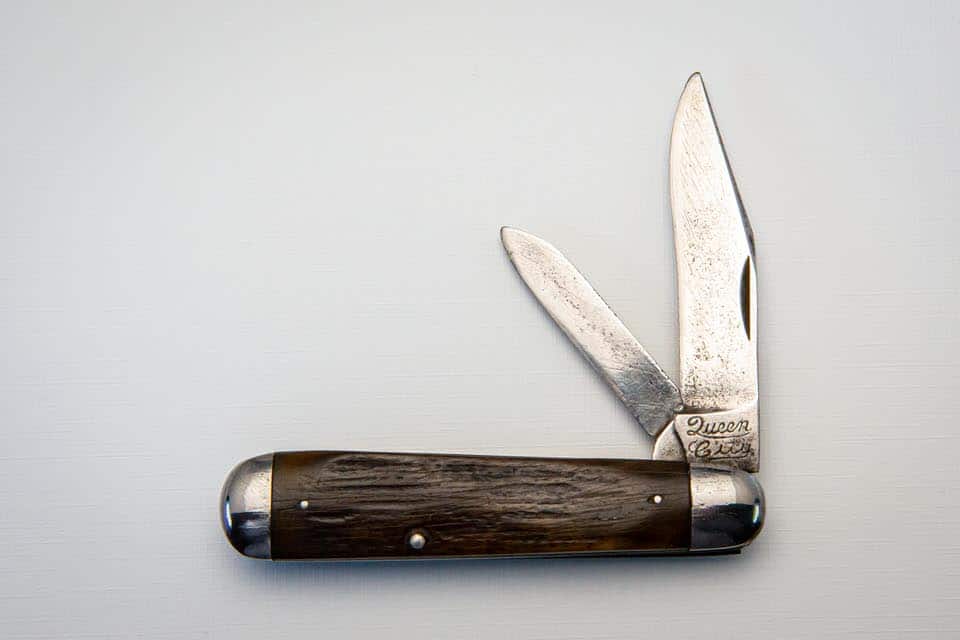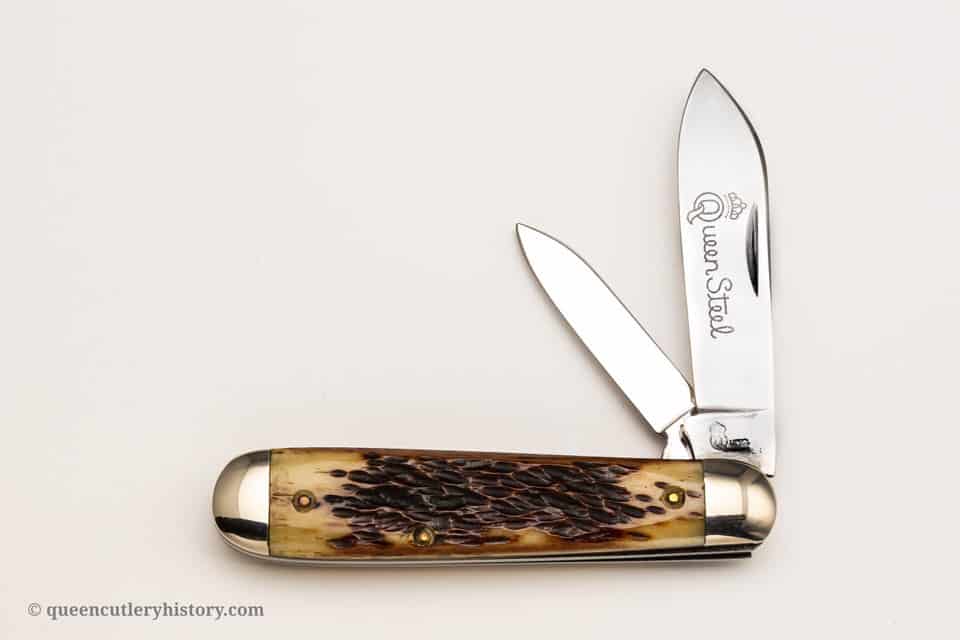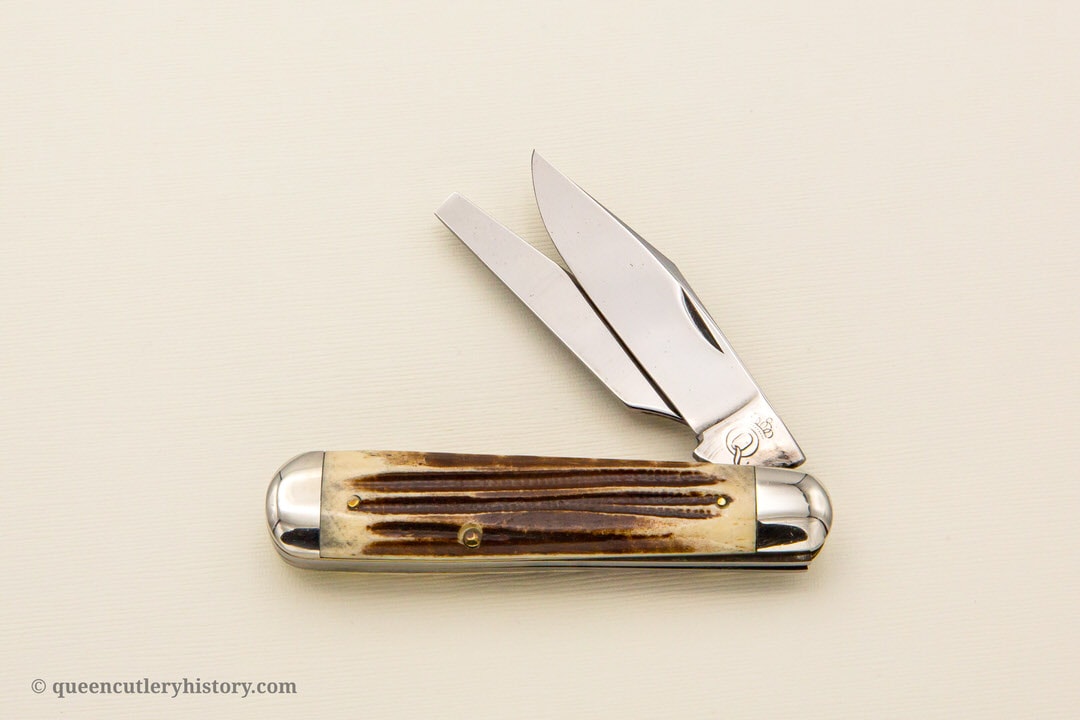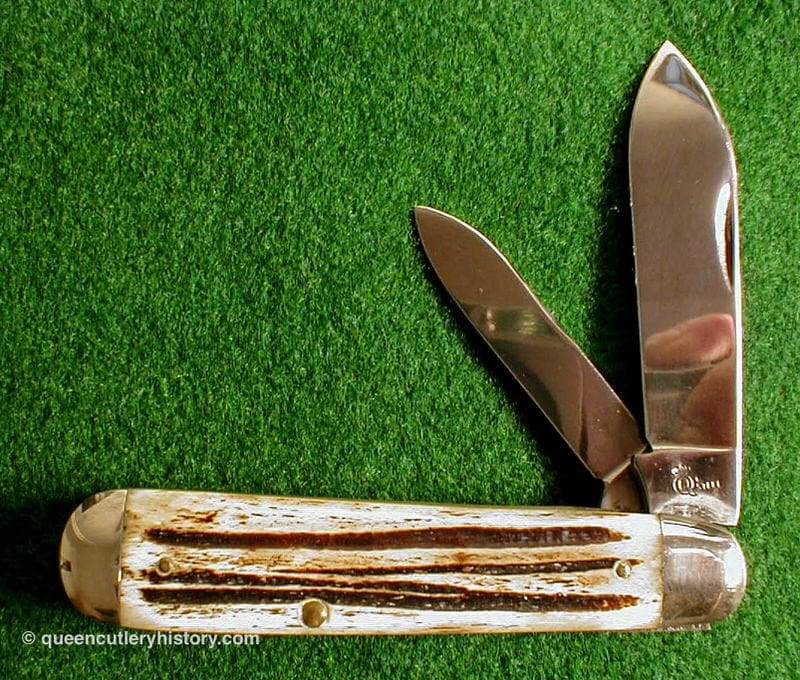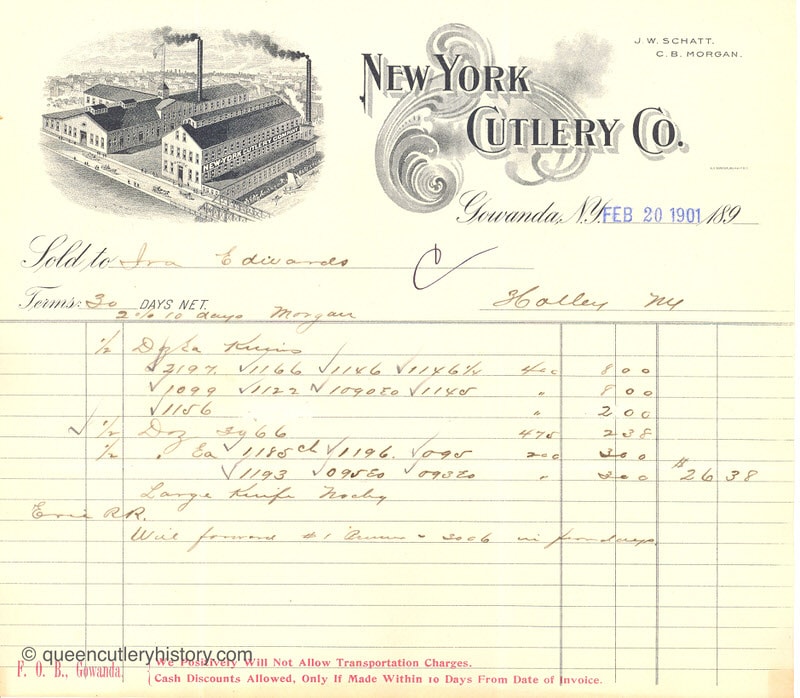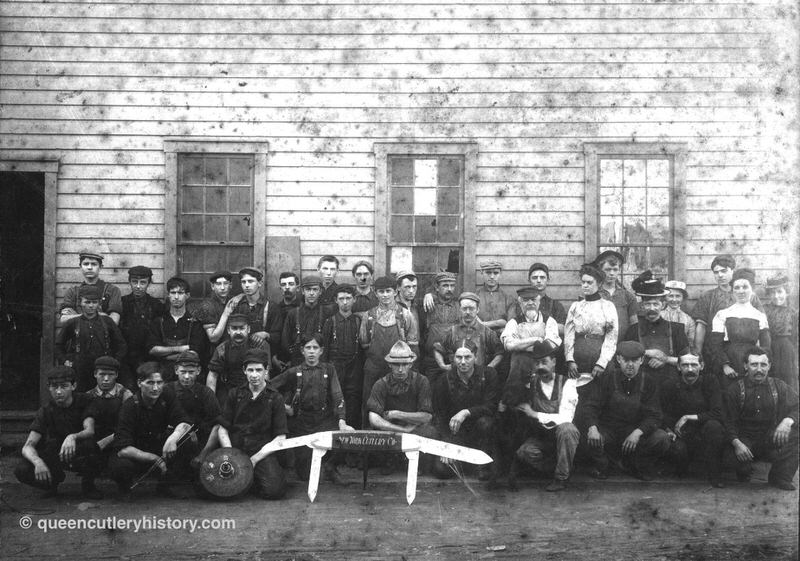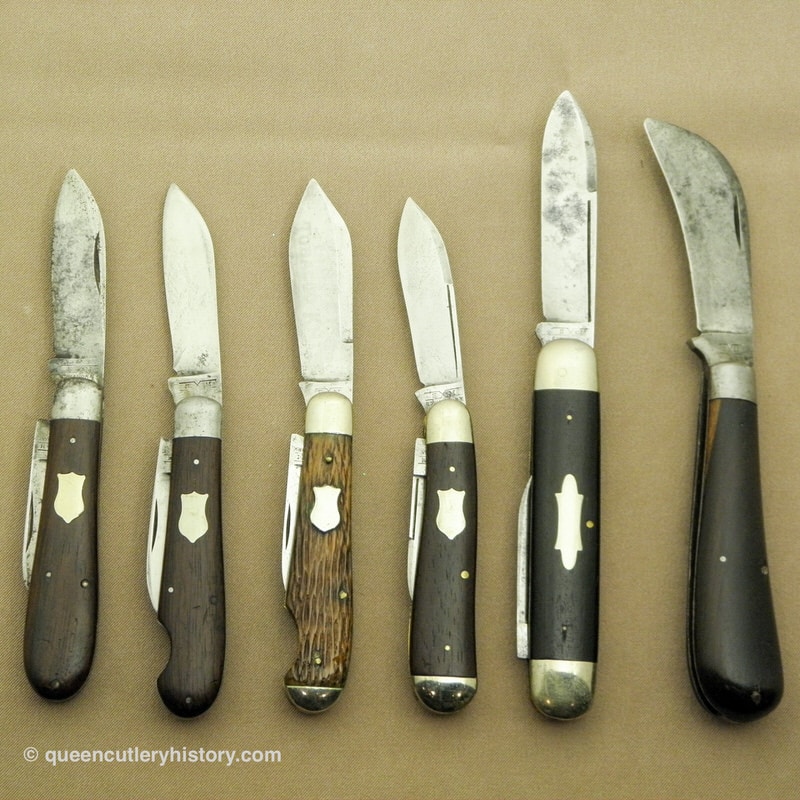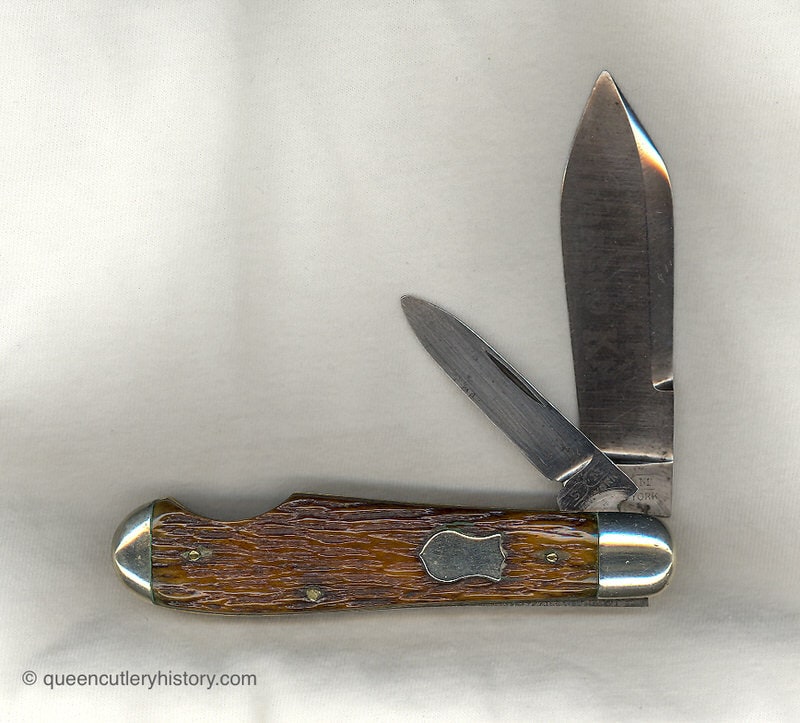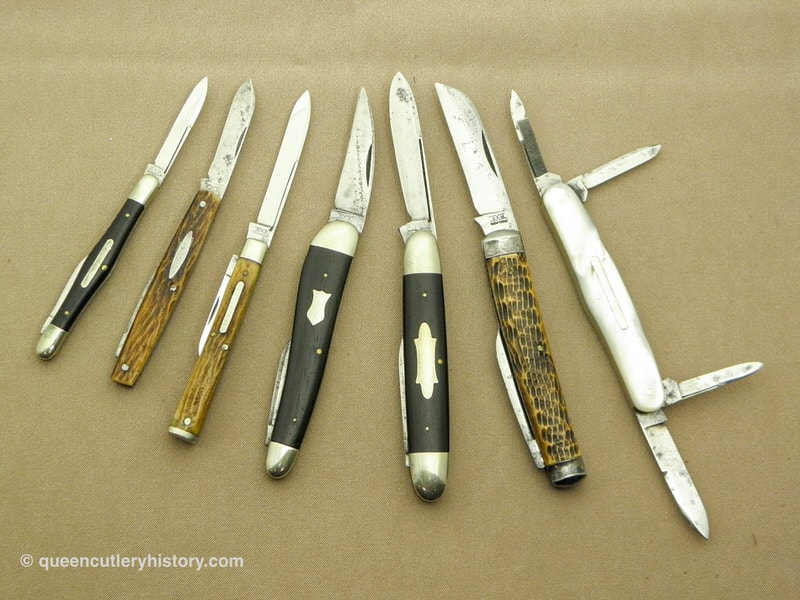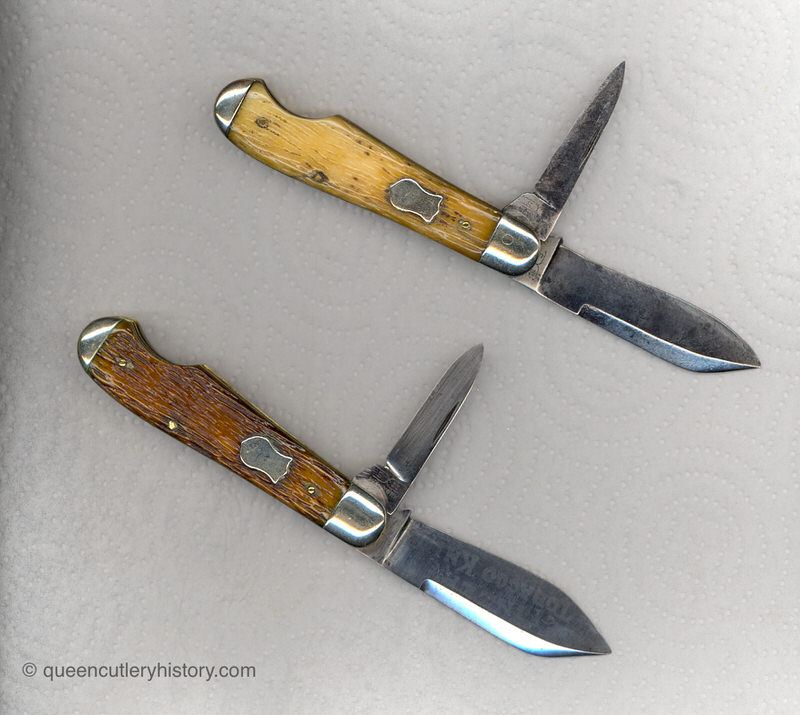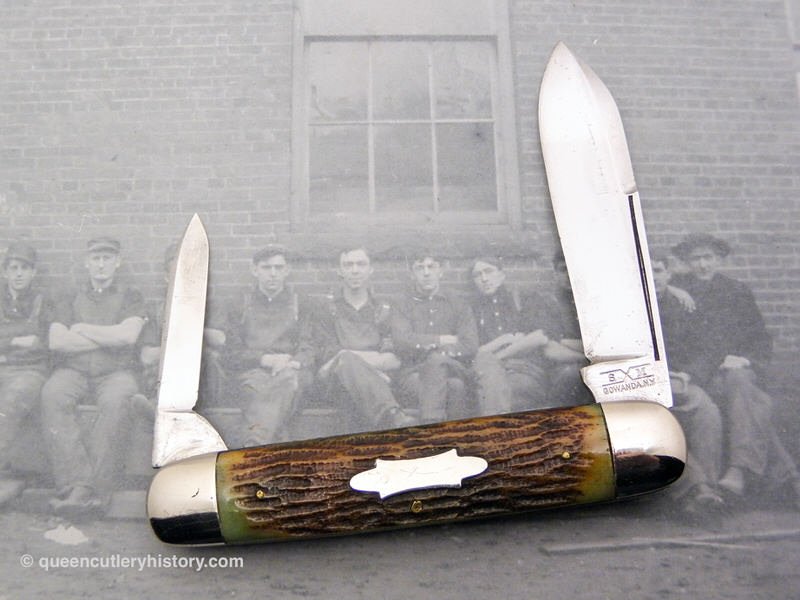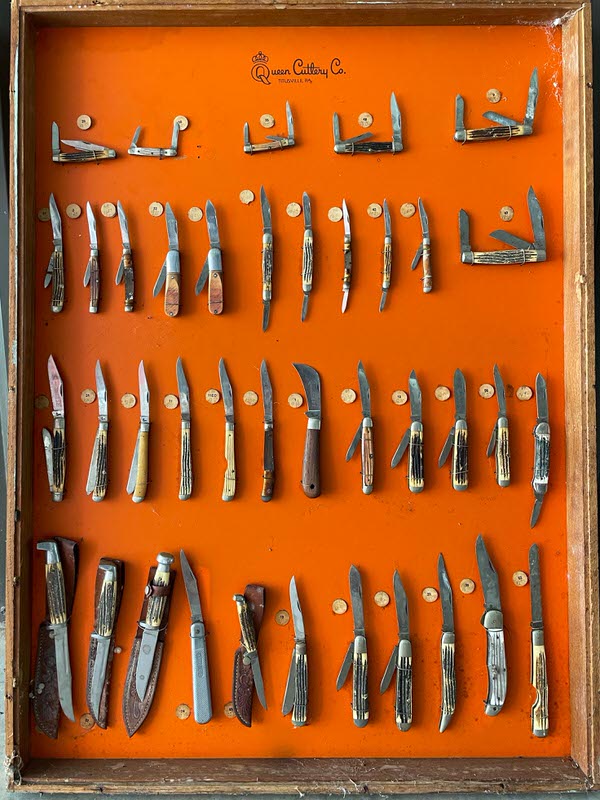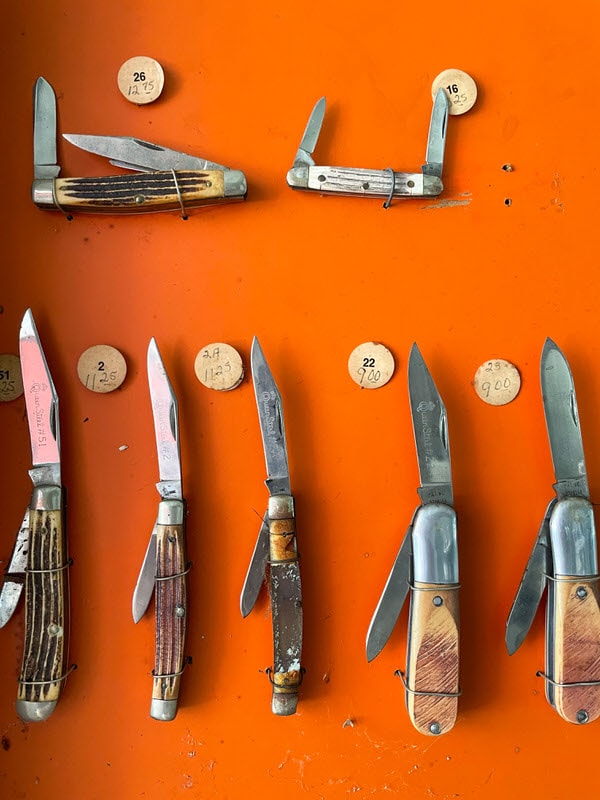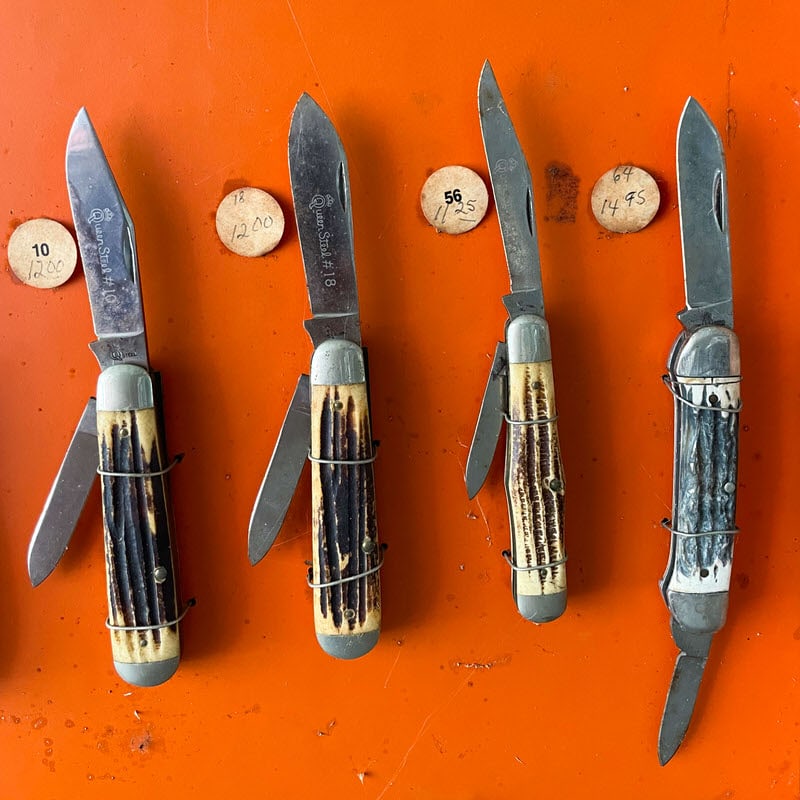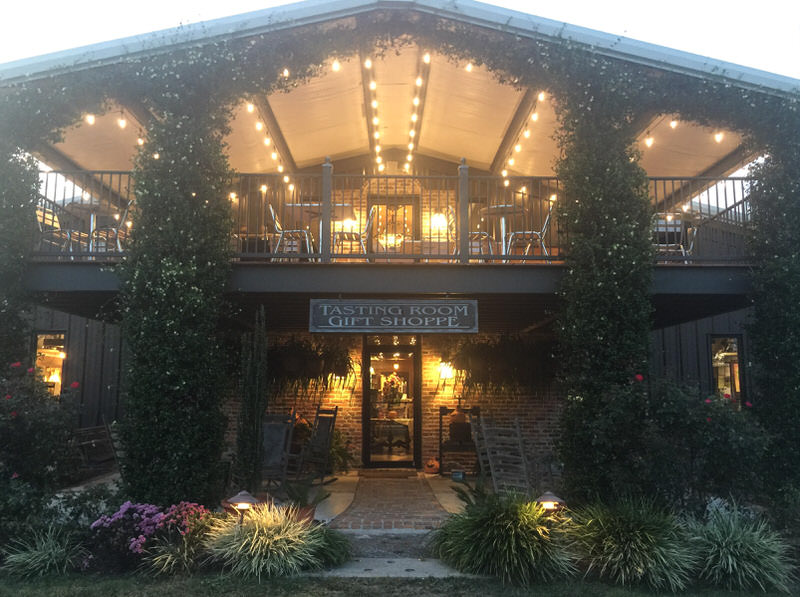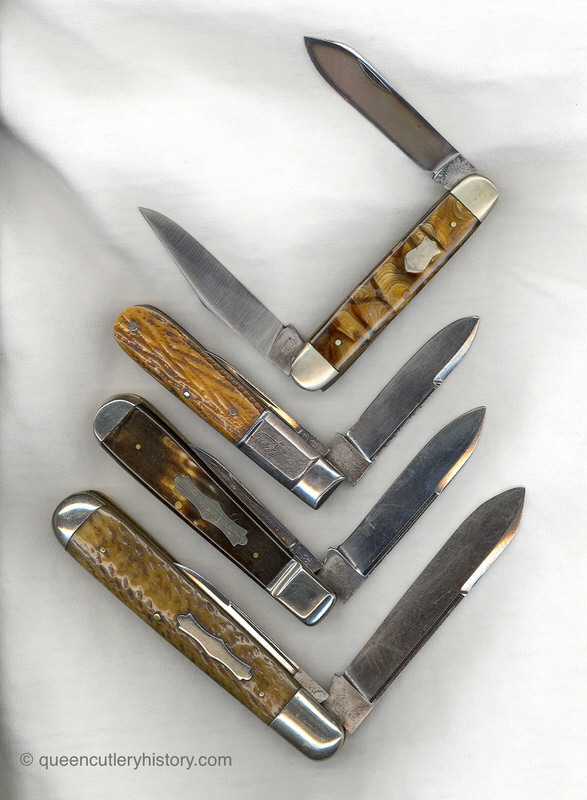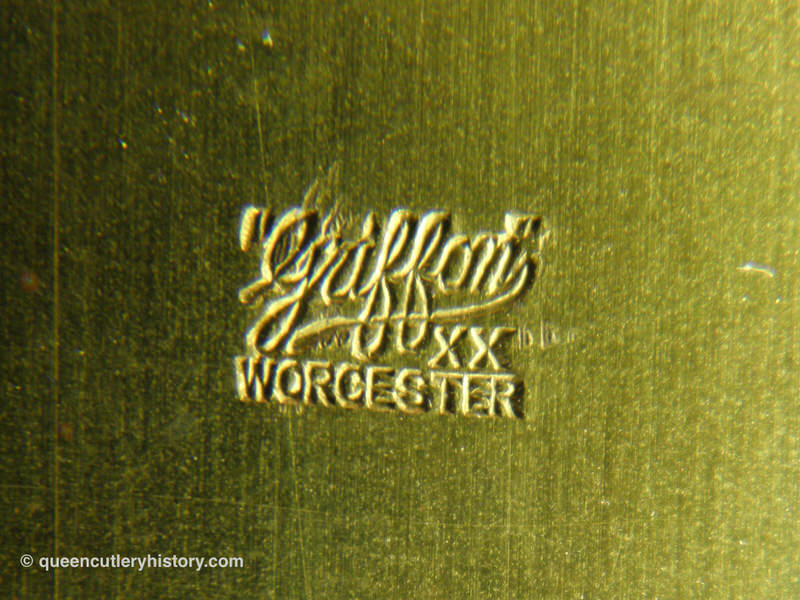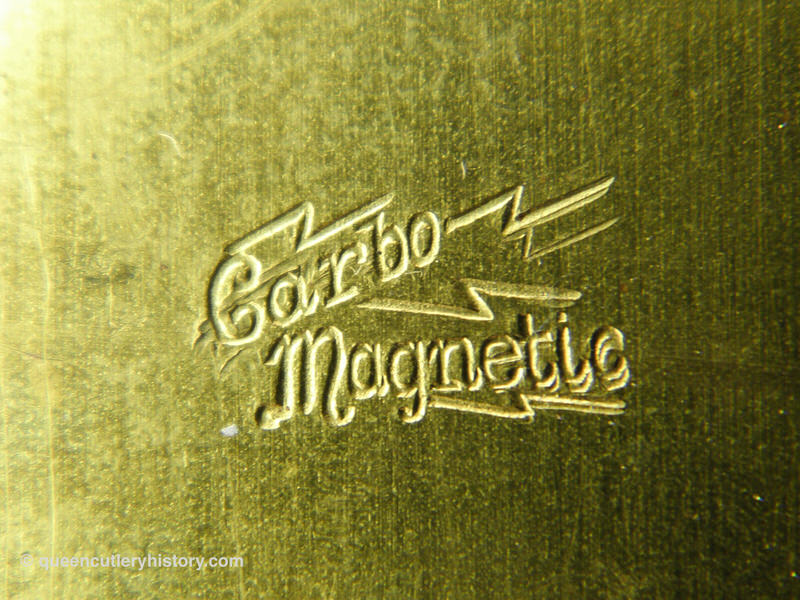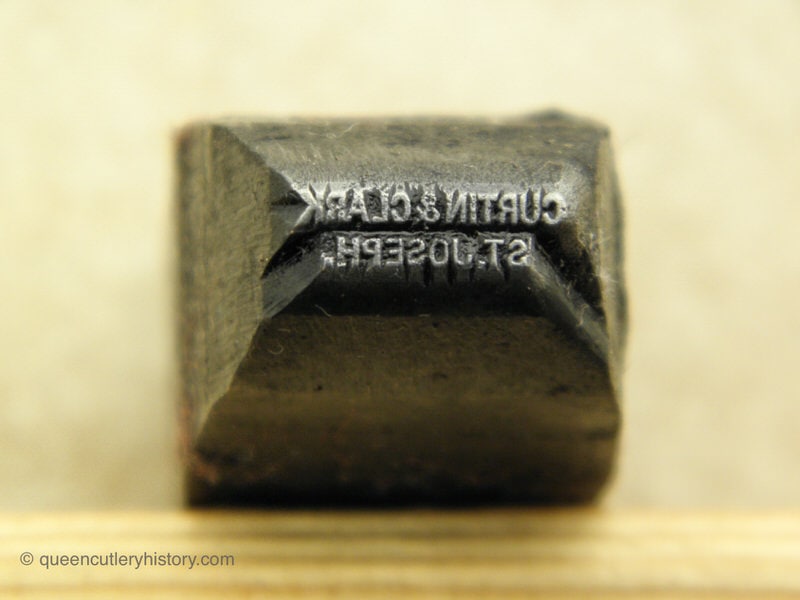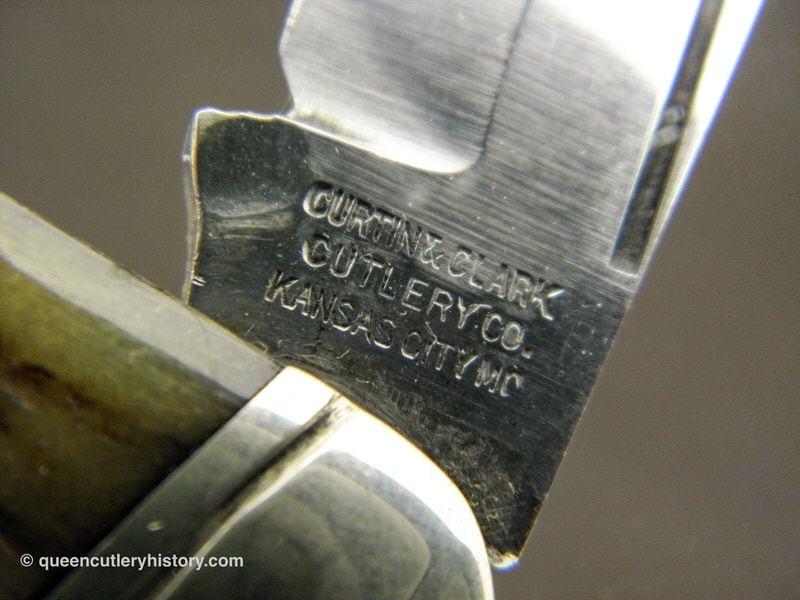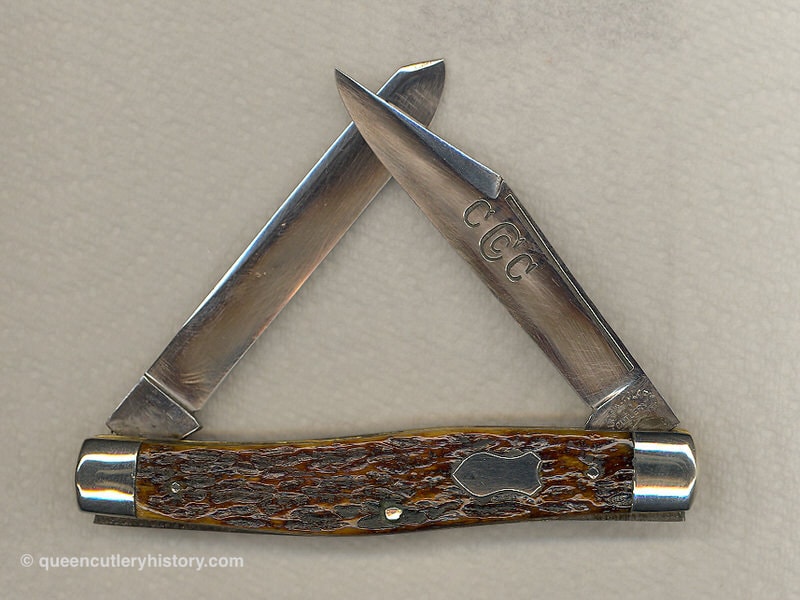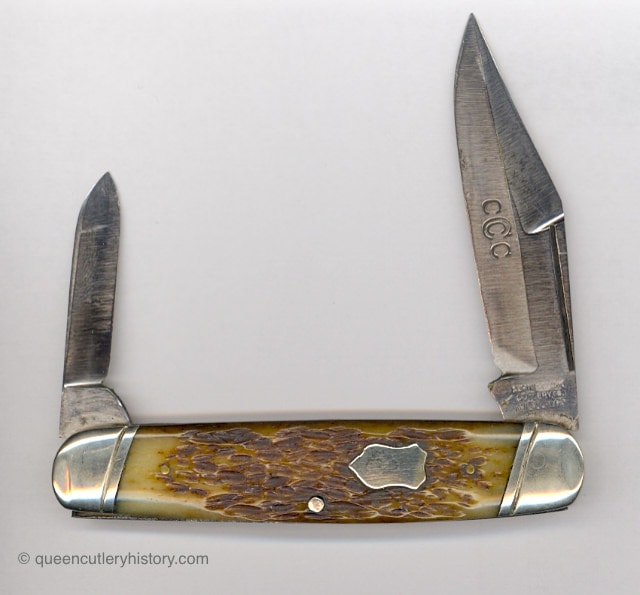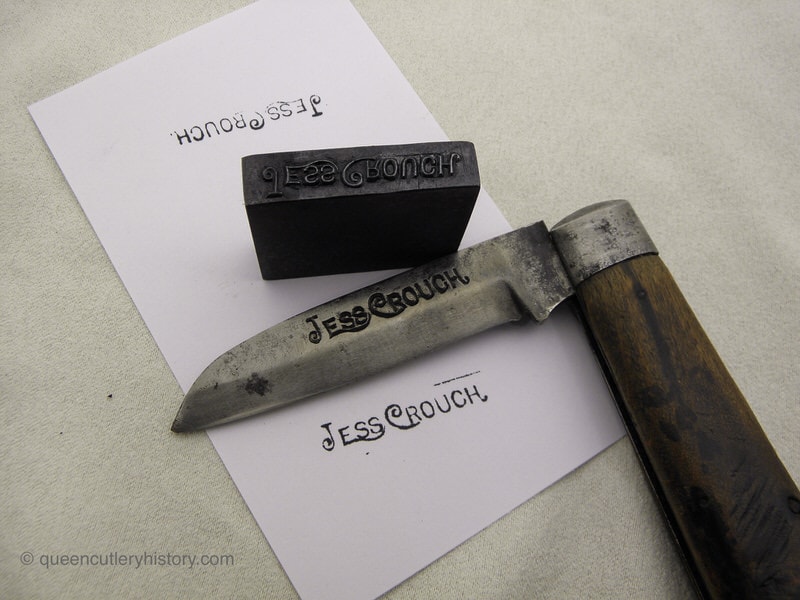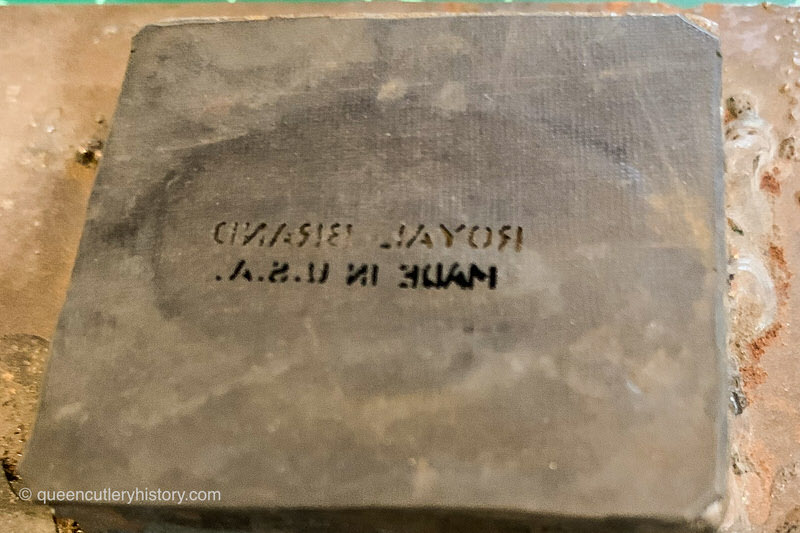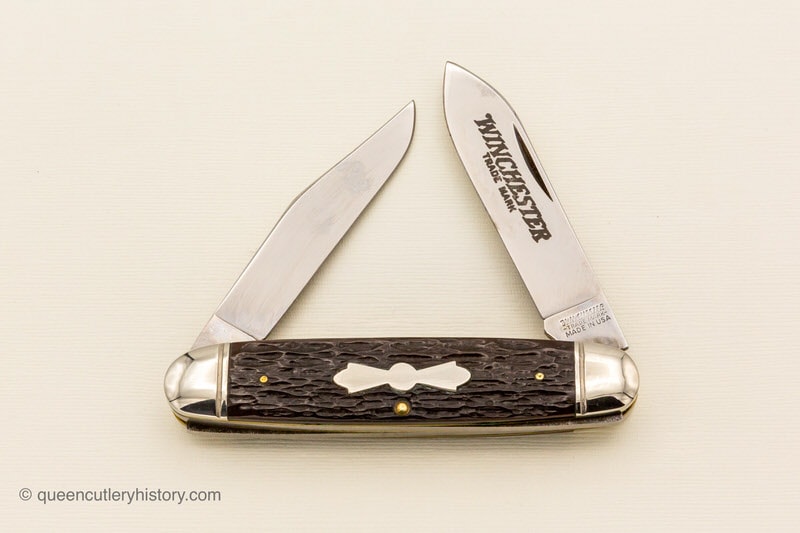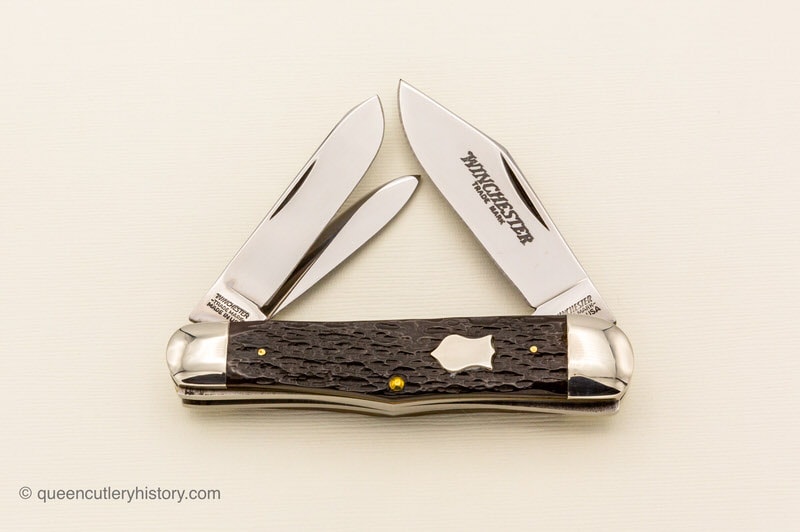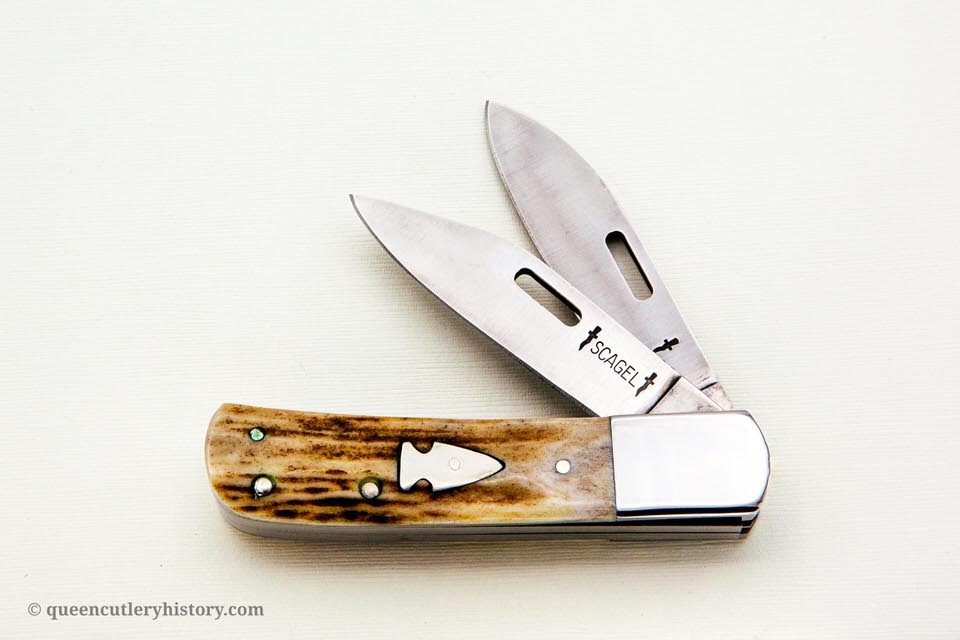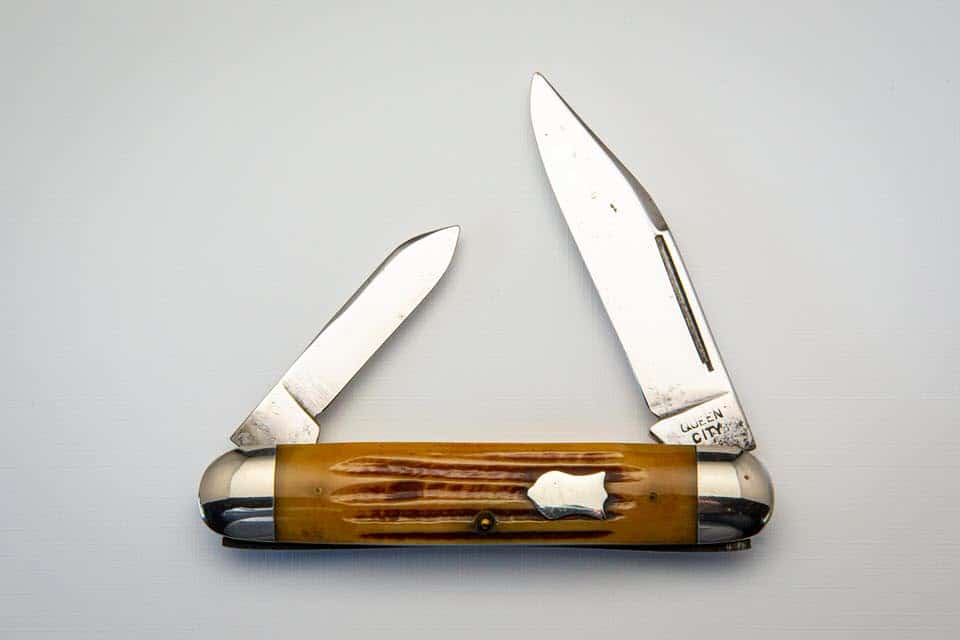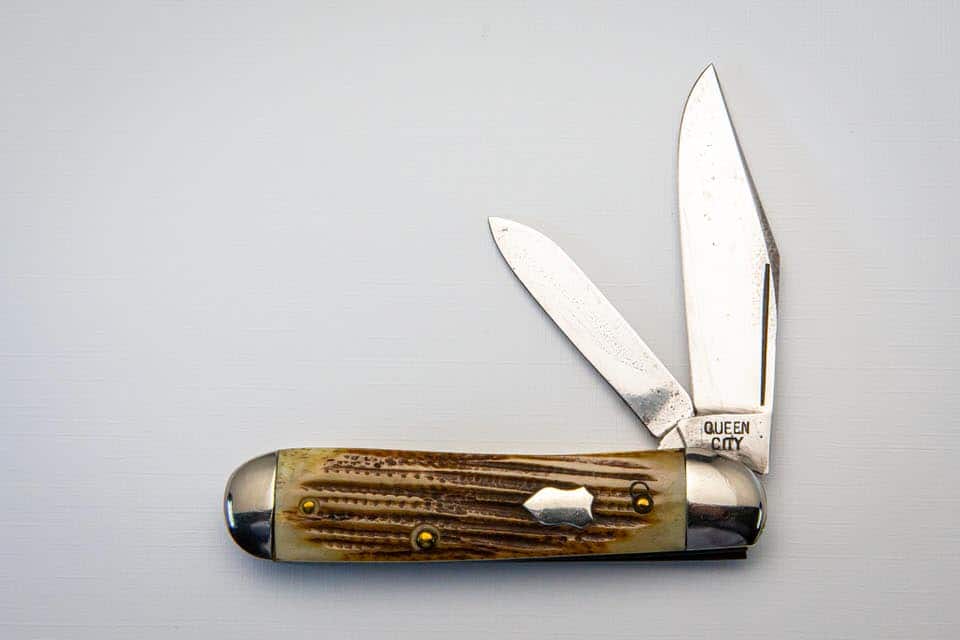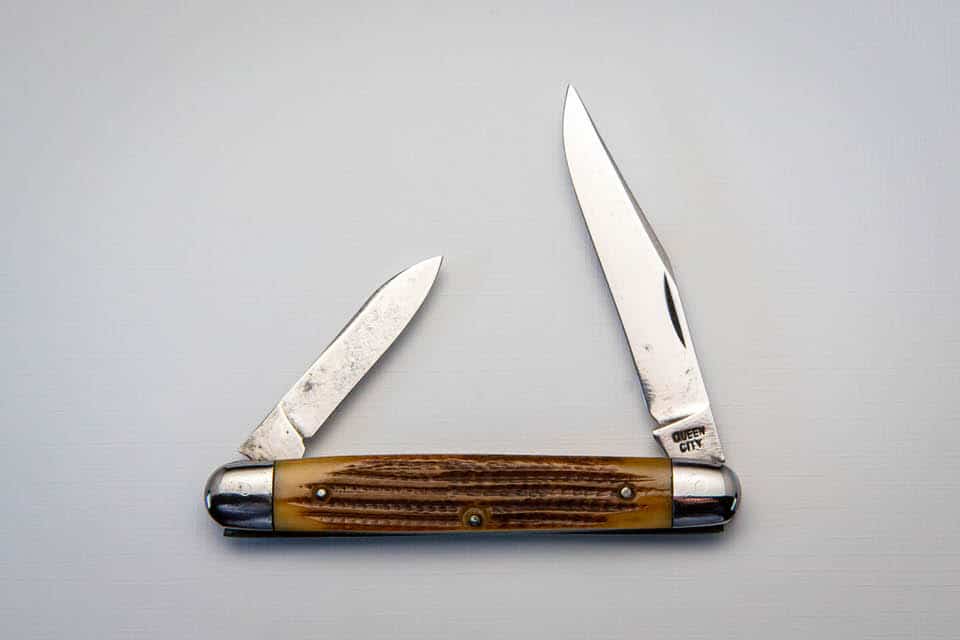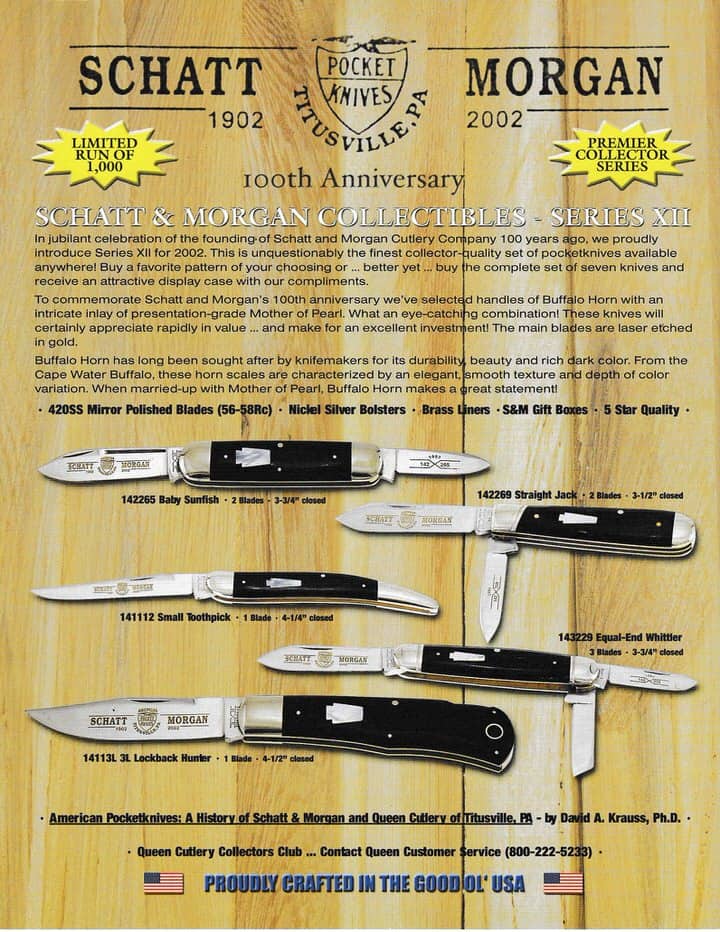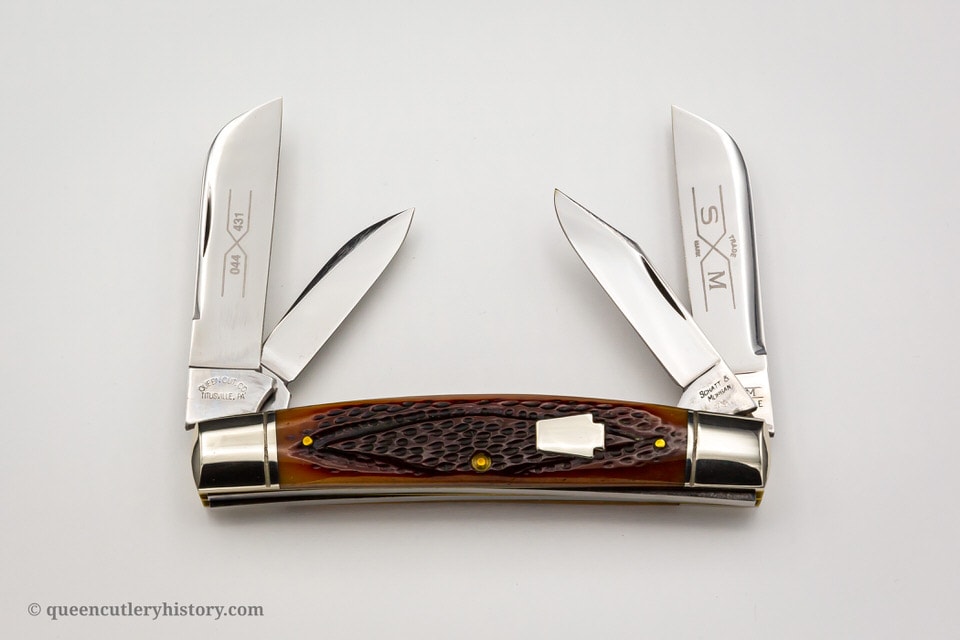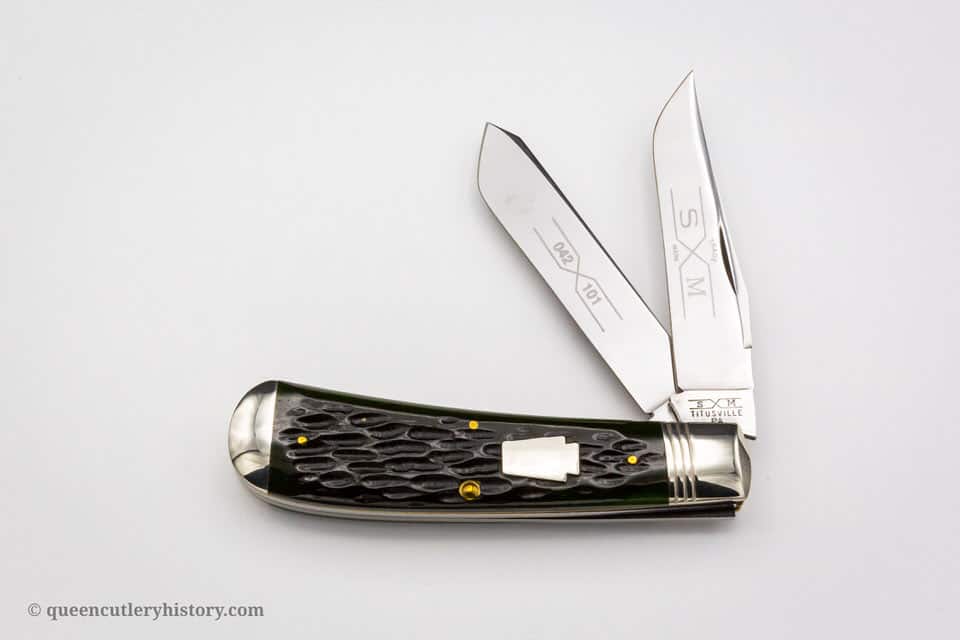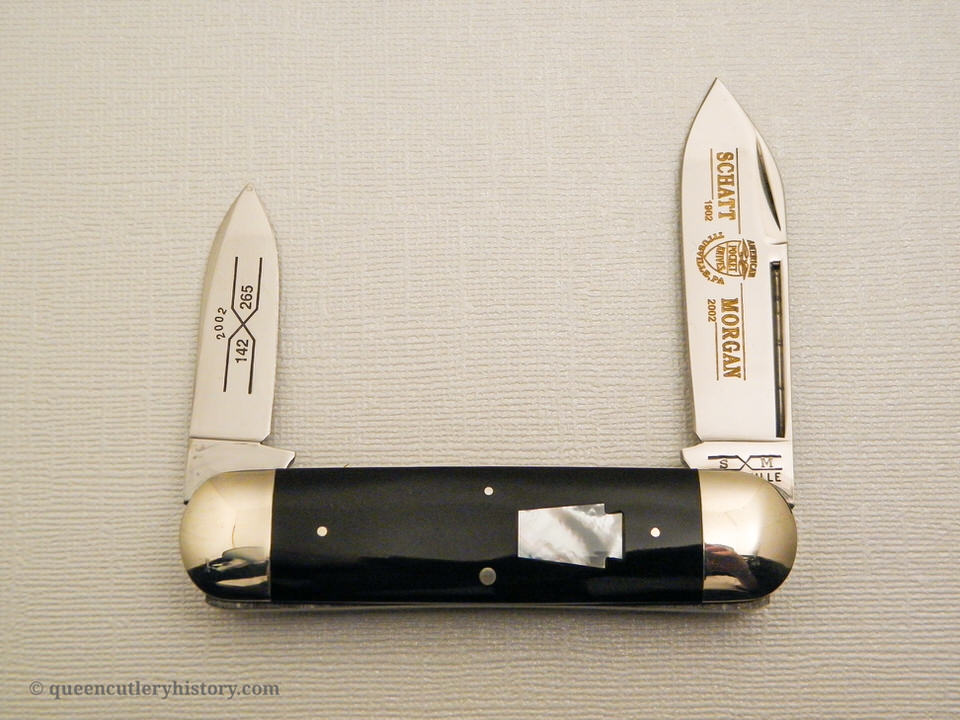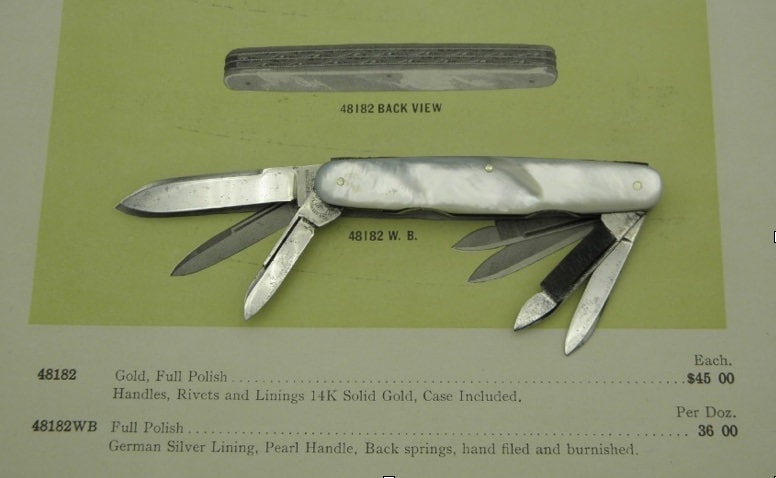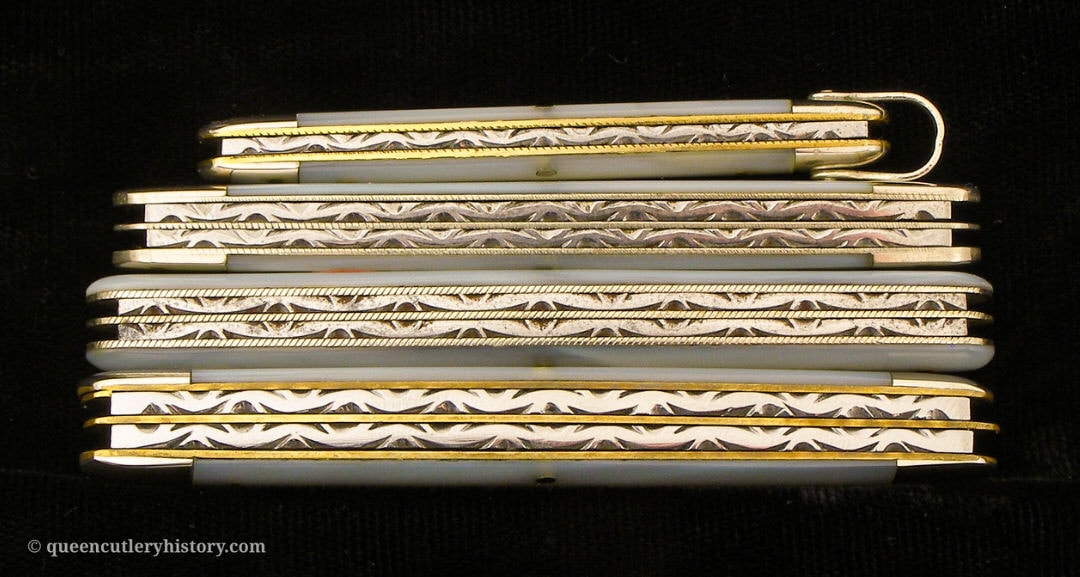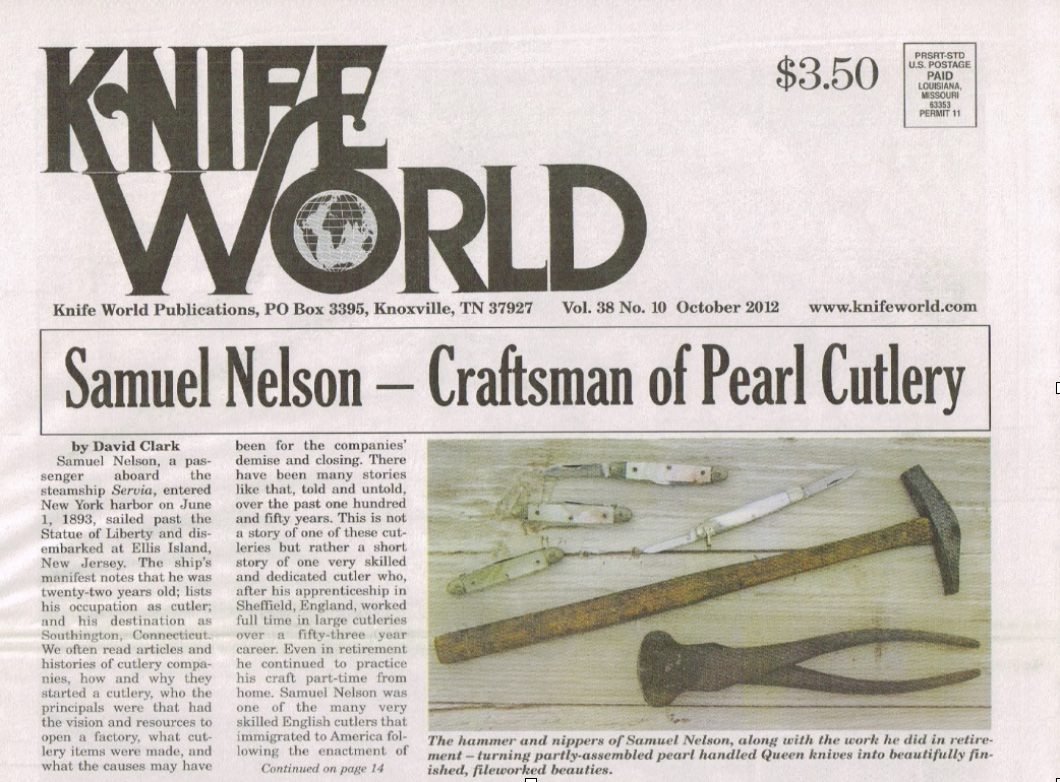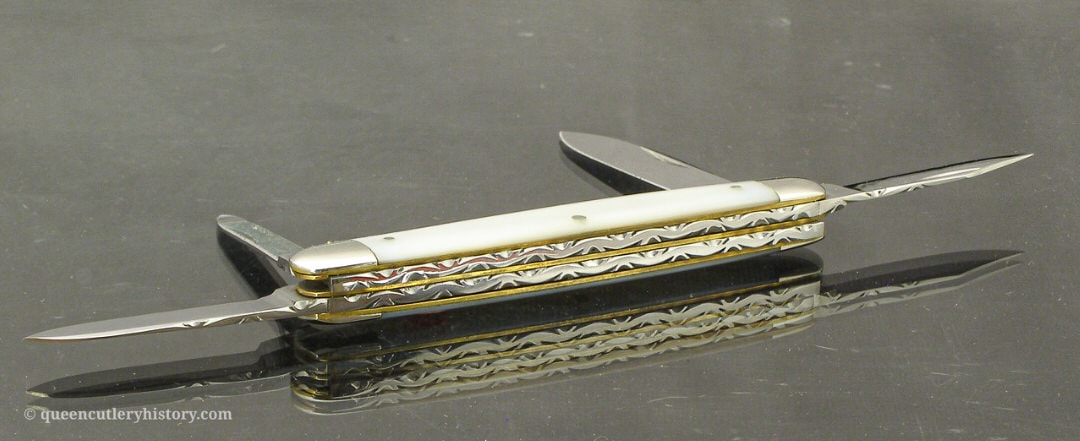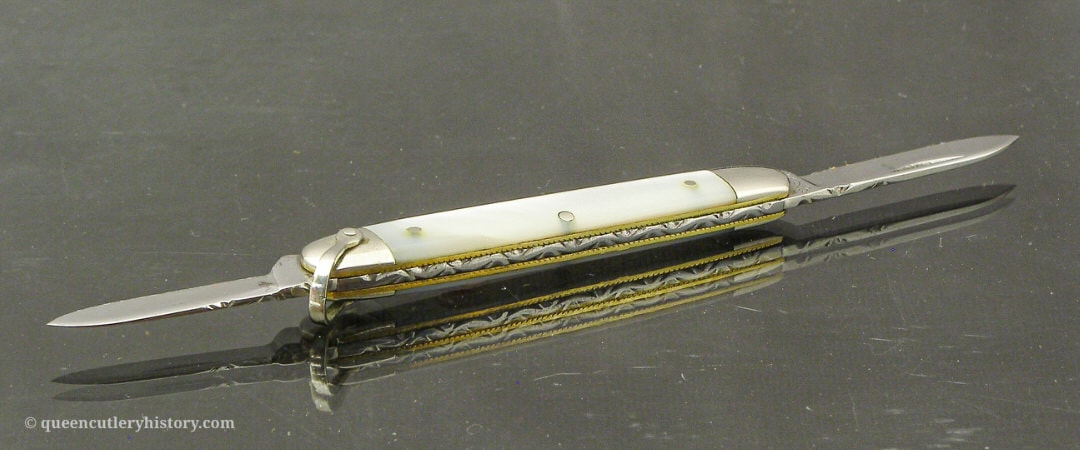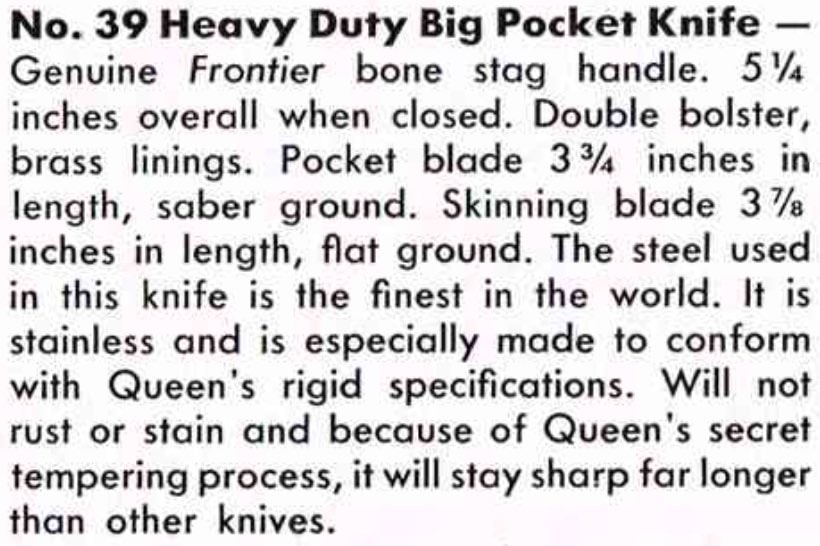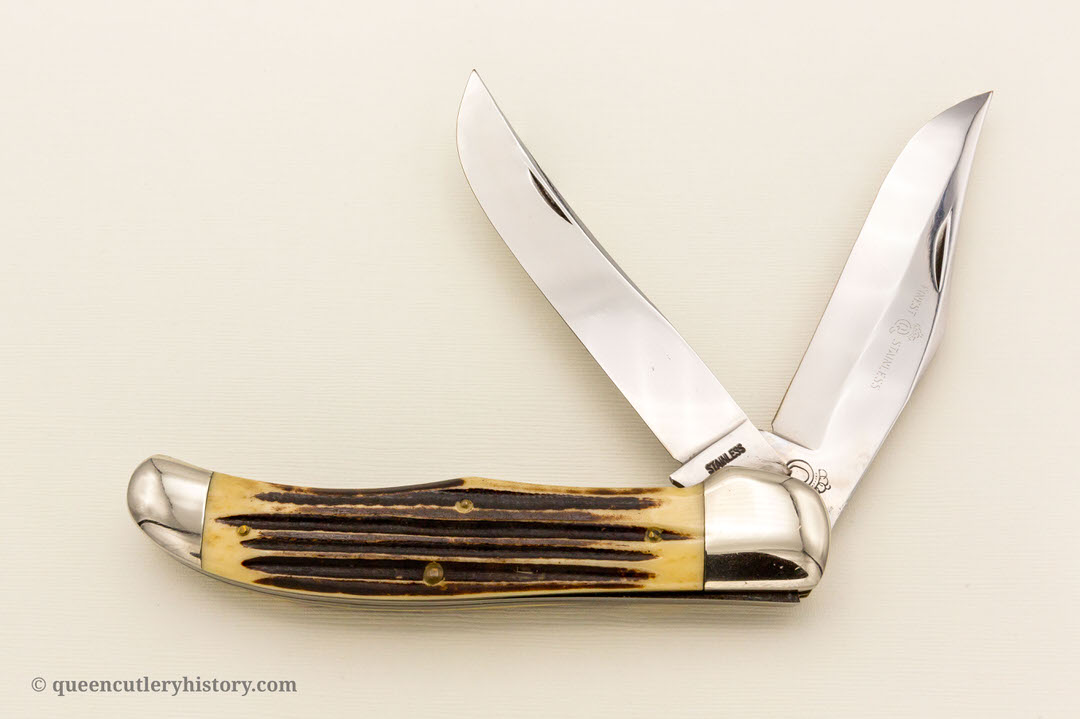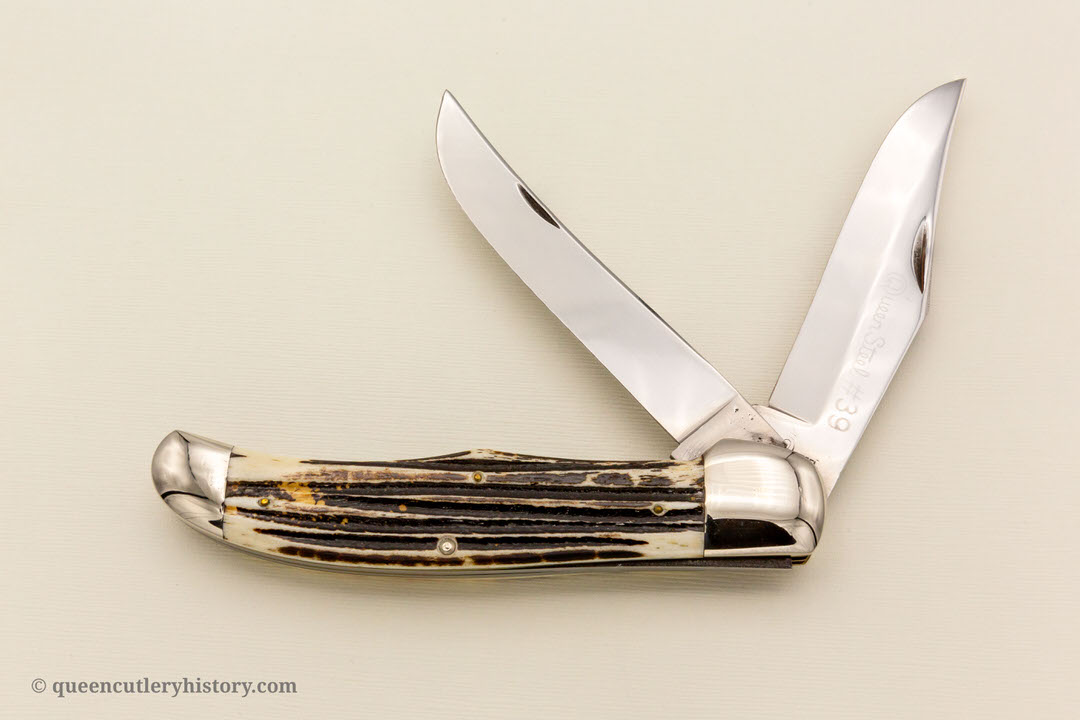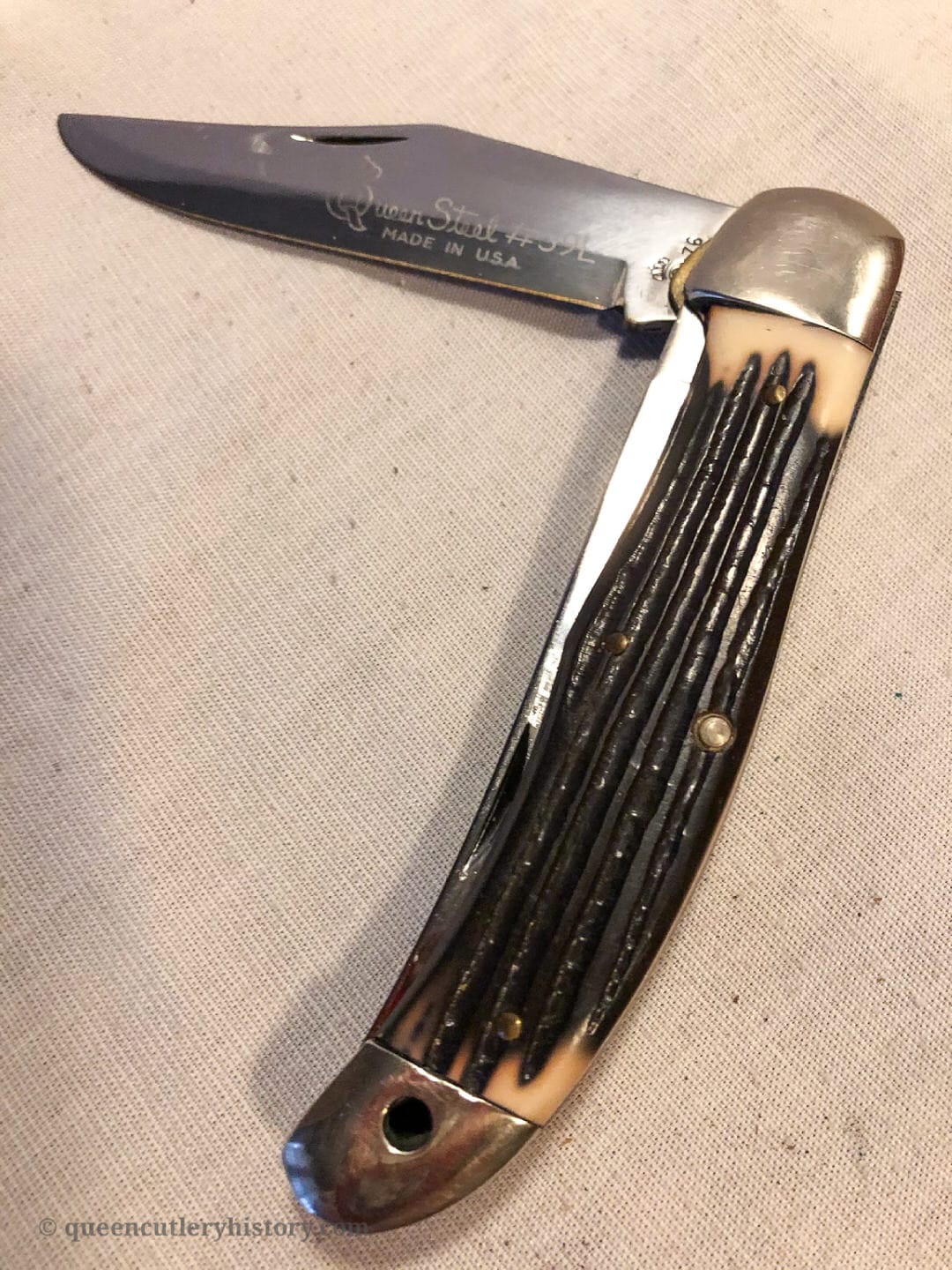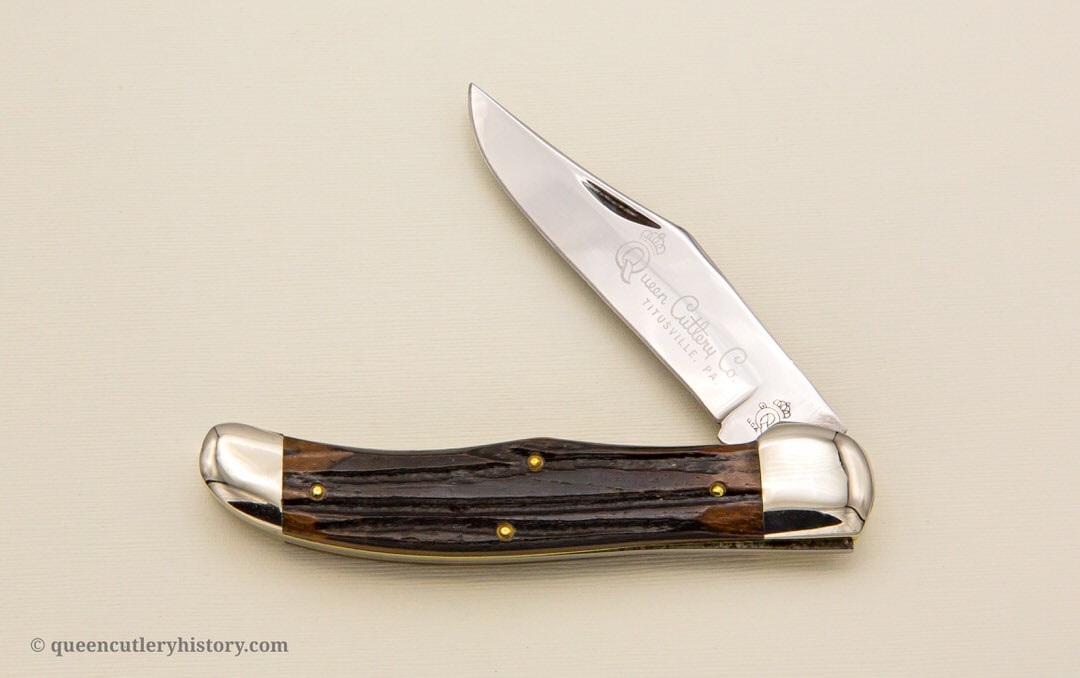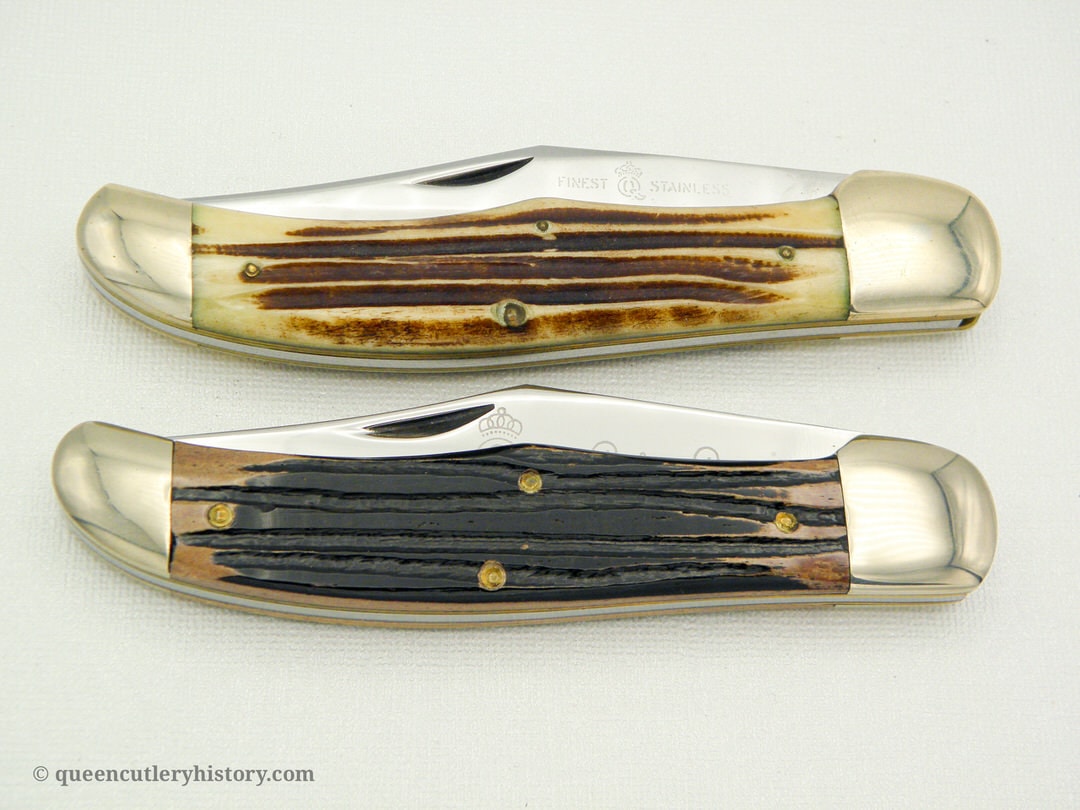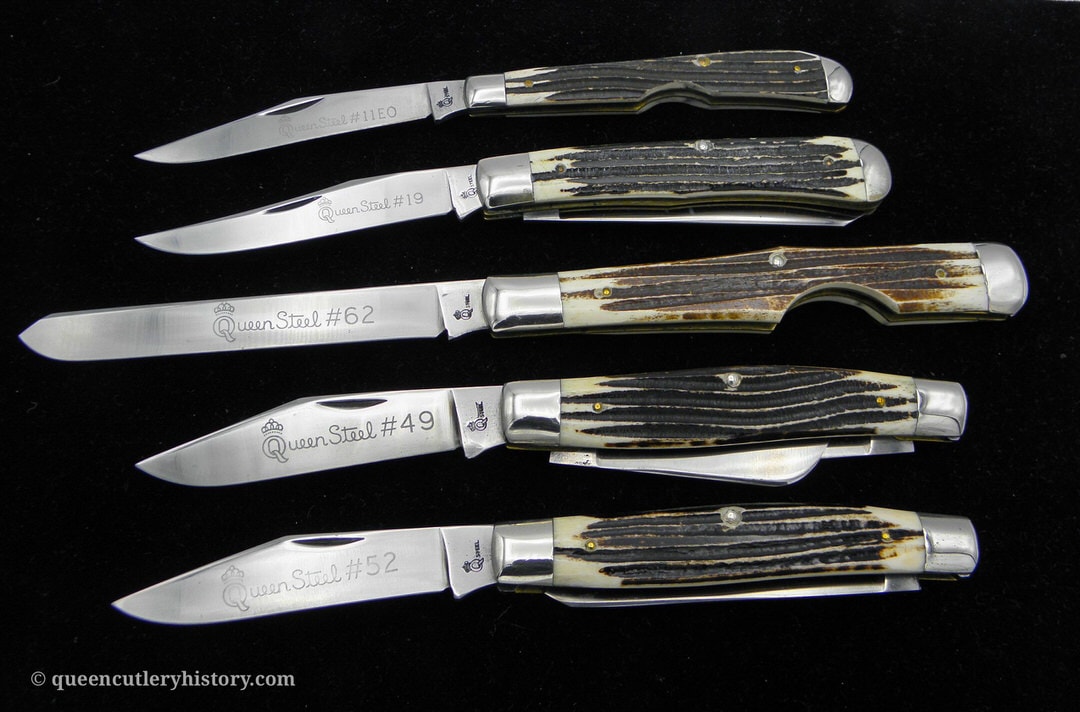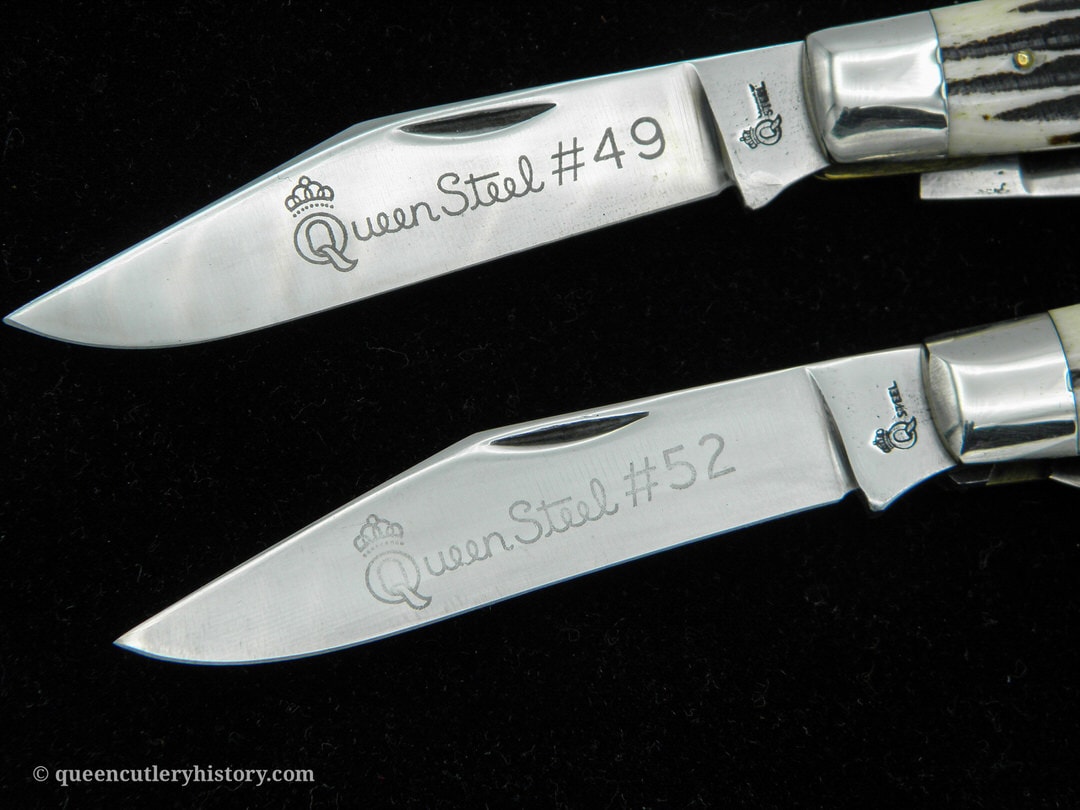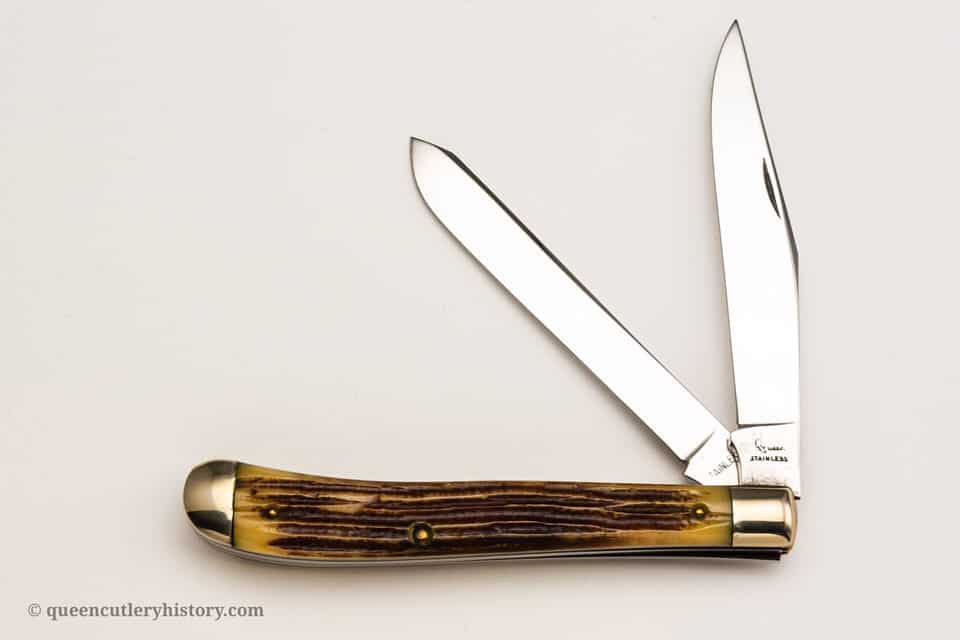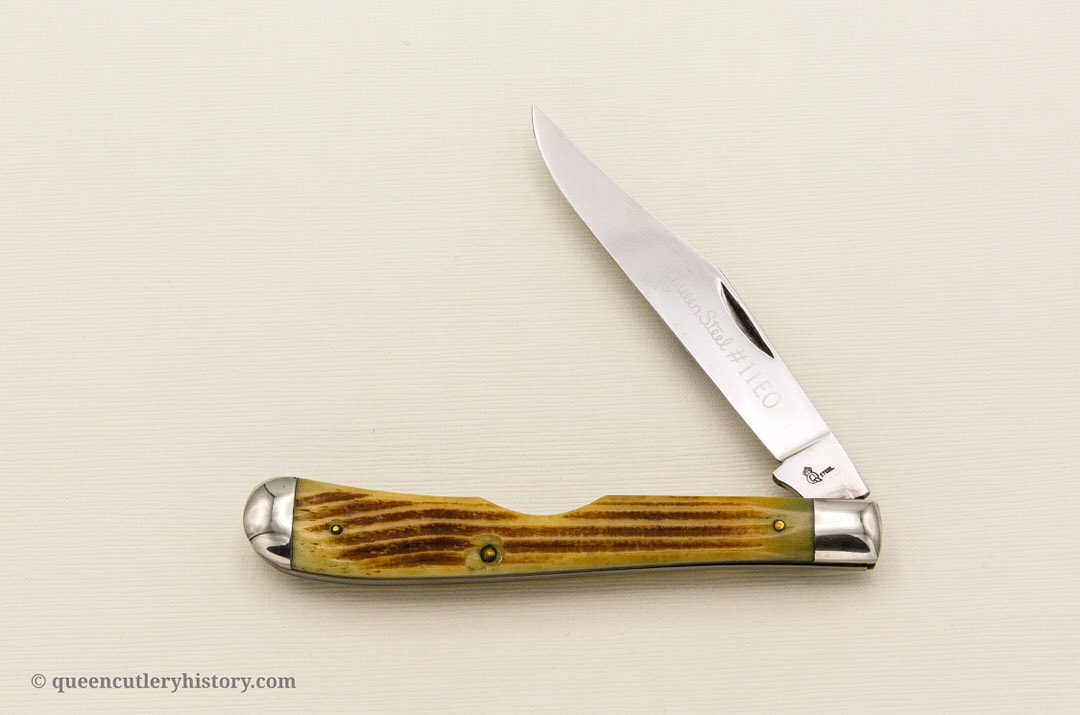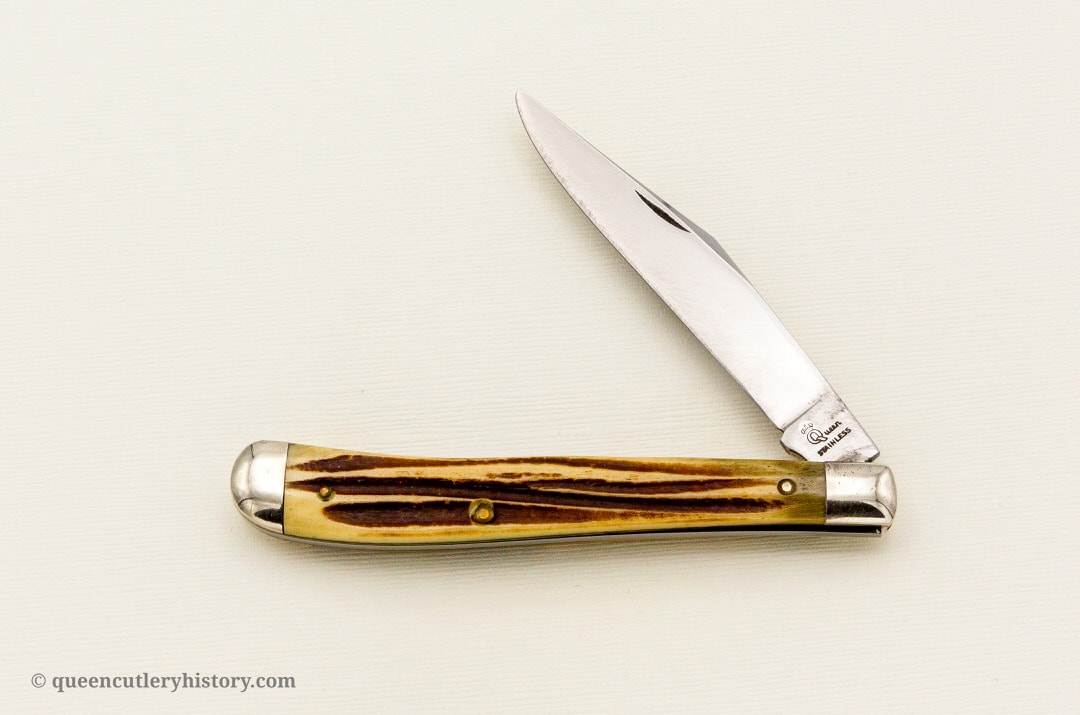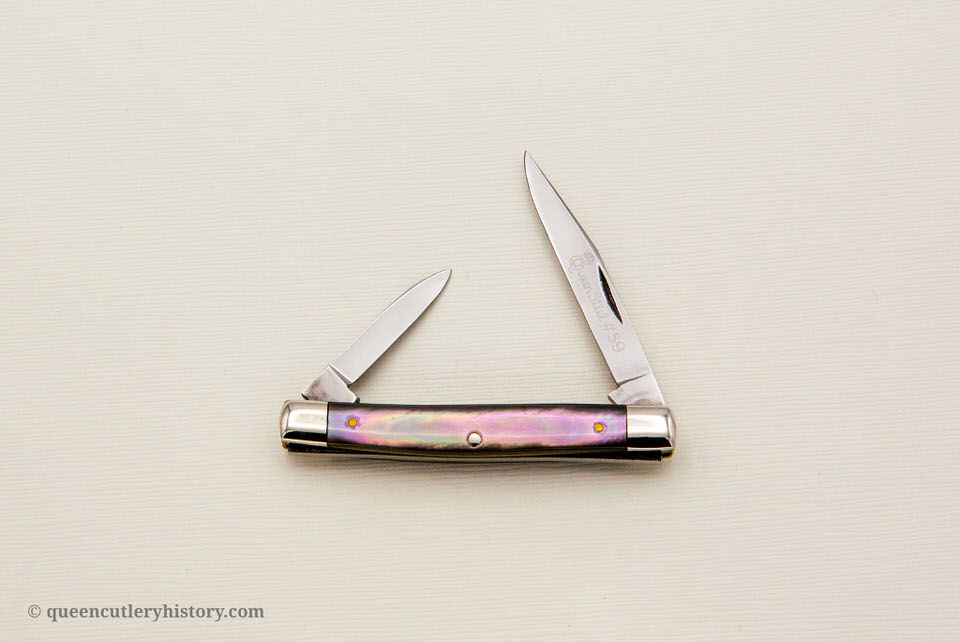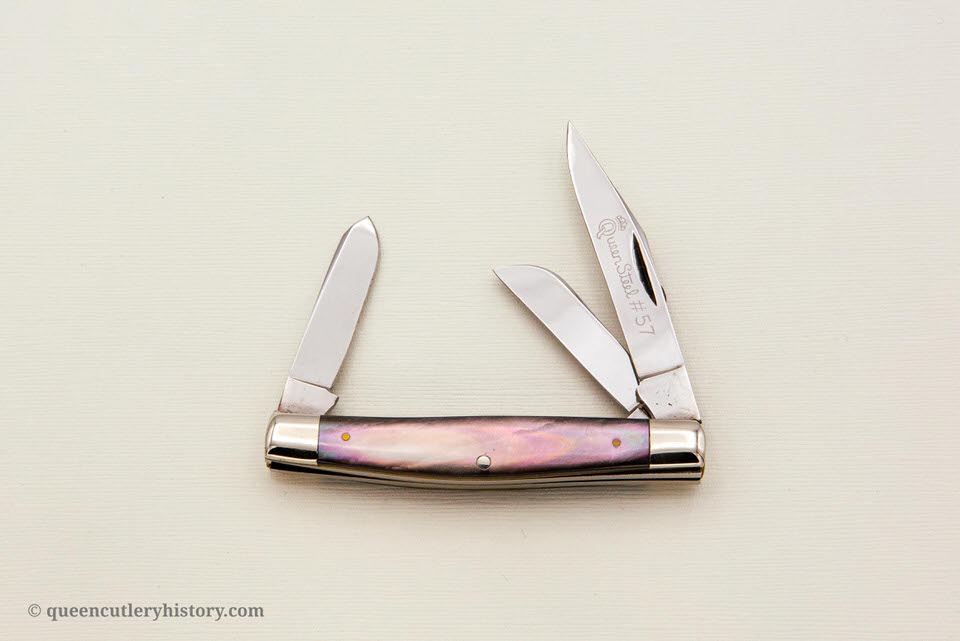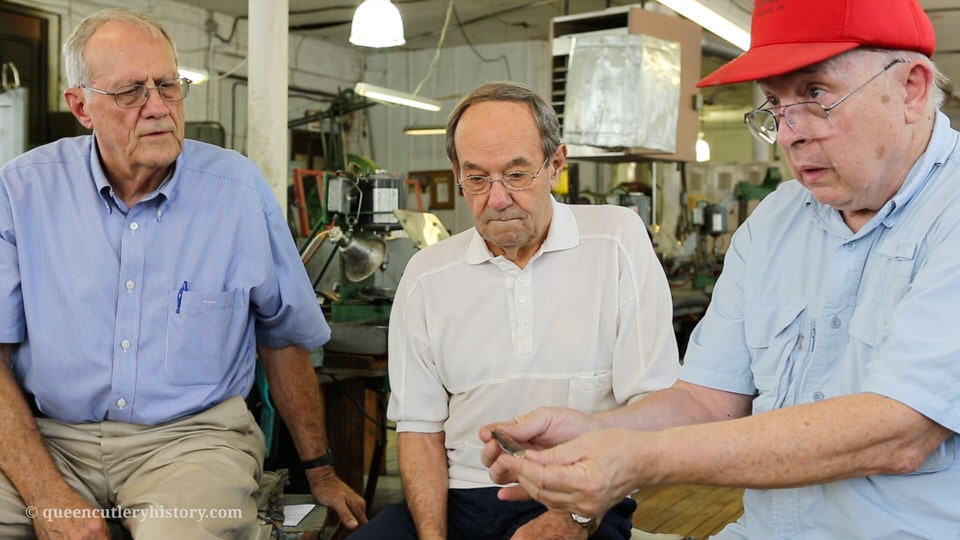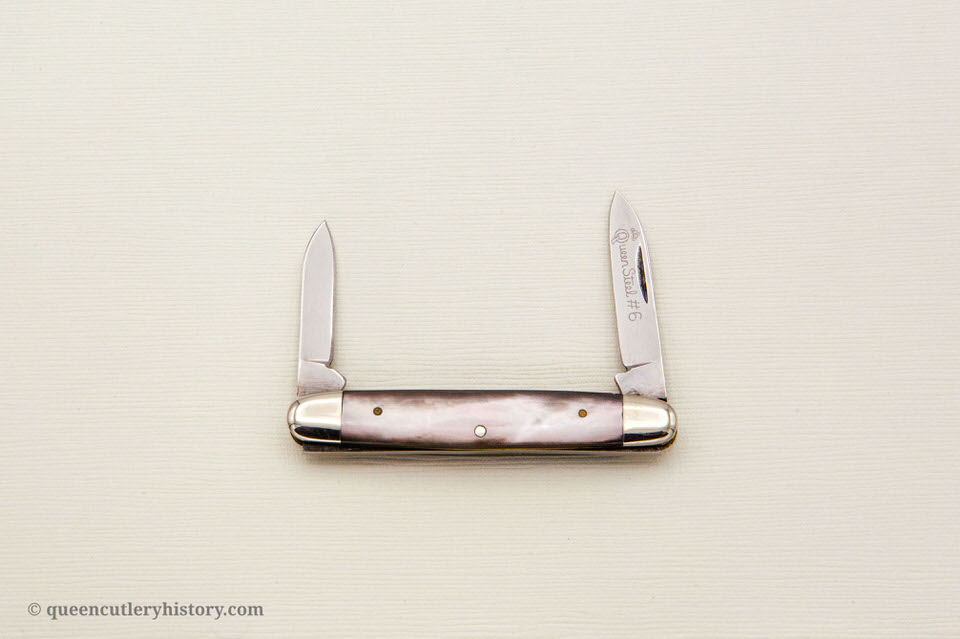Queen Cutlery History
Historical Knife Spotlight Archive
Approximately each month Queen Cutlery History features an interesting Queen or Schatt & Morgan knife in the spotlight feature on the home page. Anyone who may have missed past Historical Knife Spotlights can see them here, marked with the date in which the knife was featured.
Schatt & Morgan’s Heritage Series: Proposal vs. Reality
(click on any image to enlarge it)
March 4, 2025
by David Clark
Queen Cutlery planned to stop producing the popular Keystone Series of collector pocket knives after its twentieth and final year in 2010. Jennie Moore, sales manager at Queen, mentioned they were looking at ideas for a new series of collector pocket knives. I had come into the possession of two original Schatt & Morgan cutlery catalogs, one from 1903 and the other from 1907. My intention was to reprint these catalogs and make them available to collectors. The catalogs had been in the procession of the Matthews family, part of the original Queen City Cutlery ownership, since circa 1933. Joe and Betty Dial acquired them from Gerald Matthews a few years ago and then passed them on to me.
I approached Queen with the idea of starting a new series of collector knives based on selected patterns from these two vintage catalogs. The catalogs would be included with of the first issue of a planned twenty-year series starting in 2011. These new knives would be marketed as the Schatt & Morgan Heritage Series. Queen accepted the proposal and planned to make the announcement at a news conference at the 2010 Blade Show and have the knife prototypes ready for the 2011 SHOT show.
This is a copy of the first suggested narrative announcement of the Heritage Series:
New Schatt & Morgan Knife Reproduction Series
Series Name: Schatt & Morgan Heritage Series
Narrative Introduction:
John W. Schatt and Charles B. Morgan started their cutlery business in New York City in 1895 as an import company named the New York Cutlery Company. Because the import tariffs of the 1890s made the importation of English and German cutlery expensive and unprofitable, Schatt and Morgan, like many other cutlery importers, decided to start manufacturing. The partners took over the C. Platts & Sons Cutlery Co. plant in Gowanda, New York, after the Platts Company moved to Eldred, Pennsylvania in 1897.
The New York Cutlery Company prospered in Gowanda, however in 1902 they relocated to a new and larger facility in Titusville, Pennsylvania. The company incorporated in 1902 with the move to Titusville and changed the name from the New York Cutlery Company to Schatt & Morgan Cutlery Company. They began manufacturing in the new factory early in 1903.
In July of 1903 Schatt & Morgan published its first catalog from the Titusville factory. With both Mr. Schatt and Mr. Morgan on
the road selling, business was very good. The company published a larger and more graphically illustrated catalog circa 1907. These two extremely rare catalogs are being republished to initiate this Schatt & Morgan Heritage Series.
Queen Cutlery Company announces this new Schatt & Morgan Heritage Series, taking, from the pages of these two 100-plus year old catalogs, the pocket cutlery of the early years of the 20th Century. These reproductions will honor these old knives by closely reproducing the patterns, blades, bolsters, liners, handle materials, and finishes as much as we possibly can, including the use of the old, original pattern numbers. Collectors who purchase the complete first set will receive complimentary reproductions of both of the early catalogs.
Proposed Schedule to Launch Program:
- Blade Show 2010 – Officially announce the program with printed literature, ads in Knife World and other publications.
Also consider making the catalogs available for sale. - Using knives from the followings catalog pages (either entire pages or only certain patterns from these pages) I am suggesting the following six-year production schedule.
- January 2011 – Page 34 from Catalog No.1
- Produce 500 each in ebony and bone
- Produce pearl in lots of 20 on special order from a distributor
- July 2011 – Page 85 from Catalog No. 2
- Produce 500 each in rosewood and ebony
- July 2013 – from Page 81, Catalog No. 2
- Produce 500 of each pattern in rosewood
- January 2014 – from page 27, Catalog No. 1
- Produce 500 each in cocoa, ebony and bone
- July 2014 – page 58 from Catalog No. 2
- Produce 500 of each pattern in ebony
- January 2015 – from page 20 Catalog No. 1
- Produce 500 of each pattern in cocoa, ebony and bone as noted
- June 2015 – from page 22 Catalog No. 2
- Produce 500 of each pattern in bone
- January 2016 – Page 26, Catalog No. 1
- Produce 500 of each pattern in cocoa, ebony and bone
- July 2016 – from Page 74, Catalog No. 2
- Produce 500 copies of each pattern with handles as noted
Ideas for Advertising:
- Use the 8 ½ X 11” format to announce the program. Include cuts from the old catalogs.
- Use some of the original S&M graphics.
- Possibly use original knife box labels.
- Announce in Knife World and other publications.
- Issue miniature cards of the pages for each semi-annual series issued.
Schedule for Prototypes and handle material:
- Set meeting with graphics consultant for February 2010
- 1/1/2010 – Decide on the bone handle material (color and jigging).
- 1/1/2010 – Get all setups completed for first year.
- 3/1/2010 – Develop the draft of program announcements and graphic mockups.
- Mid September – tooling
- Nov. 2010 – start fabrication
- Jan. 1011 – start shipping
- 1/1/2011 – determine if iron liners and bolsters can be fabricated for future years patterns
This is draft copy from the Knife World editor, for their magazine announcement:
Queen Announces Schatt and Morgan Heritage Series
(subtitle) Vintage S&M Catalog Reprints Now Available
“Queen Cutlery Company has just announced a new series of collectible knives that will be formally introduced in 2011. The new Schatt and Morgan Heritage Series will replace the Schatt and Morgan Keystone Shield Series, which is set to wrap up after a highly successful twenty-year run.
The Heritage Series, presented as “A 100 Year Legacy Reborn,” was developed by Queen Cutlery in conjunction with noted cutlery collector and historian David Clark, who has contributed to several publications on the history of Schatt & Morgan cutlery and The Dollar Knife Corporation (including Knife World articles and the currently available History of Dollar Knives with David Krauss). Clark, who has also displayed his collection at various shows in the Eastern U.S., has made some remarkable discoveries in the course of pursuing his historical interests. One of the most recent involved a cache of original company records as well as the personal 1903 Schatt and Morgan catalog of founding partner C.B. Morgan – an edition that was previously unknown to collectors.
Discussions between Queen and Clark led to a very interesting suggestion: why not base the new Schatt and Morgan series directly on the two extant Schatt and Morgan catalogs, from 1903 and circa 1908?
That’s exactly what they’ve decided to do.
Beginning in 2011, the new Schatt and Morgan Heritage Series will offer groups of knives as they were illustrated in these original catalogs, a page at a time – meaning that a page will be chosen from either the 1903 or the c.1908 catalog, and every knife illustrated on that page will be reproduced in that installment of the series. With this approach, Queen Cutlery emphasizes the historical accuracy of the new series and gives collectors the opportunity to study the historic S&M line and anticipate new releases, as well as offering new possibilities for displaying their collections.
To take best advantage of these vintage catalogs, of course, collectors need to be able to obtain them; so Mr. Clark is making reprints of these catalogs available now, months before details of the first series knives will be announced to the public. The 1903 catalog checks in at 54 black and white pages, dressed in a black card stock softcover binding with an early Schatt and Morgan company logo impressed in gold. The c.1908 catalog features 130 semi-color pages with a card stock cover that has the Schatt and
Morgan logo in red, reproducing the original cover. The two catalogs will be offered together as a package deal for the price of $55.00 plus shipping.
To obtain your own copies of the 1903 and c.1908 Schatt and Morgan catalog reprints, contact David Clark at loisandclarkcutlery.com. For more on Queen’s upcoming Schatt and Morgan Heritage Series, watch this space as more details are announced!”
Queen prepared two flyers for the 2010 Blade Show press conference
Epilogue
Queen produced only two years of the planned twenty-year Heritage Series. In 2011, seven knives, comprised of three different patterns and various handle materials, were produced in the first series.
- Barehead jack, 2-blade
- Barehead jack, 1 spear blade
- Barehead jack, 1 clip blade
The second series was issued in 2012. It consisted of six knives, represented by 3 different patterns, again in different handle materials.
- Swell Center “Woodsman” knife
- Cattle knife
- Serpentine stockman
The plan was to have a limited run of 300 per knife. Quality problems plagued some of the second series so actual production numbers may have been lower. Some collectors sent knives back to the factory due to quality issues.
Queen was sold to Ken Daniels in 2012. The new ownership did not continue the series most likely due to a discontinue business arrangement (disagreement) with the vender suppling handle material, the same firm supply handles for the Keystone and the File & Wire handles.
David Clark was born in the Ozark Mountains of north Arkansas; he graduated from the University of Arkansas, and settled in Georgia following military service. He practiced architecture in Atlanta until retiring in 2009.
David discovered that he not only loved cutlery history, particularly Shatt & Morgan and Queen, but also the research of the early men who started these factories and the cutlers that made the knives. Occasionally, he has contributed articles to Knife World Magazine focusing on these subjects. In addition he has reproduced two antique Schatt & Morgan catalogs.
A new Historical Knife Spotlight is published with some regularity on this website. Occasionally we will re-publish past Spotlights on the home page due to strong interest. You can see past editions in the Historical Documents section (see pulldown menu) of this website.
August 2, 2022
We are aiming this Spotlight on another line of highly desirable knives manufactured by Queen Cutlery on contract: the early “black box” Winchester pocketknives marketed by Blue Grass Cutlery. Our focus with this article is on the first several Winchester releases with old Rogers bone handles. Blue Grass, of Manchester, Ohio, was started in 1986 by the late Dave Scott. The company licensed the Winchester trademarks for cutlery from Olin Corporation, which had acquired Winchester in 1931. We believe Blue Grass may have also acquired, some or perhaps all of the original tooling. Winchester began making cutlery in 1919 and ceased production around 1942.
The Blue Grass Winchesters entered production in 1987 with tangs stamped, in 3 lines, Winchester / Trade Mark / Made in USA. The pile side of each master blade was stamped with the pattern number and the year of manufacture, except for a few hundred pieces of release 1 (more about that later). Collectors have come to refer to these early releases as “black box” due to their distinctive packaging in black paper boxes having a finely grained texture and red flocked plastic inserts, vacuum-formed to the shape of the specific knife the box contained.
While very true to the original knives made by Winchester in the early 20th century, these new Winchesters also bore the hallmarks collectors have come to expect from Queen Cutlery. Blades were of carbon steel, as were early Winchester and Queen City knives and build quality was first rate. Later (we don’t know for sure how much later) we think Blue Grass also contracted with Utica Cutlery and perhaps others, for some knives. At some point in the 1990’s Blue Grass started making and or assembling quality knives in their own facility. The company holds information closely and attempts by some of our contributors to get information have not been successful.
The first release, made in 1987 by Queen Cutlery, was W15 1924, a single-bladed toothpick pattern. It came in a black box printed in silver ink with the Winchester logo, horse and rider, and the text “Knife Licensed and Approved by Winchester”. Some collectors refer to the ink on these boxes as “white” but it is, in fact, silver.
There were three primary versions of this first release, plus a couple of knife club issues. All had Rogers bone handles, heraldic shield and polished blades with Winchester logo etch. All were tang stamped. Most (4,173 pieces) have the original Winchester stamp as described above, in straight lines, on the mark side and the pattern number “1924” and issue date “’87” in two straight lines on the pile side.
Some (400 units) have no marking on the pile side and still others (600) have 1924 and ’87 stamped in a curve. These two variations are more valuable than the other 4,173 knives.
There is another difference. On most, the box cover includes “Trade Mark ®” and “W 15 1924” but some boxes don’t. We don’t know the reasons for these variations but it’s likely, with this first knife in the series, Blue Grass and Queen encountered a few startup issues. We also don’t know for certain whether Queen or Blue Grass packaged the knives in these black boxes though we have seen some Queens in boxes with very similar textured black covers. On the other hand, Queen may have shipped knives in bulk, with Winchester handling the final packaging.
We know that Queen started making knives for Blue Grass in 1987 and continued to do so at least into 2008. Our QCH colleague, David Clark regularly visited the Queen factory in Titusville and recalls seeing Winchester knives on the production line, especially larger patterns such as sunfish and trappers, for which Queen still had the dies. Likewise, friend and contributor David Krauss saw Winchesters on the line in the late 1990’s.
Many of the early releases were handled in old Rogers bone which had been discovered at the old factory. The last knives handled in old brown Rogers bone were produced in 1992 (release 24). Most likely Queen had depleted the old stock by then, having made over 40,000 knives with that bone.
Once production got underway the variety of patterns released was impressive. In 1987, there were seven releases, then nine in 1988 and six in 1989. In the next decade seven were issued in 1990, ten in 1991 and twelve in 1992. Many of these annual releases were not entirely different patterns, though. Several were patterns previously issued but with different handle materials including stag, pearl, several variations of celluloid, cast bronze and even sterling silver. The latter two are not highly prized by collectors. The celluloid-handled knives are subject to outgassing and degradation and should be stored in a cool, dark place, well away from other knives.
We noted some variations of release 1, W15 1924, several of which, due to scarcity, increased the value. Release 2, W15 3964, a serpentine stockman, was made with four different versions. Although all of them shared common tang markings and old Rogers bone handles, the blades and shields of some differed. The most numerous (2,964) had a heraldic shield and highly polished blades.
There was a version (800 knives) with small heraldic shield and satin finish blades.
Another variation (600 pieces) also had satin finish blades but a larger heraldic shield. Finally there were 150 units with a small heraldic shield and high polish blades. Just as with release 1, those knives made in the smaller quantities increased the most in value.
After the initial variations, the situation settled down and differences were primarily limited to handle materials. In all, eighteen releases were handled in Rogers bone between 1987 and 1992. Rather than get into wordy descriptions, we will let the pictures tell the story. Enjoy!
On the subject of value, the late Clarence Risner, a respected, long time dealer, past-president of the NKCA and founder of C. Risner Cutlery and traditional pocketknives.com, compiled a listing of the early Blue Grass Winchesters which was published in the Spring 1995 edition of Edges. This document covered releases 1 through 47, including variations, made between 1987 and 1992. Clarence also noted the original list prices and the estimated value at the time the listing was published. We don’t have permission to re-publish this document but copies exist here and there on the web. The estimated values are to be taken with a grain of salt though. The market has changed since 1995. A better gauge of current value would be prices realized at auctions (live or online), at shows and online dealers. Still, it’s important to recognize that these black box Winchester knives continue to be very desirable to collectors and the value of many have held up pretty well over the years. In any case, these fine knives would make a fine addition to any quality knife collection.
May 5, 2022
The May Spotlight sheds new light on what’s come to be known as Queen’s Forgotten Tang Stamp. I first wrote about this subject in 2005 in an article for the Queen Cutlery Collectors newsletter. That article was never published because QCC stopped printing their newsletters in 2004. The updated article finally appeared in 2015 in the historical section of the now defunct Queen Cutlery website. That 2015 update now appears on this website. The important bits and several new photos appear in this Spotlight.
Near the end of the 2001 QCC show in Titusville, PA, Mark Zalesky, then the Editor of Knife World (now Knife magazine), offered to sell me a small Queen City knife. I don’t recall the pattern but I will never forget the tang stamp. In fact the stamp was the primary reason I didn’t buy the knife (to my everlasting regret). Over the years I’ve acquired a good assortment of early Queen City folding knives. Being older, these knives are more rare and it’s always fun to find a nice one. Several of my old Queen City folders exhibit unusual features such as uncommon bone handle jigging and pinned shields (which are not often found on Queens). Yet all of them had one or the other of the known tang stamps. That was what initially troubled me about Mark’s knife. The stamp was unfamiliar to me. I wondered if it was a fake. Mark commented he had never seen that stamp either. So I kept the $70 or so in my pocket and avoided having to search out an ATM before driving home.
On that drive my thoughts kept coming back to that knife and how stupid I was to have passed it up. The editor of Knife World wouldn’t go strolling around a knife show peddling bogus knives! Since that day I was determined to to find another knife with that unusual tang stamp and to try to verify its authenticity. The quest took 3 years. I could find no photo, illustration or mention of it in any of my books covering or even mentioning Queen. This excerpt from our own extensive tang stamp guide shows it plainly.
I finally found a knife with this stamp on eBay in June, 2004. It’s a 3” swell center, 2-blade pen knife with brown bone handles and peach seed jigging.
It is a close match for what would later be known as one of several patterns Queen would refer to as the # 38.
It took nearly a year but I found a second knife with this tang stamp in March 2006. It was a well-used, 3 5/8” equal end jack and it exhibited all the characteristics of the initial find – jigged brown bone handles, shield (this one the heraldic style), brass liners and nickel silver bolsters and shield.
In 2006 I hit the jackpot, purchasing 3 more such knives. Two of them were constructed much like the earlier acquisitions, with one being a 3” sleeveboard and the other a 3” swell center. The last of these, though, was different. It is a 3 1/4” serpentine with no shield and black handles.
A close look at the handles reveals a subtle, very fine, sharply defined swirl pattern. Others on the QCH team have seen it and we’re all perplexed as to what material this might be. It doesn’t seem to be celluloid and I suspect it’s animal horn of some sort – maybe buffalo horn. A destructive test may well determine the exact material but solving the mystery doesn’t justify damaging the knife.
Finally in 2011 a sixth knife with the forgotten tang stamp was added to the collection. This one was a 3” bowtie with a broken pen blade but with all the typical design elements of the others (except the black handled knife).
Now, 21 years after Mark Zalesky showed me that first knife, I have managed to collect 10 knives with this tang stamp. I supposed if I scoured online auctions and knife shows more frequently I would have found more but these knives are between 90 and 100 years old and the stamp is rare so 10 is where we’re at right now. Most of them are far from mint. They are from an era when a knife was a tool, meant to be used, not collected.
Over the years I thought I could narrow down certain common traits regarding these knives. All of mine are folders. Jigged brown bone handles, brass liners, nickel silver bolsters and, lastly, shields are the norm. The shields and jigged bone were consistent features, with the exception of the black-handled knife. Most of them were penknives and all were small, with the biggest just 3 5/8”. Then I located a nice swell end jack (like the # 10 only bigger} which was 3 13/16”. Evidently some fixed blades have been found too. I’ve since decided it’s best not to assume the knives with this stamp have too much in common.
The date estimate which appears on our Tang Stamp Guide estimates this stamp was used between 1922 and 1933. In reality the window may have been more narrow and tending toward the 1930’s end of the span. There is commonality with some Schatt & Morgan patterns, including the shields. The knives seem to have been made with some S&M parts, which came to Queen in the 1933 Sheriff’s auction after the S&M bankruptcy.
Did Queen have these knives made by another cutlery, on contract? Unlikely. The similarities with S&M knives are too obvious and in the Great Depression they would have wanted to keep their own people as busy as possible. Why the special tang stamp, with serif font? This may have been a way to differentiate these as using some S&M parts and designs. We’ll probably never know. There are more of these rare knives out there, so look closely at the tang stamps.
BW
April 4, 2022
In this month’s Historical Knife Spotlight we revisit the topic of contract knives made by Queen. Due to a lot of interest we are focusing on the Scagel reproductions marketed by Northwoods Knives.
Northwoods was founded by cutlery veteran Dave Shirley in the early years of this century. Previously Dave had owned Bowie Corporation and it was at Bowie that he developed a business relationship with Queen Cutlery. Queen would supply blade blanks which Bowie would finish and sell. The relationship continued when Mr. Shirley migrated to Marble Arms in Gladstone, Michigan. Queen made components for several of their knife patterns in the early 2000’s.
Dave was busy in the early 2000’s. He managed to negotiate a license to the rights to make and sell reproductions of the folders and fixed blade knives of the legendary knifemaker William Wales Scagel. Born in 1873 in Alpena, Michigan, Scagel began making truly handmade knives at some time around 1910. A major customer for his very limited production knives, machetes and axes was Abercrombie & Fitch of New York. Legend has it a chance exposure to a Scagel knife in the 1930’s helped inspire Bo Randall, founder of Randall Made Knives, to go into the knife business.
Having secured the rights, Dave’s company Northwoods Knives, headquartered in Gladstone, MI, contracted with Queen Cutlery to manufacture the product. The selection of Queen made sense as Mr. Shirley had the previously established supply relations at both Bowie Corp. and Marbles. He knew the company, capabilities, reputation for quality and its people.
As far as we can tell, Northwoods Knives issued 11 different Scagel reproductions. We cannot confirm that all were made by Queen but we believe that to be the case. We believe all blades in the series were of 1095 carbon steel.
The first release was a 3 5/8” 2-blade folder handled in deer antler stag (pictured here). The pins and arrowhead shield are nickel silver. This knife was packaged, as were all in the series, in a velvet pouch inside a rigid plastic box to which was affixed a machine engraved plaque. An an end of the box cover was an engraved facsimile of William Scagel’s signature. The knife was available for purchase in late 2004 at a price of $225 and the production run was just 135 pieces. Northwoods Scagel # 2 was 4 1/4” fixed blade bird and trout knife. It hit store shelves around February 2005 but was marked 2004.
Next came a single blade 4” folder handled in old sambar stag. Demand must have been good for the earlier knives because Northwoods increased the quantity to 150 knives which sold for $195. This knife came out in the May-June, 2005 timeframe. This folder # 2 was followed by # 3, a 4 1/8” 2-blade, also with old sambar sambar stag handles and nickel silver arrowhead shield plus (a first in the series), big, highly polished nickel silver bolster.
The next three knives, released between mid-2005 and mid-2006 were all fixed blades, though one had a folding blade integrated into the handle. One of these, # 7, was 9 1/2” long with a pinned whitetail stag and leather ring handle and accompanying leather sheath.
This was part of a run of 150 and sold for $195. Series 8 came out in 2007 in a run of 200 and was a big Barlow, 5” long. The handle on this one was old sambar stag and the retail price was $175.
Of the last 3 knives, # 9 was a fixed blade. This was followed in mid-2007 by a stag handled folding safety knife of which less than 100 were made. The last knife of this fantastic series was a bolster-less stag handled folder released early in 2008.
Dave Shirley passed away at age 74 in December, 2010. He leaves behind a rich legacy in cutlery history.
Certainly we don’t want to embellish too much but we think Dave would tell you he couldn’t have created these beautiful knives without the help of Queen Cutlery Company. Unlike the knives of William Wales Scagel they weren’t made entirely without machinery, yet the hand crafting is evident, upon close examination. These photos only tell part of the story. We hope you have a chance to see some of these knives up close.
March 2, 2022
Collectors of early Schatt & Morgan knives may be familiar with another brand of knives made by that company. We’re referring to the Dollar Knife Company, the third incarnation of which was owned by Schatt & Morgan. S&M manufactured knives bearing this branding from 1926 until roughly 1929. For the complete picture, interested readers can purchase the booklet The History of Dollar Knives by David Clark and David Krauss.
This edition of the Historical Knife Spotlight will concentrate on the early roots of the Dollar Knife brand. The Dollar Knife first appeared sometime around 1916 and before 1920 and was marketed by Theo. M. Green & Co. of Oklahoma City.
In the March 1981 issue of The National Knife Collector, Franz X. Kieffer writes that Green, along with his brother, operated the cutlery company from the basement of his home in Oklahoma City. Green’s knives were stamped on the tangs of each blade, THEO. M. GREEN & CO. OKLA CITY; THEO. M. GREEN OKLA CITY U.S.A.; OKLAHOMA CITY HDWE CO.; and DOMAR CUTLERY CO. OKLAHOMA CITY OKLA. Kieffer notes that Green’s company “…was later named Domar Cutlery Company after Theo’s two daughters, Dorothy and Marge”.
Kieffer’s article mentions that Greens knives “carry a resemblance to those made by the Schatt & Morgan firm.” One of the tang stamps Green used, OKLAHOMA CITY HDWE CO., was found by David Clark among an assortment of old stamping tools in the old Schatt & Morgan factory, (later the Queen Cutlery Company) in Titusville, PA (see photo). Other evidence suggests that Utica Cutlery Company also made knives for Green.
Green also sold knives identified as THEO. M. GREEN’S DOLLAR KNIVES. They were displayed in counter top display cabinets. The paper factory guarantee glued on the back of the cabinet indicates that the display cabinet was for the sale of the Dollar Knives. This was the first use of the Dollar Knife branding.
Pictured here is a 3 7/8” bone handled Texas Jack. Both tangs are stamped “THEO. M. GREEN & CO. OKLA. CITY” The main blade is etched “Theo. M. Green’s $ DOLLAR KNIFE $ “. This knife is thought to have been made by the Utica Cutlery Company. In our Historical Knife Spotlight of July, 2021 we published a photo of an identical
knife bearing the stamp of Curtin & Clark Cutlery Company, a brand for which Schatt & Morgan and Utica also manufactured knives.
Theo Green dismantled his knife ventures in 1920 and went into the insurance business. In late 1921 and certainly by January of 1922, the Dollar Knife brand re-emerged in Atlanta, under the ownership of Paul Jones of that city.
How did the business move across half the country in such a relatively short span of time? Clark and Krauss theorize both Green and Jones had made the acquaintance of a Schatt & Morgan traveling salesman who was eager to see Dollar Knives resurrected so he could sell more knives. As noted previously, by 1926 ownership of the Dollar Knife brand had shifted to Schatt & Morgan, in Titusville, PA. By this time the firm was suffering for various reasons. Not least among those was the loss of four key employees who left in 1922 and established the competing Queen City Cutlery Company.
A new Historical Knife Spotlight is published each month. You can see past editions in the Historical Documents section of this website.
December 29, 2021
As another year draws to a close, we focus the Spotlight on Queen’s use of Rogers Bone knife handles, also referred to as scales. Any collector of Queen knives knows that Winterbottom Bone has long been their so-called signature handle material. In our Historical Knife Spotlight of May, 2021, we pointed out that Queen placed their first Winterbottom Bone order in 1930. Through the 1920’s and up to the very early 1960’s, Queen also purchased bone handles from the Rogers Manufacturing Co. of Rockfall, CT.
Founded in 1891, Rogers started making knife handles sometime around 1900. At first the bone was sourced domestically but within a couple of decades it came predominantly from Argentina. Rogers Bone has its own distinctive appearance. On Queen City or Queen Cutlery knives it was almost always dyed brown. A custom jigging machine, developed by Rogers, created a seemingly random pattern of unique short jigs or cuts in the bone. This machine, or a previous iteration of it, was in service at least by the time of World War I and was retired in 1962.
One of the earliest examples of Rogers Bone handles on a Queen knife can be seen in this photo of a 3” swell center Queen City knife dating from 1922 or not long thereafter. Note the random angles of the jigged cuts.
Another early knife, this 3 3/4” bareheaded jack, exhibits a more uniform orientation to the jigging pattern. This knife was likely made around 1933, not long after Queen
City acquired the assets of the bankrupt Schatt & Morgan cutlery in a Sheriff’s auction. Note the S&M tang stamp on the pen blade. It’s possible the Rogers bone handles also came from the Schatt & Morgan inventory.
These photos of the # 11 slim trapper with Crown & Dots tang stamp and the # 9 Big Q stockman both depict examples of post
World War II Queen knives equipped with Rogers Bone. Note how the brown dye penetrates deeply into the jigs, rendering them darker than the smooth bone at either end.
We mentioned that Rogers had stopped using their special jigging machine in 1962. The reason for this was economic. By the late 1950’s several factors converged to drive a transition from bone to plastic handles on some pocketknives. Rogers response to this was to pioneer the use of molded Delrin plastic handles. Queen Cutlery was an early innovator with this material and their initial offerings featured
what we now know as Burnt Orange imitation winterbottom bone. This photo shows a Burnt Orange # 58 swell center. For a deeper look at the subject, read this article.
Still, Queen did retain a stock of genuine bone handles from Rogers. These handles were used on a number of knives through the 1970’s, 1980’s and even later. One prominent example was the Master Cutler Collection of knives from the late 1970’s.
Created by then Master Cutler and contributor to this website, Fred Sampson, all featured Rogers Bone handles. The trapper in this last photo is an example.
A new Historical Knife Spotlight is published each month. You can see past editions in the Historical Documents section of this website.
November 30, 2021
In this month’s Spotlight we’ll look at the Queen Cutlery Collectors (QCC) annual knives. We often write about rare knives from Schatt & Morgan and Queen. Sometimes the focus is on very old knives. Usually these knives were made in large numbers but over the passage of decades few are left in good enough condition to be of interest to collectors. In other Spotlights we write about knives which are rare due to some unusual feature which led them to be produced in small quantities. The Smoked Pearls or satin finished blades from Queen are good examples. The QCC knives range in age from just 13 to 21 years old. They are rare because they were made in very small quantities.
Queen Cutlery Collectors, Inc. was founded in 1998 by Mike Sullivan who had a long technical and successful career in the steel industry. Owing to that he had a relationship with the management of Queen Cutlery and its sister company, Ontario Knife. Mike was supported in the endeavor by Howard Drake, a former Queen employee who has an extensive collection of Queen fixed blade knives. Queen Cutlery management also strongly encouraged and contributed to the endeavor.
A driving factor in the establishment of the club was raising the visibility of Queen Cutlery among collectors. To that end, informative newsletters were published, with some regularity at first and more sporadically as the years went by. You’re invited to read them at our Cutlery Articles page. A well-attended biennial knife show was organized and this continued for many years. Collaborating with the Queen factory, QCC issued some very beautiful knives from 1999 through 2008.
The first knife issued was a 4-blade Utility. This 3 5/8” knife featured a spear blade, can opener, screwdriver blade with bottle opener and a punch. It was equipped with a bail and deep brown Winterbottom Bone handles with inlaid Queen Steel oval shield. The main blade was etched and the membership number of the purchaser was engraved on a bolster. Though designated the 1999 knife, many were not shipped until early in 2000.
Next came the Millennium Knife which was also released, of course, in the year 2000. It was patterned on the # 36 lockback. Handled in caramel jigged bone, only 60 were made.
In 2001 the third QCC knife was the # 24 slimline trapper. It measured 4” closed, with stag bone handles and was made in a run of 70, selling for $80 to members. The clip and spey blades were of 440C stainless steel.
Then came the 5 1/4” # 38 saddle horn, swell center hunter with a D-2 saber ground clip featuring matchstriker pull and gold blade etch. Release quantities had increased in 2002 to 100 knives.
A fancy 4-blade, 4” congress followed in 2003. This beautiful knife, pictured here, had long nickel silver bolsters embossed with the Big Q logo and separated by burnt stag handles. Blade steel was D-2. Quantities had been reduced to a more manageable 50 pieces with a member price of $87.50 each.
The # 1440 Mountain Man lockback came along in 2004. With a closed length of 4 1/2” this issue was handled in burnt stag with a propellor shield and 440-C clip blade. Again production quantity was 50.
The 2005 knife was actually shipped in 2006 (at least mine was). It marked a departure from earlier QCC knives in that
it was a 9” fixed blade camp knife. The saber ground drop point blade was made using 440-HC steel which was protected by a nicely worked leather sheath. Quantities were limited to 50 pieces.
Production delays caused the 2006 knife to arrive in 2007. It was a # 46 fish knife with 440-C long clip and fish scaler. This knife had burnt stag handles, came with a sheath and 50 of them were made.
The last knife issued, as far as we know, was the 2007 early style hunters knife. It was a big folder measuring 5 3/8” closed. A heraldic shield was inlaid into the autumn carved stag bone handles. The spear and long pen blades were of 440-HC stainless. Fifty of these knives were produced.
You will notice all of the pictured knives were engraved with the number 110. This is a member number, though some have assumed it is a serial number. This member number happens to belong to this writer, the tenth person to join Queen Cutlery Collectors. Evidently the member numbers started at 101 to make the club appear to be bigger than it was. The actual production quantities shown in this article, and etched on most of the blades, are accurate. Each master blade was tang stamped with one or another of the vintage stamps used by Queen over the years.
Photos of several of these knives accompany this article. You can see images of the rest within our knife library. If you should see one of these fine knives offered for sale, know you have a chance to buy an excellent example of 21st century cutlers art, and a scarce one at that.
A new Historical Knife Spotlight is published each month. You can see past editions in the Historical Documents section of this website.
October 29, 2021
Queen Cutlery’s Heavy Duty Jacks are in our Spotlight this month. These sturdy folding knives have their roots in the Queen City era (before World War II) and are anchored by the ubiquitous # 10 pattern. Sharing the same frame as the # 10 are the # 18 which has been referred to as both a “Heavy Duty Jack” and a “Spear Point Special”, as well as the # 40 “Heavy Duty Screwdriver”.
Aside from blades these three patterns all share common frames, back springs, liners, bolsters and pin configurations. All are 3 11/16 inches in length, with two back springs and nickel silver bolsters at each end.
Some early knives, from the Queen City era, have steel liners and pins but these were changed to brass after the company changed its name to Queen Cutlery in 1946. Likewise, at least some of the Queen City knives utilized carbon steel blades while Queen Cutlery blades were made of stainless steel. Handle materials were primarily either Rogers Bone or Winterbottom Bone and both were used before and after World War II. After 1959 many were handled in Delrin, also called “Frontier Bone” and “Imitation Winterbottom Bone”.
Where these three patterns differ is in the blade types. The # 10 always featured a clip main blade with a pen blade secondary. Pattern # 18 also had a pen, but the main blade was a spear point. As the name implies, the # 40 Screwdriver knife had a long, flat screwdriver blade with a cap lifter (bottle opener) above the tang. The main blade was a clip.
Queen didn’t publish catalogs prior to 1946 so it’s difficult to say with certainty in which year the # 10 and # 18 patterns were first manufactured. As noted at the start off this article, we have evidence, in the form of actual knives (see photos) of # 10’s bearing the Queen City tang stamp. All such knives this writer has seen have the Queen City (script) stamp, indicating production roughly between 1937 and 1945. Both of these patterns were included in the first catalog, oddly called number 82, of 1946. Both the # 10 “Heavy Duty Pattern” with crown and dots stamp and # 18 “Spear Point Special” with big Q stamp are pictured with blades both open and closed.
The Heavy Duty pattern name stuck through the 1969-70 catalog and starting with catalog 50 in 1972 it had been renamed “Farmers Clip” and that name stayed until 1982. There were no catalogs from 1983 through 1994 and in 1995 the name had been switched back to “Heavy Duty Jack” for its last appearance in a Queen Cutlery catalog.
Pattern # 18 had its own little section in Queen Catalogs through 1953.
Then, from 1954 through 1969-70’s edition it was relegated to a caption below the # 10 which read Same as above except with 2 5/8-inch Spear point blade instead of clip blade. In catalog 50 of 1972-78 a photo of it was again used and then it disappeared. Price lists as early as March 10, 1977 noted it as discontinued and remaining stock was being sold off.
The “Heavy Duty Screwdriver Knife”, pattern # 40, debuted in catalog 90 of 1954 and was last pictured with that name just two years later in catalog 92. The same exact knife re-surfaced in the 1972-78 edition, albeit with imitation Winterbottom Bone handles. In 1980 it had been re-incarnated yet again as the “Electricians Knife”, still at 3 11/16” length, but the screwdriver blade had been redesigned such that a wire stripper replaced the bottle opener on the screwdriver blade. The # 40 made its last appearance in 1982.
By 1995 the “Electricians Knife” had shrunk a little to 3 5/8”, had lost the lower bolster, added a bail and sported smooth black plastic handles. It was also cataloged as pattern T-29.
A new Historical Knife Spotlight is published each month. You can see past editions in the Historical Documents section of this website.
September 29, 2021
This month’s Spotlight is focused on some knives which were made well over a century ago: the Schatt & Morgan Gowanda knives.
Although this website is named queencutleryhistory, an important part of that history is that of their predecessor company, Schatt & Morgan (S&M). S&M cutlery is popular with our readers, in part due to the re-emergence of the brand in 1991 with Queen’s introduction of the Keystone Series, followed in 1998 by the File & Wire Series. In fact, among the most popular pages on this website is Schatt & Morgan Modern Knives in the Knife Library.
The inspiration for the design of all of these “modern” Schatt & Morgan knives came from the old knives of the late 19th and early 20th century.
John Schatt and Charles Morgan started their cutlery in New York City in 1895, primarily as an importer, and named it the New York Cutlery Company. It didn’t take them very long to recognize that to survive, they had to start manufacturing knives themselves. Such an undertaking wasn’t very practical in the big city so around 1896 or 1897 they relocated to Schatt’s hometown of Gowanda, New York,
about 35 miles south of Buffalo. There they purchased the former Platts Cutlery plant and set about making knives and razors in July of 1897.
This move was a very wise decision since Gowanda is more or less right in the heart of the late 19th century NY cutlery industry.
Cattaraugus (sound familiar) is 11 miles to the southeast. Little Valley, where W.R. Case had established his original factory, is just 17 miles away.
The implication here is that the town fathers in these small towns in far- western New York were very welcoming to companies willing and able to produce cutlery products. Perhaps more importantly, there were many skilled cutlers in the area so the workforce was readily available.
Schatt & Morgan operated in Gowanda from 1897 until 1902 when they moved to Titusville, PA which is about 84 miles to the
southwest. They remained in Titusville until 1933 when the business closed and the assets were purchased at a sheriff’s auction by Queen City Cutlery.
This is a very brief summary of the history. Readers wishing to learn more are encouraged to read Dr. David Krauss’ excellent article which appears elsewhere on this website.
The point of this bit of background information is to provide some perspective and also to emphasize the fact that the knives stamped S M Gowanda, NY or S M New York, (both on two lines) are very rare. Consider that Schatt & Morgan manufactured cutlery in Titusville for about 31 years. In comparison, production at the Gowanda plant lasted just 5 years.
Several images accompany this article and they help tell a bit of the story. Among them is a photo taken outside the wooden Gowanda factory building of 38 employees displaying a large, four-bladed exhibition folding knife and a grinding wheel. Another shows an invoice dated 1901 to a dealer in Holley, NY. Note the exaggerated factory illustration.
And then of course, there are the knives. We’ve tried to display a good assortment,
all formerly in the collection of our team member and historian, David Clark. There are bone, pearl and ebony handles. A wharncliff whittler, swell center, easy openers and cigar jacks. Have a good look and enjoy this glimpse of the early history of Schatt & Morgan.
A new Historical Knife Spotlight is published each month. You can see past editions in the Historical Documents section of this website.
August 29, 2021
With this month’s Spotlight we are fortunate to share the discovery of 39 unused Queen knives, still attached to a late 1950’s display.
In mid-August, Queen Cutlery History posted David Clark’s interview with Joe Dial (audio on this page). In it, Joe talks about finding mint knives in vintage Queen displays back in the 1970’s and ’80’s. You would think that after 40 years or so, the contents of all those small town hardware and general stores had long since been picked over. Think again!
At the end of August we were contacted by the folks who own Watermelon Creek Vineyard in the small town of Glennville, Georgia. They had found an old Queen Cutlery display in a nearby hardware store which had closed roughly 30 years ago and they wondered what we could tell them about it. We were also asked for suggestions on cleaning up the display and the knives.
As you can see in this photo the case is a simple rectangular box suitable as a countertop or wall-mounted display. It would have had a hinged lid with glass inlay. The board itself is orange in color with stylized Queen Cutlery Company, Titusville, PA printing at the top. Still wired to the board are 39 Queen knives comprised of 36 folders and 3 fixed blades with leather sheaths. Adjacent to each knife is a disc with the pattern number and a price.
We were unable to find this particular display in any Queen catalog but have been able to determine it dates to the late 1950’s. Two clues led to this conclusion. First, it contains a # 62 Easy Opener with no nail nick. Secondly, there is a # 19 Trapper with Winterbottom bone handles. Both of these knives were only made in the late ’50’s (thanks Fred). Most of the tang stamps are either Q Steel or Queen (crown with script), both of which are consistent with the late ’50’s date.
A couple knives have no tang stamp, a feature which came into use in 1961. It’s evident at least one knife was replaced by another. In that case, a # 5 Senator is in a spot labeled for the # 16 Stockman.
While dirty when they were discovered, most of these 60+ year-old knives are in remarkably good condition. A couple spots are visible on some blades but the advantages of Queen’s stainless steel are very obvious. The knives on the display board are:
Top row: # 26, stockman; # 5 senator; # 35, small serpentine; # 48, whittler; # 9, stockman
Second row: # 51, dogleg; # 2 & 2A, serpentines; # 22 & # 23, barlows; # 47, half whittler; # 21, sleeveboard; # 42 & # 43, small serpentines; # 17, peanut; # 49, large stockman;
Third row: # 52, moose; # 24 & # 30, slim trappers; # 11, utility; # 11EO, utility, easy opener; # 13, utility; # 1, hawkbill; # 63, stockman; # 10 & # 18, heavy duty jacks; # 57, swell center; # 64, canoe;
Fourth row: # 95, # 82 & # 89, hunting knives; # 45, Big Chief folder; # 85, trout knife; # 19, trapper; # 29 & # 28, large jacks; # 28, Texas toothpick; # 39, folding hunter; # 62, large easy opener;
It’s obvious the #’s 5, 64 and 39, all handled in early imitation Winterbottom Bone (Delrin) have faded and degraded. The knives handled in “Amber”, #’s 2A, 42, 17, 30 and 13 are, for the most part, severely degraded. We suspect this damage was caused by long term exposure to the UV component of sunlight. Maybe the case sat in a store window for a long time. In comparison, the bone handled knives appear to be in very good shape as does the orange color of the display board.
Some time soon this wooden case and all the knives will be on display at Watermelon Creek Vineyard. The suggestions we offered for preparing to unveil them were relatively simple. The first step is to gently clean dust and dirt off the case and knives with a soft paintbrush. If necessary, try getting dirt off the orange board with a soft damp cloth. If you choose to use a mild cleaner, diluted with water, try it first in an inconspicuous area.
The knife blades look pretty good so we don’t recommend polishing them. Instead, wipe them with a soft cloth and good quality gun oil. Rem Oil works well. The oil will clean them and also protect them from humidity. If you can, get some oil on both sides of the blades. You also should apply a little oil to the pivots, at any spot where a blade hinges.
If you want to polish the bolsters, use a soft cloth with a little dab of good polish such as Simichrome. Rub it around on the bolster and then wipe it off with another clean soft cloth. The bolsters are nickel silver, with the exception of the Barlows which have aluminum bolsters.
The knife below label 16 (actually a Queen # 5 has Delrin (plastic) handles which have cracked and faded, probably due to sunlight. There’s nothing to be done for the cracks. The handles on the #2A (also plastic, called “Amber”) have degraded very badly. Again, this can’t be fixed.
A suggestion for the display location would be in a dry place, out of direct sunlight. You may want to install a sheet of clear acrylic or glass over the knives to discourage people touching them (or getting cut) and theft.
All in all, this was a very lucky find. It’s great these fine old Queen knives will be preserved. Even better, the people at Watermelon Creek Vineyard will display them and thus share them with their patrons. In addition to making wine, Watermelon Creek operates a restaurant, tasting room and gift shop. If you’re inclined to go see these knives, know you can also get a good meal plus taste and buy their wines too!
Epilogue
It didn’t take very long for the folks at Watermelon Creek Vineyard to follow our suggestions. They have repaired the display case and covered it with a sheet of transparent plexiglass.
The 39 knives in the display have been cleaned, lubricated and the blades have been wiped with light oil.This application of oil, by the way, is a good practice for collectors to follow. It’s especially helpful for old Queen City or Schatt & Morgan knives, or any other knives which have carbon steel blades. It also won’t hurt to wipe down stainless steel blades with a little oil.
The restored display has now been installed in the banquet hall at the Vineyard, which is also decorated with memorabilia from the vicinity of Glennville, GA. Click the photo below to visit their website
July 29, 2021
This Spotlight picks up where we left off last month, on the topic of Schatt & Morgan and Queen contract knives. The specific focus this month is on knives made by Schatt & Morgan for Griffon Cutlery and Curtin & Clark Cutlery Co.
Griffin Cutlery Works was founded in New York City by German immigrant Alfred Silberstein in 1893 and a facility in Bridgeport, CT was opened the same year. The firm made and sold cutlery products such as knives, razors and scissors, including those made under contract by others. Griffon also operated a factory in Worcester, MA from 1919 to 1921.
In last month’s Spotlight we told you that in 2009, QCH team member David Clark was looking around for historical artifacts in the Queen Cutlery factory. There he discovered and made impressions of 19 old tang stamps which had been used by Schatt & Morgan, the assets of which Queen had acquired in 1933. One of those stamps was the rare “Griffon XX Worcester” stamp, embossed onto brass plate, in the accompanying photo.
Griffon trademarked “Carbo-Magnetic” in 1905, though its use dates back to 1895. “Carbo-Magnetic” refers to an electric tempering process which Griffon claimed, with some accuracy, results in more uniform tempering as compared to the use of fire. Also among the stamps found by David Clark was a “Carbo-Magnetic” stamp used by S&M in the production of knives for Griffon (see photo). The reference to electricity is clear from the use of stylized lightning bolts.
Curtin & Clark was another contract customer to which Schatt & Morgan supplied knives. In his unpublished 2008 monograph, the late Gary Nahrstedt wrote that the 1894 city directory for St. Joseph, MO lists “Curtin & Clark Hardware” with R.F. Curtin as President and O.B. Clark as Secretary-Treasurer. Goins lists Curtin & Clark in St. Joseph as operating from 1898 through 1909. The discrepancy may be explained by the fact the firm may not have branded cutlery products until 1898 but this is speculative. In 1910 Curtin & Clark was also established in Kansas City.
This is a David Clark photo of S&M’s original stamping die for the St. Joseph location. We are also sharing David’s closeup of the Kansas City stamp on a knife in his collection.
Although Curtin & Clark had established a line of cutlery, all such products were made by others and it appears they had several suppliers, including Schatt & Morgan. A simple numerical marking system was established so Curtin & Clark could easily identify which supplier had made a particular knife or razor. The most commonly found numbers seem to be 2, 5, 9 and 12. Schatt & Morgan was 9 and they made knives stamped with both the St. Joseph and Kansas City locations, as well as with the 4-C trademark. Photos of a couple of the knives made by Schatt & Morgan appear in this article.
We know that knives stamped 5 were made in Germany. Those marked 12 are thought to have been made by Tidioute. It
is thought that other suppliers were Utica Cutlery, and Challenge Cutlery but we are unsure which numerical marking they may have been assigned. Knives stamped “HKC” for Hollingsworth Knife Co. of Kane, PA have also been found.
Knowing that Curtin & Clark seems to have had at least 12 “supplier codes”, and knowing with certainty only a couple of them, we are left to wonder who else made knives for this company. Curiously, this knife box includes the phrase Best English Steel. Were the knives in that box made in England or was the blade steel imported from England and fabricated in the USA?
Those are questions for another day. Clearly further research is needed. Gary Nahrstedt made a good start and we’re grateful for the info he had shared. Of greatest interest to the curators of this website is the connection with Schatt & Morgan or Queen City / Queen Cutlery.
A new Historical Knife Spotlight is published each month. You can see past editions in the Historical Documents section of this website.
June 29, 2021
This month’s spotlight is a little different. We’re focusing on contract knives made by Queen and Schatt & Morgan. Once in a while readers will contact us asking whether we know whether Queen made knives for this or that other company. Sometimes the answer is yes, other times it’s no and occasionally we must respond that we don’t know for sure. But we do know of quite a lot of knife brands which came out of the S&M and Queen factory in Titusville, PA.
The earliest from Queen City were ESEMCO skeleton knives. These are knives with frames and blades but without handles. In 1922, the year Queen was founded, they received a contract from Shiman Mfg. Co. of Newark, NJ, for skeleton key fob knives. These knives featured stainless steel blades and the order helped get the new company off the ground. To learn more about this venture, click here to read David Clark’s article on the subject.
In 2009, QCH team member David Clark was looking around in the Queen factory and discovered and made impressions of 19 old tang stamps. Additionally, a knife vendor he knew showed him numerous blades stamped with the name and / or marks of 44 different knife brands. The blades had been purchased in 1985, during a so-called “housecleaning” at Queen. All of this material dated from the eras of Schatt & Morgan and Queen City Cutlery. This means the earliest would potentially date from 1895 and the latest, 1946. Among the names which you might recognize, are Baldwin Cutlery, Penn Cutlery, Hartford Cutlery, Arrow Brand, Royal Brand, Curtin & Clark, Crown Cutlery,
Tidioute Cutlery and Jess Crouch (see article here, and photo above). It’s important to note that the Baldwin and Tidioute blades and knives were not made by Queen, though. Rather, when those related companies folded (Tidioute in 1916 and Baldwin in 1924), their surplus stock ended up at Queen.
The accompanying photo of a Royal Brand swell end jack, measures 3 11/16” closed. This is essentially a Queen City #10 folder, with Rogers Bone scales but with a different marking. It has no tang stamp, but rather you can see “Royal Brand Made in U.S.A. sandblasted on the blade.
David Clark took the photo of the stencil. We can reasonably date this knife to the 1935 to 1945 period.
Queen Cutlery has always maintained strict confidence with its contract customers and did not freely disclose information about the contracts or the customers. It’s commonly known that Queen made knives for Case from time to time. Notable among these are the Case Classic series. Queen also made all the early Winchester and John Primble folding knives for Blue Grass Cutlery. A couple of Winchester examples, manufactured in the late 1980’s, are shown here.
Basically if your later Winchester knife was packaged in a black box, with a red flocked vacuum-formed insert, it was made by Queen in Titusville. These early Winchesters are very well made and reflect well on Queen’s quality and skills.
When Dave Shirley’s Northwoods Cutlery acquired the trademark and the rights to reproduce the knife designs of the legendary William Wales Scagel in the first decade of the 21st century, he turned to Queen to produce the knifes. As you can see from this accompanying photo, these knives were extremely well made, using premium materials.
There are plenty of other knife brands for which Queen manufactured cutlery products. In the future, we plan to devote another Knife Spotlight to these contract knives, so stay tuned. There’s lots more to share with you.
A new Historical Knife Spotlight is published each month. You can see past editions in the Historical Documents section of this website.
May 29, 2021
This month we shine the Spotlight on a signature element of Queen City knives: early Winterbottom Bone. For many decades Queen City and Queen Cutlery knives have been instantly recognizable due to their use of the unique linear grooved handle material known as Winterbottom Bone. As the name implies, these handles were produced by the Winterbottom Bone Company of Egg Harbor, New Jersey.
The founder, Samuel Winterbottom was born in Sheffield, England in 1857. At the time of his birth his family had been practicing the bone cutting trade for well over a century, supplying the cutlery trade in Sheffield. Samuel emigrated to America in 1885 and established his own company in 1891, with one employee. By the end of World War I the staff had grown to 85 people.
Although Queen had used Rogers Bone handles since the 1920’s, business records discovered by David Clark of our Queen Cutlery History team indicate Queen City Cutlery placed their first order for Winterbottom Bone in 1930. Though Case, Imperial, Cattaraugus, Camillus, Ka-Bar and others all made some knives with Winterbottom Bone, Queen became the primary user. Queen City’s purchases maxed out in 1936 and then slowly declined until the start of World War II.
All such handles used by Queen City during this period have come to be known by collectors as “early Winterbottom Bone”. As mentioned, it is
characterized by the long, continuous linear grooves, with gently rounded edges, along the length of the handle. Sometimes the jigging included small fine dimples, like tiny pick marks, along the grooves. These grooves usually
terminated before reaching the bolsters though occasionally knives were made with a few grooves reaching the edge of the handle. The handles were always dyed in attractive brown or tan colors often with a contrasting yet complimentary cream color in the areas without jigging, Virtually all knives having early Winterbottom Bone handles will have one of the Queen City tang stamps.The accompanying photos illustrate several examples of Queen City knives with these early Winterbottom Bone handles.
The period immediately following World War II was a major transition point for Queen. Queen City Cutlery changed its name to Queen Cutlery Co. Accompanying this name change, the “Big Q” trademark was registered in 1946 and
a new post-war catalog was issued the following year. Along with these steps, their Winterbottom Bone style was redesigned. The long, linear grooves were retained but they were generally deeper, with sharper edges. Usually the color shade in the grooves was darker, exhibiting more contrast against the smooth areas of the bone handle. There are of course, exceptions to this owing to all the variations of this natural material and the lots in which the bone was delivered. In their new catalogs, Queen Cutlery referred to these redesigned handles as “Genuine Frontier Bone Stag”. An example appears in this photo.
By the late 1960’s market forces, including rising demand for bone products from other industries, and government restrictions on bone imports had driven up prices. Queen transitioned to Delrin or what is commonly called “Imitation Winterbottom Bone”, but that’s a story for another day.
This article draws from information which originally appeared in David Clark’s excellent story “Winterbottom Bone Knife Handles” which can be read here in its entirety.
A new Historical Knife Spotlight is published each month. You can see past editions in the Historical Documents section of this website.
April 28, 2021
The origins of Schatt & Morgan date to 1895. It’s well known that the founders of Queen City (later incorporated as Queen Cutlery) were fired from S&M in 1918. When the Schatt & Morgan cutlery collapsed into bankruptcy in 1933, Queen City bought all the assets and subsequently moved into the S&M building on Chestnut Street, in Titusville, PA.
For 58 years, from the time Schatt & Morgan closed their doors in the 1930’s, no knives carrying the Schatt & Morgan markings were produced. Then, in 1991, Queen revived this venerable old brand with a series of finely crafted pocket knives officially called the Schatt & Morgan Pocketknife Series but commonly known to collectors as the Keystone Series. The inaugural release consisted of a set of 6 folding knives. Over the years anywhere from 5 to 8 knives made up a set with the majority comprising of 6 knives. The Roman numeral numbered series ran for 20 years, ending in 2010. Under Daniels family ownership they were revived, typically with just 400 sets per year but the sequential numbering of the sets (ie. Series XII, Series XX) was not continued.
In introducing the Keystone Series, Queen published the following comments:
The knives in the Schatt & Morgan Series are made by skilled craftsmen who have learned their trade over the years. The knives take a good deal of time to manufacture – over 190 hand operations are required – and cannot be mass produced. Given the time and skill required to make these knives, annual production capacity is limited.
It’s difficult to say with certainty how many sets of each series were produced. Some years it was 300 to 400 and we believe the maximum quantity in any given year was 700 sets. The knife patterns selected were based on original Schatt & Morgan pocketknife offerings from the late 19th and early 20th centuries. Among the key features common to all of these high quality knives:
- Pinned nickel silver keystone shields (with the exception of scout knives, a mammoth tusk office knife, hand saw cut bone Barlows and knives handled in mother of pearl
- Queen Steel (440-A stainless) blades (1991 through 1998); ATS34 blades in 1999 and 2000; 420SS blades in 2001 and 2002; 420HC blades from 2003 through 2010
- Main blade etched with the S&M trademark and secondary blades tang stamped “Schatt & Morgan” in the early days and later with various Schatt & Morgan markings
- Many of these knives had coined nickel silver bolsters
- Year of manufacture in a tang stamp
- Each knife individually boxed
- Box label is a reproduction of an original Schatt & Morgan package label
We include, below, a brief summary of each of the 20 sets of the original series. For more detail see the document Keystone Series on the Flyers & Ads page of this website.
Series I (1991): 6 knives with 5 handled in brown jigged bone and a Barlow with hand sawed bone
Series II (1992): 8 knives with 7 handled in deep red bone and a Barlow with hand sawed bone
Series III (1993): 6 knives handled in Winterbottom bone
Series IV (1994): 6 knives handled in golden corncob bone
Series V (1995): 5 knives with 4 handled in lightly burnt stag and 1 handled in pearl
Series VI (1996): 6 knives with 5 handled in emerald green bone and 1 handled in pearl
Series VII (1997): 6 knives with 5 handled in deep blue jigged bone and 1 handled in pearl
Series VIII (1998): 7 knives with 5 handled in antique caramel worm groove bone, 1 handled in pearl and 1 in burnt stag
Series IX (1999): 7 knives with 5 handled in Sheffield sway worm groove antique green bone, 1 handled in pearl and 1 in burnt stag
Series X (2000): 5 knives with 3 handled in woodland root beer bone and 2 in pearl
Series XI (2001): 7 knives with 3 handled in peach seed bone, 2 in stag and 1 in pearl
Series XII (2002): 5 knives handled in water buffalo horn with inlaid pearl shields
Series XIII (2003): 6 knives with 5 handled in caramel golden age jigged bone and one in mastodon ivory
Series XIV (2004): 6 knives with 5 handled in crimson Rogers jigged bone and 1 in pearl
Series XV (2005): 6 knives with 5 handled in sambar stag and 1 in black lipped pearl
Series XVI (2006): 6 knives with 5 handled in Bradford green jigged bone and 1 in pearl
Series XVII (2007): 6 knives with 5 handled in Keystone state time worn red jigged bone and 1 in black lipped pearl
Series XVIII (2008): 6 knives with 5 handled in Pennsylvania brown berry worn worm bone and 1 in mammoth brown bark ivory
Series XIX (2009): 6 knives with 5 handled in October harvest smooth bone and 1 in pearl
Series XX (2010): 6 knives with 5 handled in bourbon reversed worm groove jigged bone and 1 in pearl
With the release of Series XX Queen announced that the Keystone Series was being retired, thus bringing an end to a 20-year run of these premium, limited production pocketknives. This website features several, but not all, of these knives in the Knife Library. Arrangements have been made to borrow and photograph all the rest of the knives. You can expect to see them here later in the year.
A new Historical Knife Spotlight is published each month. You can see past editions in the Historical Documents section of this website.
March 29, 2021
Our spotlight this month illuminates a four-blade gentleman’s knife and the skilled cutler who made it. It measures 3 ¼” closed and is illustrated on Page 117 in the “Schatt & Morgan Catalog No. 2 published in 1907 with the caption “4182WB Full Polish, German Silver Linings, Pearl Handle, Back springs, hand filed and burnished…$36 per doz”.
The knife has premium mother of pearl handles and no bolsters, three carbon steel blades and a file with full polish, liners are milled nickel silver. Nelson applied his “English Scroll” design to the back springs with simple hand tools; using mostly files, knurling tools, and a burnisher.
How did this rare and beautiful knife come to be? When the United States imposed tariffs on imported cutlery in the 1890s, cutlery manufacturing industry in the United States began to grow. Demand for cutlery had always been strong here and now more trained cutlers were also needed. American companies began to recruit trained men to fill this need from Germany and England.
Samuel Nelson was one these men. He immigrated to America from England in 1893 and began working in Connecticut. Nelson was 22 years old and trained in pearl cutlery. In 1906 he moved to Titusville, PA and began working at the new Schatt & Morgan cutlery. The following year, 1907, Schatt & Morgan issued their first catalog
which had sixteen pages, illustrating 96 different pocketknife patterns.
A more complete story of this English craftsman is told in a Knife World article from October, 2012, a small portion of the article follows:
“Samuel Nelson died in Titusville, Pennsylvania on October 8, 1961, he was ninety years old. We learn from his obituary, published in the Titusville Herald the next day: “His life-long occupation was pearl cutlery. He was born in Sheffield England on January 6, 1871 and came to this county in 1893, living first in Hotchkissville, Conn. … He first came to Titusville in 1906 and was employed by the Schatt & Morgan Cutlery Shop. In 1914 he went to Camillus, N. Y. where he followed his trade. When he retired he returned to Titusville and had lived here ever since. An avid sports fan, he followed football and baseball closely and read the sports page of The Herald the first thing every morning. He was a member of
the Titusville Eagles Club for more than 50 years.” So here, in these few sentences, was a sketch of the life history of Samuel Nelson’s cutlery career. He and his brother, Walter, must have come to America as fully trained cutlers having completed their apprenticeship in Sheffield and were attracted to good paying jobs in Connecticut.
I could not confirm it, but they most likely worked at the Southington Cutlery Company in Southington, Conn. or at American Shear and Knife Company in Hotchkissville, Conn. They both relocated to Titusville about the same time in 1906 and were employed at Schatt & Morgan. They left Schatt & Morgan in May of 1914 and moved to Camillus, New York; both taking jobs at Camillus Cutlery. Walter died in October of 1929 at age 67.”
Samuel Nelson was one of many artisan cutlers employed by Schatt & Morgan and Queen over more than a century. He has received some recognition, though many labored in anonymity. Nelson was exceptional, to be sure and we’re pleased to share some examples of his artistry with you this month.
A new Historical Knife Spotlight is published each month. You can see past editions in the Historical Documents section of this website.
February 28, 2021
It makes sense to focus the Spotlight on the Queen # 39 knife pattern, since we covered the Queen # 44 and its short frame sibling last month. The two-blade # 39 folding hunter is essentially the big brother to the single-bladed # 44. This big, hefty sportsman’s knife first appeared almost 70 years ago, in the October 15, 1951 price list. The dealer price back then was $33.00 per dozen which works out to $28.65 per knife in today’s money. The first catalog appearance occurred in 1952 since Queen didn’t publish a 1951 catalog.
The catalog listing for this knife is quite significant since it marked the first time Queen Cutlery came right out and stated the blades of any of their folding knives were stainless steel. In that same catalog Queen launched the phrase “Finest Q Stainless” for its hunting knives and added a statement “All Queen Hunting Knives are made of the Finest Stainless Steel”. The # 39 knife pictured in the catalog was identical to the one in this accompanying photo. The main blade carried the Big Q tang stamp and was etched “Finest Q Stainless”. In a rare departure from the norm, the second blade was also tang stamped, with the word “Stainless” in block letters. The handles of this early knife were Winterbottom Bone, which Queen called Frontier Bone in those days.
The # 39 pattern, as you can see, has a curved frame which fits well in the hand. Overall length is 5 1/4 inches. It features nickel-silver bolsters at each end. The bolsters at the pivot are saddle horn shaped in keeping with the contours of the frame. The liners are brass and the frame is held together with 4 pins. The main blade is a saber ground clip with the nail nick oriented near the tip. Likewise the skinner blade is also biased toward the point. This was necessary since the dual springs used in this big knife were very substantial. The phrase “snaps like a bear trap” could rightly apply here.
Another early Queen # 39 very similar to the the one in our photo, appears in the Knife Library. You’ll see it on the Queen Cutlery # 31 thru # 46 page, 3rd row, photo 19. This knife has a sticker on the main blade which reads “Queen Stainless Steel”. We believe this knife was used on a display board. You can also see photos of
other # 39’s offered through the years including one stamped Q steel, with the Queen Steel # 39 etch, like the one pictured here.
Others have different markings and different handle materials including imitation Winterbottom Bone (Delrin) and Burnt Orange imitation Winterbottom Bone. One variation, the 39L, made in the mid 1970’s, was a lockback (see photo). Still another, Pi # 39 has a saw in place of the secondary blade. A # 39, made in limited numbers in 1980 for the NSGA show has a lanyard hole and stag handles.
The sturdy Queen # 39 was truly a survivor. It remained in production, in various forms, right up to the 2018 closure of the company. It last appeared in the final catalog, published in 2017. It was extremely well built of top quality materials and is a worthy addition to any collection.
A new Historical Knife Spotlight is published each month. You can see past editions in the Historical Documents section of this website.
January 29, 2021
Our first Knife Spotlight of the new year is aimed at Queen Cutlery’s # 44 short-frame folding hunter. As you will see, the short frame # 44 was created by Queen to save a big order, and there is a bit of a story to it.
Queen introduced the # 44 “Heavy Duty Big Pocket Knife”, also referred to as a folding hunter, in their 1954 catalog. The style and frame are essentially the same as the # 39 which had been launched in 1952. While # 39 was a two-blade folding hunter, # 44 had just one big saber-ground clip blade. Both knives measured 5 1/4 inches, closed length. Both were big, heavy knives suitable for use by hunters.
Pattern # 44 continued to appear in Queen catalogs through the 1950’s, ’60’s and into the ’70’s. In the 1972-1978 catalog 50, it is also present and is described as having “Queen Stag” handles. You may interpret this to be what’s commonly known as imitation Winterbottom bone. Import restrictions on foreign-sourced bone and increased demand for bone dust from other industries put pressure on the Winterbottom Bone Company such that they sold out to one of their customers in 1968. These factors and the associated cost increases led Queen Cutlery to transition to injected molded Delrin plastic handles (aka. Imitation Winterbottom bone) in the 1970’s. Starting with the release of the 1980 catalog Queen began referring to these handles as “Delrin Stag”.
The 1980 catalog showcased another change to the # 44 folding hunter. It
became a lockback knife, designated # 44L, and was described as having Delrin Stag handles. By 1995 it had been re-designed as a button lock, pattern # 44B. The last appearance of #44B as a 5 1/4 inch folding hunter was in the 1999 catalog.
So, with this background information in mind, let’s move on the the # 44 short frame. We have noted the Winterbottom Bone Co. was sold off in the late 1960’s. This event and the increased cost of the bone handles led Queen to start buying imitation Winterbottom bone handles from the Rogers Corporation. In 1984, one of Queen’s cutlery dealers, who’s name we’ve forgotten, approached the factory to commission a limited run of traditional # 44’s but with genuine Winterbottom bone handles. Queen did have some leftover stock of Winterbottom bone but when they checked inventory they discovered the slabs were too short to fit onto the 5 1/4 inch frame of # 44. This dilemma meant they might lose out on a significant sale.
Rather than pass up this order, Queen’s management exhibited a “can-do” attitude and proposed a solution. It turns out the bone handles in stock would almost fit the # 44 and they would fit if the knife were made just 1/8 inch shorter. To make this work they had to shorten the frame by 1/8 inch and, with the dealer’s agreement, they went ahead and did so.
The Queen # 44 short from was made in
just one production run during 1984. A few hundred were made – perhaps as many as 400 or 500 knives. We understand some of these knives were re-sold to other dealers around the country. They were 5 1/8 inches in overall length. The accompanying photo shows a standard # 44 and a short frame, side by side.
Because the length difference is so small, it’s hard to tell them apart at a glance. But they are easily identified by the markings. Earlier # 44’s with Winterbottom bone handles are distinguished by one of these blade etches:
- Finest Q Stainless
- Queen Steel
- Queen Steel # 44
- No etch
The short frame # 44 carries a Queen Cutlery Co., Titusville, PA (in 2 lines) blade etch. Furthermore the short frame tang stamp is the Big Q with blade U.S.A. stamp used by Queen from 1981 through 1990. To simplify: If you see a # 44 with the 1981 through 1990 tang stamp and genuine winterbottom bone handles, you know you’re looking at a rare # 44 short frame. Just to confirm, go ahead and measure the closed length.
A new Historical Knife Spotlight is published each month. You can see past editions in the Historical Documents section of this website.
December 29, 2020
As we (thankfully) close out 2020, we beam our Spotlight on a rare series of knives made by Queen Cutlery over a span of just a few months, sixty years ago. In 1960 Queen made some knives with Winterbottom bone handles and satin or glaze finished blades. Prior to that time, and with few exceptions since, Queen knives were always characterized by mirror polished blades.
The late Jim Sargent, in at least two editions (#2 and #4) of his book Knives and Razors has written “Glazed Finished Stainless Steel Blades – used only on a very few patterns for a market test. Six patterns known, possibly a few others. The six patterns are 11 EO, 24, 19, 49, 52 and 6280.” The reference to 6280 is a typo. Queen had no such pattern number. It should read “62”. Our fellow Queen Historians Linda and Fred Fisher were significant contributors to the Queen section of Sargents books and have confirmed the typo. “We had to do a lot of proof reading when we worked on the books. Had to correct lots of errors that Krause Publishing made. We probably missed some of the errors.” Fred has further confirmed Sargent received this information from noted Queen collector, John Lussier.
As mentioned, Queen Cutlery only made these knives over a period of a few months. This begs the question “why did they do this?” We don’t know the answer but can suggest it was done either to start a new trend or as a cost saving experiment. More than likely the answer is cost saving. To achieve a mirror finish requires several buffing steps with progressively finer grits of compound. A satin or glazed finish can be achieved by several methods. Two likely candidates are fine-bead blasting or finishing with a fine abrasive wheel.
We know of a Queen collector who acquired a Queen display board from this 1960 time period. On the board were all the Queen patterns made with satin finished blades, side by side with the same pattern having mirror finished blades. Many of the knives on the display were factory seconds, usually with cracked handles on the pile side. Interestingly
there were only five patterns with satin finished blades on this board. The # 24 Slim Trapper pattern was absent. None of the editors of this website have ever seen a # 24 with satin blade finish. Do they exist or did Jim Sargent have inaccurate information? We don’t think there are any
satin finished # 24’s as one surely would have turned up by now. If you happen to find one, you’ll have yourself an exceedingly rare knife
We have included with this article, photos of the known knives with this satin finish. There are just five patterns: 11 EO, 19, 49, 52 and 62. In our opinion, these represent the extent of the satin finish experiment.
You’ll notice the blade of # 62 has no nail nick. This is typical of all early # 62’s. A relatively recent pattern, the # 62 first appears in the 1958 price list and the first catalog appearance was in 1959. Throughout the 1960’s # 62 was pictured in catalogs without a nail nick. The nail nick first appeared in Catalog 50 of 1972. They actually may have instituted the nick before 1972 but Queen kept using the same photo in the catalogs for over a decade. Since it was an easy-opener knife the initial thinking must have been that a nail nick wasn’t needed.
It’s pretty clear the short duration of the satin blade finish experimental period led the management of Queen Cutlery to conclude they had better stick with the tried and true mirror polished blades. Still, it was an interesting trial. One which has provided us collectors with some very scarce and rare knives to find.
A new Historical Knife Spotlight is published each month. You can see past editions in the Historical Documents section of this website.
November 30, 2020
This month the Historical Knife Spotlight is focused on Queen Cutlery’s # 11, # 11EO utility and # 24 slim trapper knives. At a quick glance, the patterns look essentially the same, but there are subtle and not-so-subtle differences.
All of these knives have the same visual cues: tapering, with a serpentine curve from the narrowest point at the pivot and curving upward at the wider end of the handle. Some might call this a dogleg pattern but we have not seen use of that term in Queen Cutlery documentation. All have nickel silver bolsters at either end and brass liners in the frame. All have clip blades with a nail nick. All were made with stainless steel “Queen Steel” blades.
Despite many similarities these knife patterns also have strong differences. Most obvious is the fact Queen # 24, with two blades of approximately equal length, fits the accepted definition of a Trapper. In addition to the clip blade, # 24 is also equipped with a long spey blade, pivoting at the same end. It is thicker by roughly 1/8th inch. This knife has two backsprings and a third brass liner, which account for the increased thickness. In contrast, # 11 and # 11EO have just the one clip blade, two brass liners and a single backspring.
Another big difference is the length of the knives. While # 11 and # 11EO are 4 1/8 inches closed, the # 24 pattern is an even 4 inches. This would not be very obvious if you were viewing examples on a knife show table. Frankly it’s not even all that obvious looking at a # 11 and a # 24 side by side. Queen catalogs are consistent in stating these lengths but it appears to this observer that the difference is more like 1/16 inch, with the the # 24 being a bit longer than the specified 4 inches.
Patterns # 11 and # 11EO differ only in that # 11EO is an easy-opener knife. As the photo shows, there is a semi-circular recess in the handles and liners roughly midpoint on the length. This feature makes it easier to open the blade when, for example, the user is wearing gloves.
Pattern # 11 appears in our first Queen Cutlery catalog, in 1947. At that time and through most of the 1950’s it was referred to as a “Switch”. This name doesn’t mean switchblade but rather has been most often applied to the “Tickler” or “Texas Toothpick” pattern. From the 1959 catalog catalog onward the name used has been “Utility knife”. In the first catalog appearance in 1947 # 11 was offered with Rogers bone handles, as in the accompanying photo.
For a short period in the late 1950’s burnt orange imitation winterbottom bone handles were used. More common though, were versions in Winterbottom bone and imitation winterbottom bone (Delrin).
The last appearance of # 11 Utility was in the 1982 catalog by which point it was only offered with imitation winterbottom bone handles and the length was noted as 4 inches. Queen also made # 11 knives as a promotion for Colgate Palmolive’s Irish Spring soap. A photo of this knife appears
in our Knife Library. It has an Irish Spring blade etch and Queen (script) tang stamp. The soap was launched in the USA in 1972 though the tang stamp on the blade indicates 1950’s production. It’s possible old stock was used for at least some of these knives.
Queen offered this same knife with different handle materials. Pattern # 12 , with simulated pearl synthetic handles first appeared in 1955. The following year saw the launch of # 41, red synthetic handled Utility. The synthetic Amber handled # 13 came along in 1959.
The Easy Opener # 11 EO first appeared in Catalog 93 for 1959 and had a long run, into the 21st century.
The true trapper of the bunch, # 24, Slim Trapper, also appears in the 1947 catalog. This popular knife had a long run, appearing for the last time in the 2009 catalog as # 24BEM-T, denoting Birdseye maple handles. The listing for # 24 in the 1965 catalog made note of the fact it was “… one of our best selling numbers”. Like the # 11 pattern, Queen’s # 24 was offered, at various times with handles of Rogers bone (early days), burnt orange imitation winterbottom bone, Winterbottom bone and imitation winterbottom bone.
Whether called switch, utility, slim trapper, mini trapper or dogleg, these distinctive Queen Cutlery knives were attractive, well made and highly functional. Any one of them will make a great addition to your collection.
A new Historical Knife Spotlight is published each month. You can see past editions in the Historical Documents section of this website.
October 28, 2020
Queen Cutlery’s elusive Smoked Pearl pocketknives are in the Spotlight this month. Ask an experienced knife collector what he or she considers the “holy grail” of knives and you might hear about any number of things like an original Remington Bullet Knife, a rare Bowie or a William Scagel handmade creation. Queen knife collectors may also have varying opinions on the subject. Chances are good, though, they will mention the very rare, very beautiful smoked pearl knives.
Over many decades Queen Cutlery, like many of their competitors, made several knife patterns with mother of pearl handles. These are made with cut and polished pieces of abalone shell. In the old days these pearl knives tended to be considered “gentleman’s knives”. They were usually smaller patterns with delicate handles and not the sort of thing to be carried by hunters, trappers, fishermen and farmers.
At some point in the late 1950’s or early 1960’s Queen upped the ante. They introduced their very distinctive smoked pearl handled knives. Only six patterns were offered in smoked pearl. They were numbers 4, 6, 14, 54, 57 and 59. The handles are truly beautiful! Depending upon the light, they take on hues such as smoky gray, salmon, blue and silver and the workmanship is first rate.
We would like very much to be precise as to the era during which smoked pearl knives were made but we’ve found almost no documentation. They don’t appear in any Queen catalogs (and we have all of them from 1946 onwards on this website). The only document we’ve seen is a supplement to the 1968 price list which says there are now two qualities of Mother of Pearl, clear white and smoked. It also alludes to a shortage of material and a rise in cost. Wholesale prices for smoked pearl are about 20 percent lower than the white pearl prices. This raises an interesting
question which may never be answered: was smoked pearl made as a means of hiding imperfections in clear white pearl? Since there was a shortage and prices had risen at a time when the knife industry was having difficulties due to foreign competition and decreasing demand, this may have been the case.
A poll of the Queen Cutlery History team confirmed that none of us had ever seen or owned a smoked pearl which had a tang stamp. All of them do, however, have etched master blades. According to our well-researched tang stamp guide, this indicates the knives were made during the 1961 to 1971 era.
Though documentation is lacking, we do have are some nice examples of the knives and the recollections of Fred Sampson, now retired master cutler. Fred is truly a gentleman and he has been very generous in sharing his insights and memories from his long career. He started working at Queen in 1948 and was promoted to master cutler in 1976. About 20 years ago this writer was curious about the smoked pearl knives. At that time Fred recalled they were made from the late 1950’s through to the late 1960’s and several thousand of each pattern were made. My understanding was that production stopped when the man who made them died and nobody else was able to produce them.
More recently the QCH team sat down with Fred for an interview in the top floor production area of the Queen factory in Titusville. The intent was to produce a video of the interview but it was a very hot
August day and the accumulated noise of several big cooling fans nearly overwhelmed the audio track. Still, we do have all the video files. One of the topics was Queen smoked pearls.
“I don’t know of anybody at the time in the ’50’s – that’s when these were popular – that would have been using these” he told us. “This is very good stuff. Very easy to break. A lot easier than white pearl.”
In other words, in Freds opinion, they were too nice and too fragile to be carried and used.
That may explain why, if you search long and hard, you might still find mint, never-carried examples of these rare knives.
David Clark asked who the person was that made the handles. Fred’s reply: “I don’t know what family it was. It was a family concern.” Going back to his comments from 20 years ago, it may be that the head of this family concern passed away, thus bringing a stop to production.
The production method is a further mystery. Presumably it was a novel dyeing method, details of which went to the grave with the head of the “family concern”. Whatever the method was, the results are spectacular. The photos which accompany this article help convey the complexity of colors. QCH historian Fred Fisher commented during the interview “it has a purple color and when you’re in the sunlight, outdoors, it gets a lot of fire.”
Queen’s smoked pearl knives are quite rare and thus hard to find. As a result, values are pretty high. If you see one, and can afford it, buy it. You’re sure to be entertained inspecting it from different angles and in various lighting conditions.
A new Historical Knife Spotlight is published each month. You can see past editions in the Historical Documents section of this website.



















